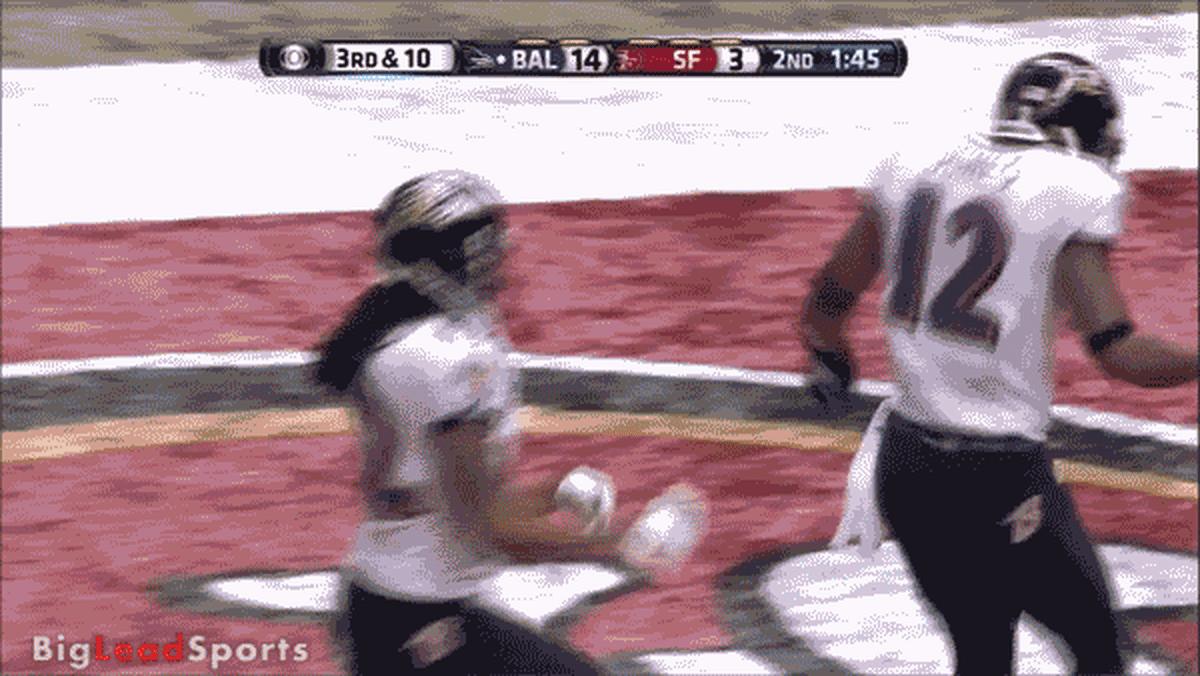Super Bowl Game-Changers: Past stars look back on biggest moments

Every Super Bowl offers us a few game-changing plays to collect and savor, with players who make their name in the NFL’s biggest game or leave their mark on pro football history.
• Deflategate: Complete coverage | Super Bowl XLIX: News, features
With Super Bowl XLIX between New England and Seattle looming next weekend in Phoenix, here are just a few of our favorite Super Bowl game-changers over the course of the game’s first 48 years, with a fond look back at the moments that helped make these players part of Super lore. By no means is our list exhaustive, but it is entertaining to go back and re-live some of the plays and moments that have made the Super Bowl the must-see event it is today.
We contacted every player on this list by phone, and got them to tell one more time how they did what they did on Super Sunday:
The Helmet Catch: David Tyree, Super Bowl XLII, N.Y. Giants 17, New England 14
Sometimes, to hear people talk about it seven years later, it’s almost as if David Tyree was a contest winner, plucked out of the stands and given the incredibly rare chance to catch a pass from an actual NFL quarterback, in the Super Bowl. That’s how bizarre and difficult to grasp it still remains to some, that the little-known Tyree was the hero of New York’s shocking 17-14 upset of undefeated New England that night in Glendale’s University of Phoenix Stadium.
From I to XLIX: Journalists who have covered every Super Bowl look back
Tyree was the epitome of a bit player. A special teams standout and reserve receiver on the 2007 Giants, he had endured a brutal week of practice, dropping passes and missing assignments. But when the fourth quarter beckoned, he answered, catching his first touchdown of the season from five yards out to put the Giants up 10-7 with 11:05 remaining, then pulling off the still-unexplainable feat that defines this Super Bowl: his remarkable 32-yard reception of an Eli Manning bomb on third-and-5 from the New York 44 with 59 seconds remaining, the grab that set up Manning’s game-winning 25-yard touchdown pass to Plaxico Burress four plays later. Tyree pinned the ball against his helmet with his right hand at one point in the fight to secure it, while Patriots safety Rodney Harrison climbed all over his back and the two fell to earth.
"I get it, and I’m just as befuddled sometimes as the next man," Tyree said last week. "I’m still living the dream and I recognize it was a gift from God, and so I steward it that way. But obviously that day I was on the field, and I like to believe I was a wide receiver in the National Football League. My quarterback was in trouble, and it was my job to come back to the quarterback, find some green grass and give him a chance to make a play. Sometimes because of the randomness of the play, and because I didn’t have the decorated career as a wide receiver, it’s almost like minimizing the play.
"But my teammates know what I did on that team, and on every team there are always guys who can be counted on. And I like to believe that I was always a guy that could be counted on, and that was the moment that overly and abundantly kind of illustrated who I was on that football team and what I represented to our success that season."
• 2015 NFL Mock Draft: Where does Jameis go? | Grading every coaching hire
Tyree remains humbled by his role in that dramatic upset of the 18-0 record-setting Patriots, but he doesn’t shy away from the label that his ridiculous helmet-catch has earned in subsequent years as the greatest play in Super Bowl history. No less an authority than former NFL Films president Steve Sabol dubbed it that, and Tyree’s catch goes hand in hand with Manning’s desperation escape job from the clutches of Patriots defenders Richard Seymour, Jarvis Green and Adalius Thomas, who seemingly had him wrapped up and in the grasp.
"I think it is," Tyree said when asked about the label. "When you consider the circumstances and the impact of that play. I think it’s the greatest play hands down, actually. If you want to debate whether it’s the greatest catch, then I guess you can put that up for debate. Obviously I’m a little partial there. But when it comes to the greatest play, because of everything involved with that play, and all that went with it, and all that was at stake, I don’t think that’s a debatable issue at all. I don’t think that’s ever going to happen again.’’
Tyree suffered a knee injury the following training camp and never caught another pass in the NFL, retiring after a brief stint with Baltimore in 2009. Today he’s the Giants' director of player development, but his place in franchise history is secure because of his improbable star turn on the night of Feb. 3, 2008 in Arizona.
"For me, it’s easy to not take full credit for that play," Tyree said. “A lot of people have heard my story of faith. I think it was a divinely appointed moment. I think it was a purpose-filled moment. I think it was a moment that was beyond my personal skills, that’s obvious. And yet it was obviously still a moment that I was grateful to be a part of, and I’m just fortunate to be the one who receives credit for it.’’
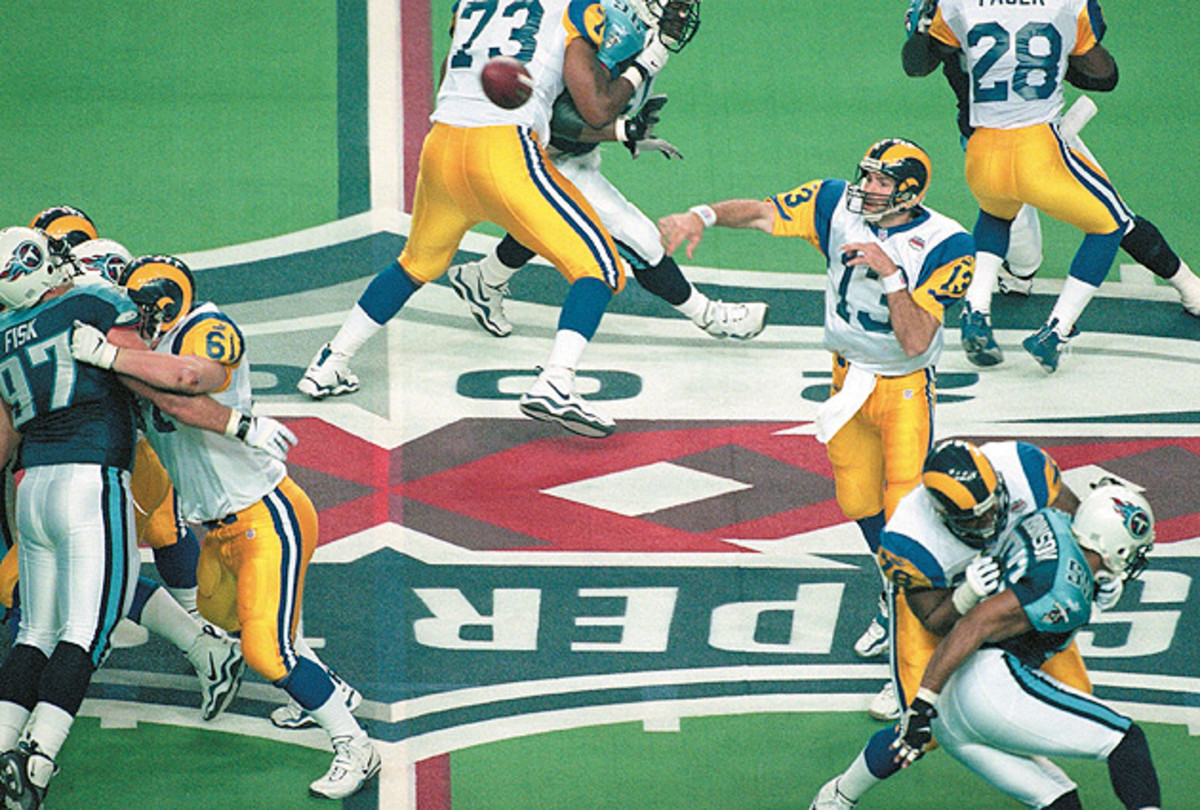
The Bomb: Kurt Warner, Super Bowl XXXIV, St. Louis 23, Tennessee 16
Fifteen years later, Kurt Warner wants to know if Jevon Kearse is in the equation or not. When asked how many times out of 100 he would successfully hit the 73-yard scoring bomb to Isaac Bruce that won Super Bowl XXXIV for the St. Louis Rams in the game’s final two minutes, Warner, being ever a quarterback, wants to know if Tennessee’s then-rookie standout pass-rusher is being factored into this particular hypothetical. It was Kearse, after all, who steamed in on Warner on the play, forcing the Rams’ quarterback to slightly hurry his pass and knocking him to the ground.
"We’re pretty confident guys, me and Isaac, so I think if you take Jevon Kearse out of the mix, I think we hit it better than 50 percent of the time," Warner said last week. "Add Jevon Kearse to the mix and I think that goes down quite a bit. Who knows, maybe 10-12 times out of 100 times if we throw that it’d be the exact same scenario it was that game."
2015 Super Bowl Squares: Patriots vs. Seahawks printable template
The call was Twins Right, Ace Right, 999 H Balloon, and Rams fans should probably have that tattooed somewhere on their bodies. St. Louis had squandered a 16-0 lead, with the Titans storming back to tie the game at 16-16 and seizing the momentum in the raucous Georgia Dome in Atlanta. But Warner and the Rams refused to back down, and on the first play after the Titans tied the game, the call came in for a deep sideline pattern to Bruce, the team’s big-play receiver. Only 2:05 remained in regulation, and overtime looked probable.
"Our mentality was not let’s just get this thing to overtime," Warner said. "It was let’s win this thing. That was always our mentality with [head coach] Dick Vermeil and [offensive coordinator] Mike Martz, and I have never thought there was any other option based on the way ’99 played out and the aggressiveness we had in every scenario. We were attacking in every situation. So it wasn’t going to be any different even though there was two minutes to go in a Super Bowl that was tied. When I stepped on the field after the TV timeout, we were going after this thing and we’re going to try and win it now.
Because of Kearse applying pressure, Warner didn’t get to fully step into the pass and follow through, and Vermeil and Martz both thought the ball was going to be underthrown because of it. It was, slightly, but Bruce made a beautiful adjustment on the ball without tipping off Titans cornerback Denard Walker, breaking back inside of the defender to gather in the ball and outrace everyone to the end zone at the 1:54 mark. Warner saw the pandemonium on the Rams sideline, but he couldn’t make out Bruce too clearly, given that his view was partially obstructed from the turf.
"I just heard the reaction, and I didn’t see him make the catch," Warner said. "Then I was able to kind of see him running from where I was, so I knew he had caught it and was making some moves. But it was more just hearing the reaction and knowing he had weaved his way into the end zone."
The Rams and Warner, of course, weren’t quite home free just yet. The Titans drove the ball deep into St. Louis territory, and Rams linebacker Mike Jones had to tackle Tennessee receiver Kevin Dyson at the one-yard line to preserve the thrilling victory as time expired. But that Warner-to-Bruce scoring bomb had provided the difference, and ended a magical season in St. Louis for the out-of-nowhere Rams, with their “Greatest Show on Turf’’ offense.
"Before that drive, Dick [Vermeil] had said to me the same thing I was thinking on the sideline before I took the field on that final drive," Warner said. "He said this is exactly how you draw it up. It couldn’t be more perfect of a scenario based on how many times you played out this moment in your front yard when you were a kid. It just kind of matched up with how everything else went that year for us. He just said this is how it should finish. This is what it should be. Now we need to go out and finish this thing. It’s just a perfect ending to a perfect season."
GALLERY: SI's 100 best Super Bowl photos
SI's 100 Best Super Bowl Photos
Super Bowl XLII, Feb. 3, 2008
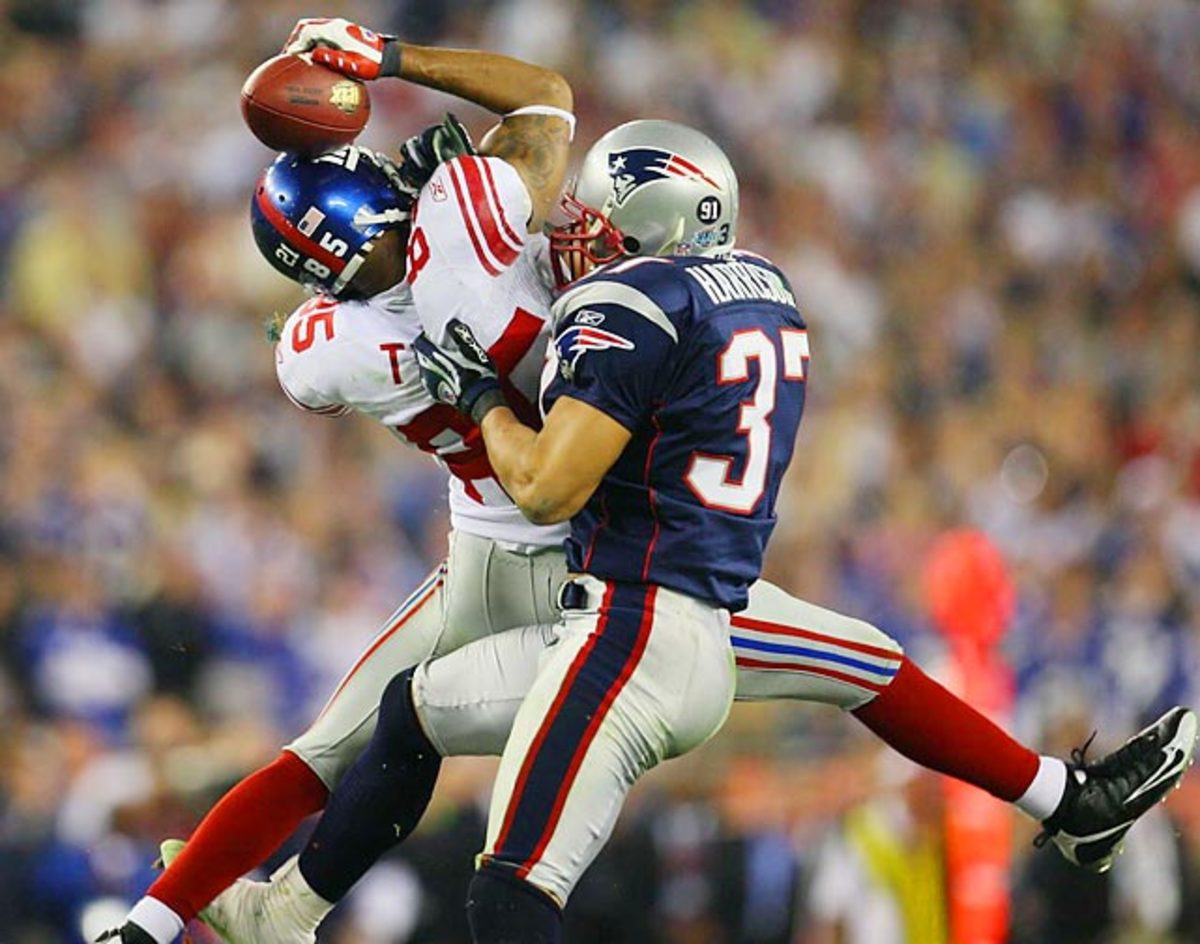
New York Giants wide receiver David Tyree somehow manages to hang on to the catch by pinning the ball against his helmet as New England Patriots safety Rodney Harrison hits him late in the fourth quarter. Tyree also caught a touchdown pass earlier in the fourth quarter that helped the Giants to their 17-14 victory.
Super Bowl II, Jan. 14, 1968
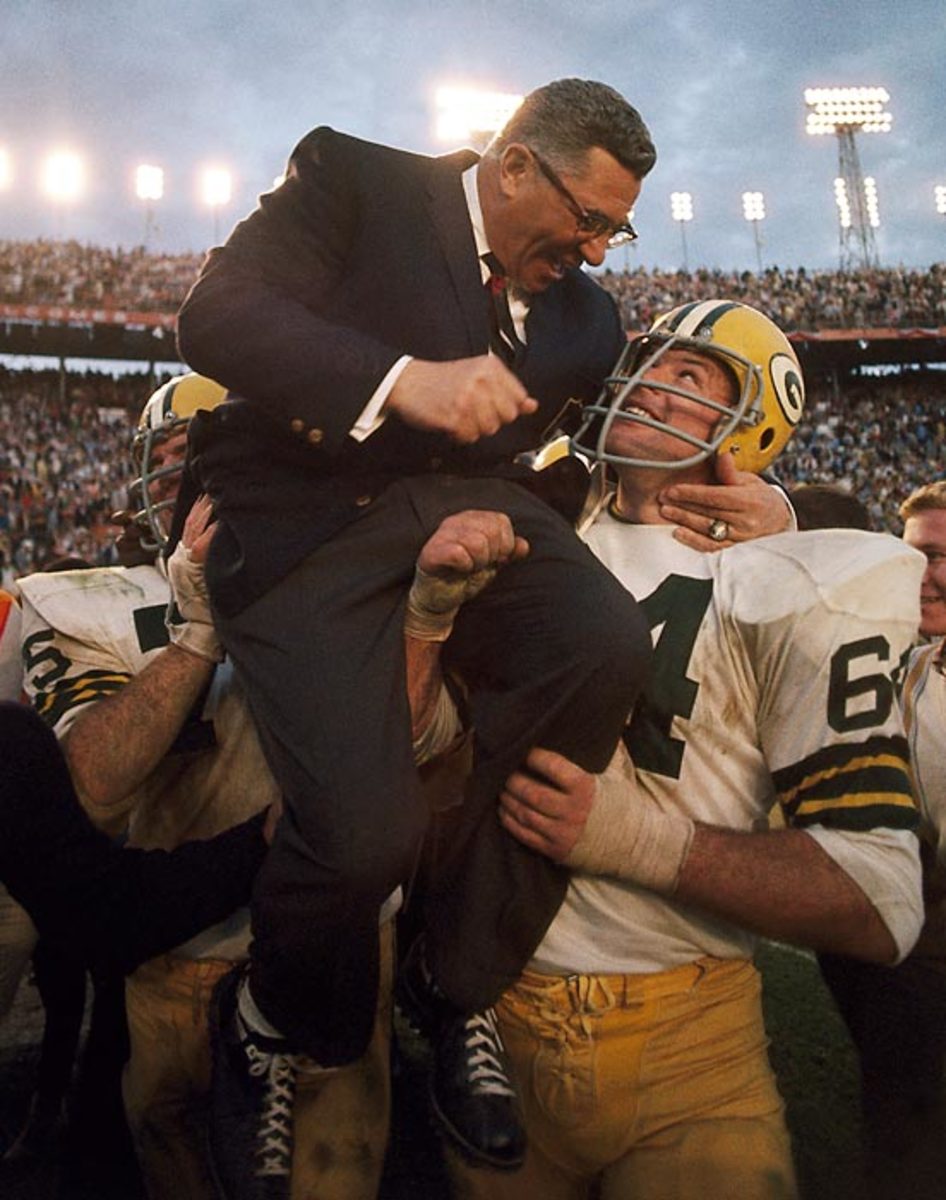
SI's photographers have shot every Super Bowl in history, leading to this collection of their best shots -- with at least one picture from every game. Jerry Kramer and Forrest Gregg carry head coach Vince Lombardi off the field after the Packers' 33-14 win over the Oakland Raiders. The victory, Green Bay's second straight Super Bowl triumph, was Lombardi's final game as the Packers' coach.
Super Bowl XIII, Jan. 21, 1979
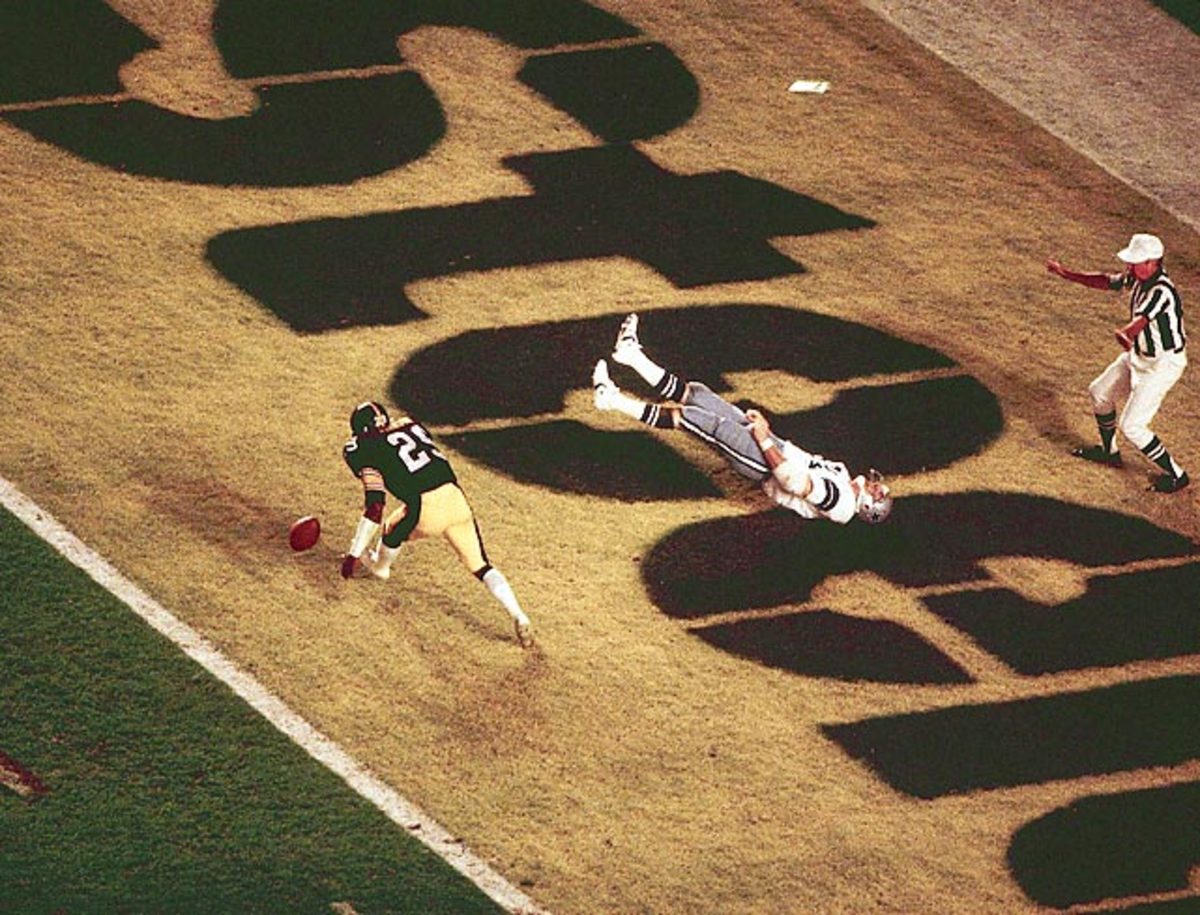
Jackie Smith flops in the end zone after dropping what would have been a game-tying touchdown. Dallas had to settle for a field goal en route to losing 35-31.
Super Bowl XXXIV, Jan. 30, 2000
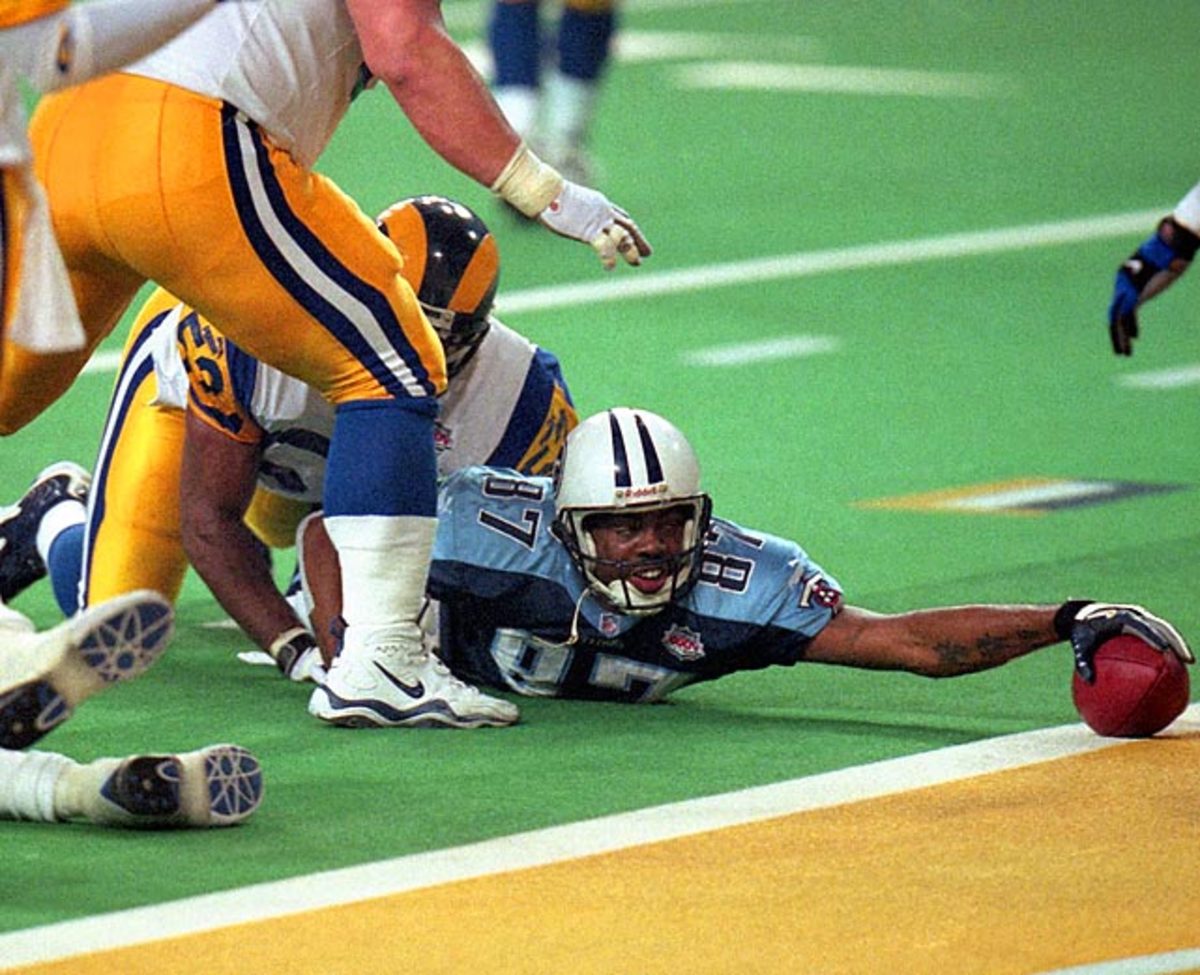
Tennessee Titans wide receiver Kevin Dyson was already down at the one before he stretched the ball into the end zone on the final play of a game that his team lost 23-16. At the 10-yard line with six seconds remaining, the Titans tried to reach the end zone, but St. Louis linebacker Mike Jones' tackle kept Dyson short.
Super Bowl XXIV, Jan. 28, 1990
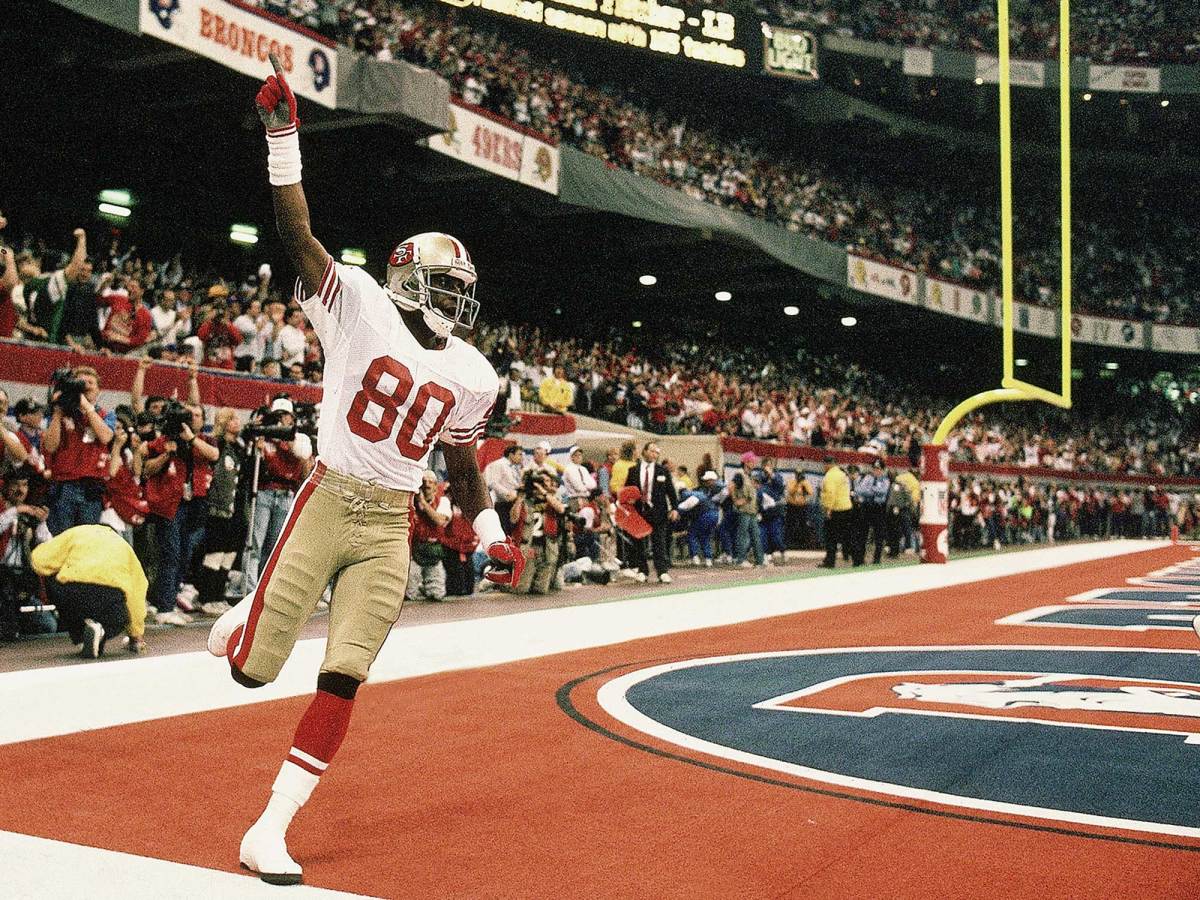
San Francisco 49ers receiver Jerry Rice celebrates a touchdown catch against the Denver Broncos. San Francisco steamrolled Denver in the Louisiana Superdome, 55-10.
Super Bowl X, Jan. 18, 1976
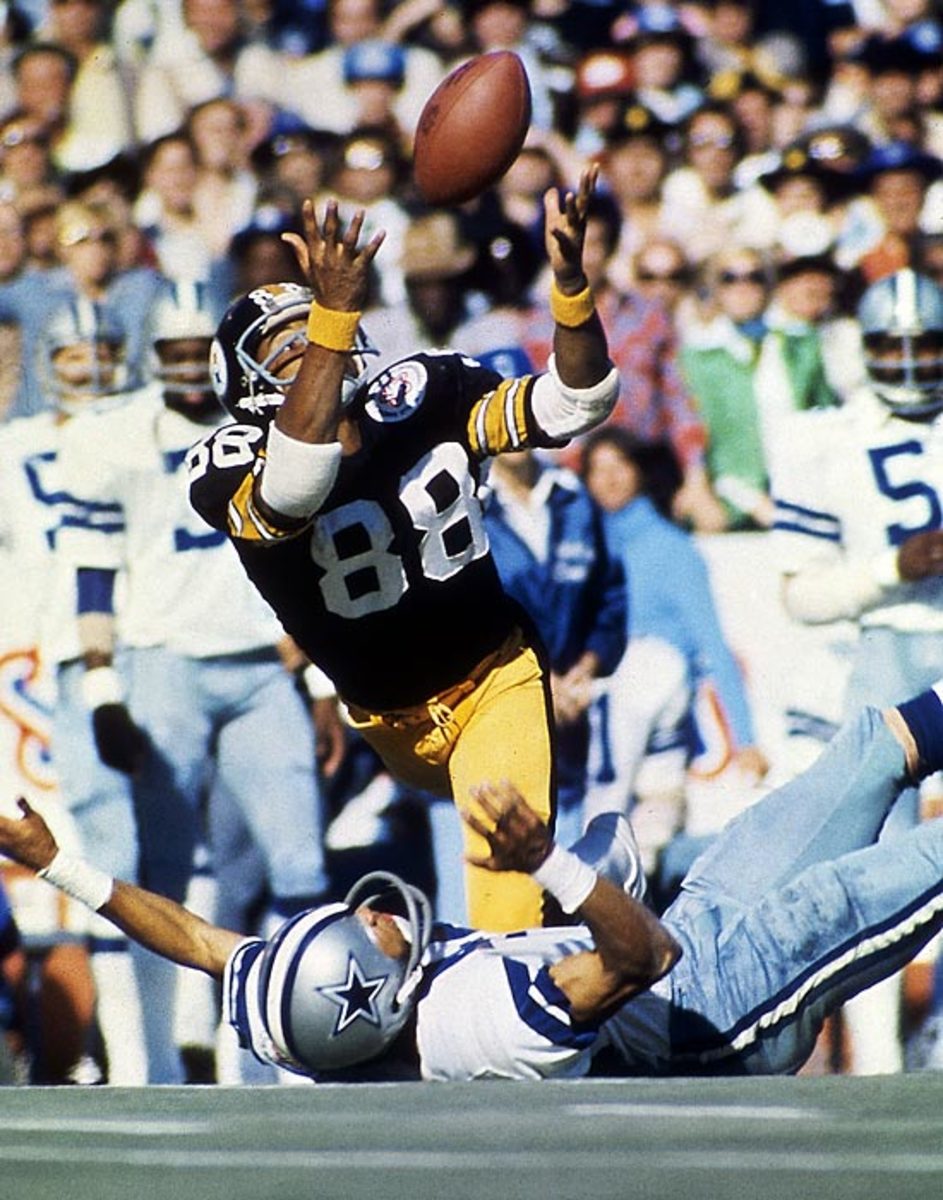
Lynn Swann makes a diving catch over the Dallas Cowboys' Mark Washington. The Steelers wide receiver was named Super Bowl MVP after catching four balls for 161 yards and a touchdown in Pittsburgh's 21-17 win over the Cowboys.
Super Bowl XXIII, Jan. 22, 1989
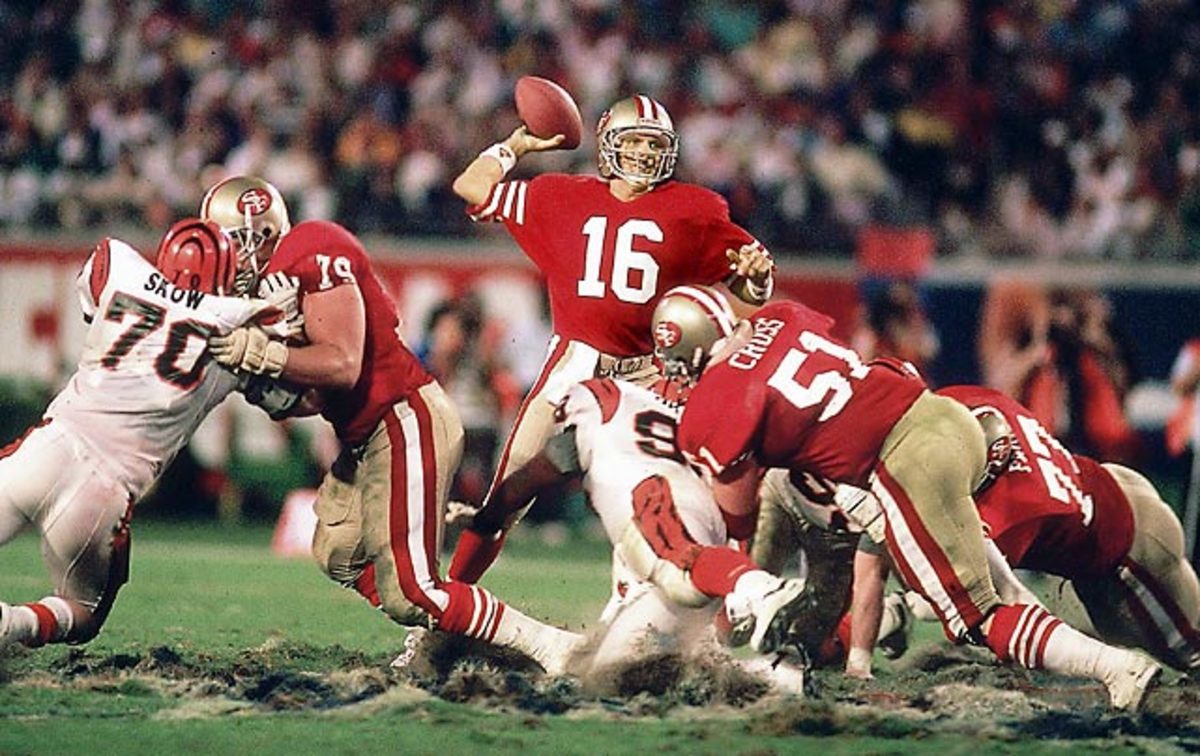
As the Cincinnati Bengals defensive line trudges through the mud to get to him, Joe Montana reaches back to pass. The San Francisco 49ers quarterback threw for 357 yards and two touchdowns, including a game-winning throw to John Taylor with 34 seconds remaining to cap off a 92-yard drive and a 20-16 win.
Super Bowl XX, Jan. 26, 1986
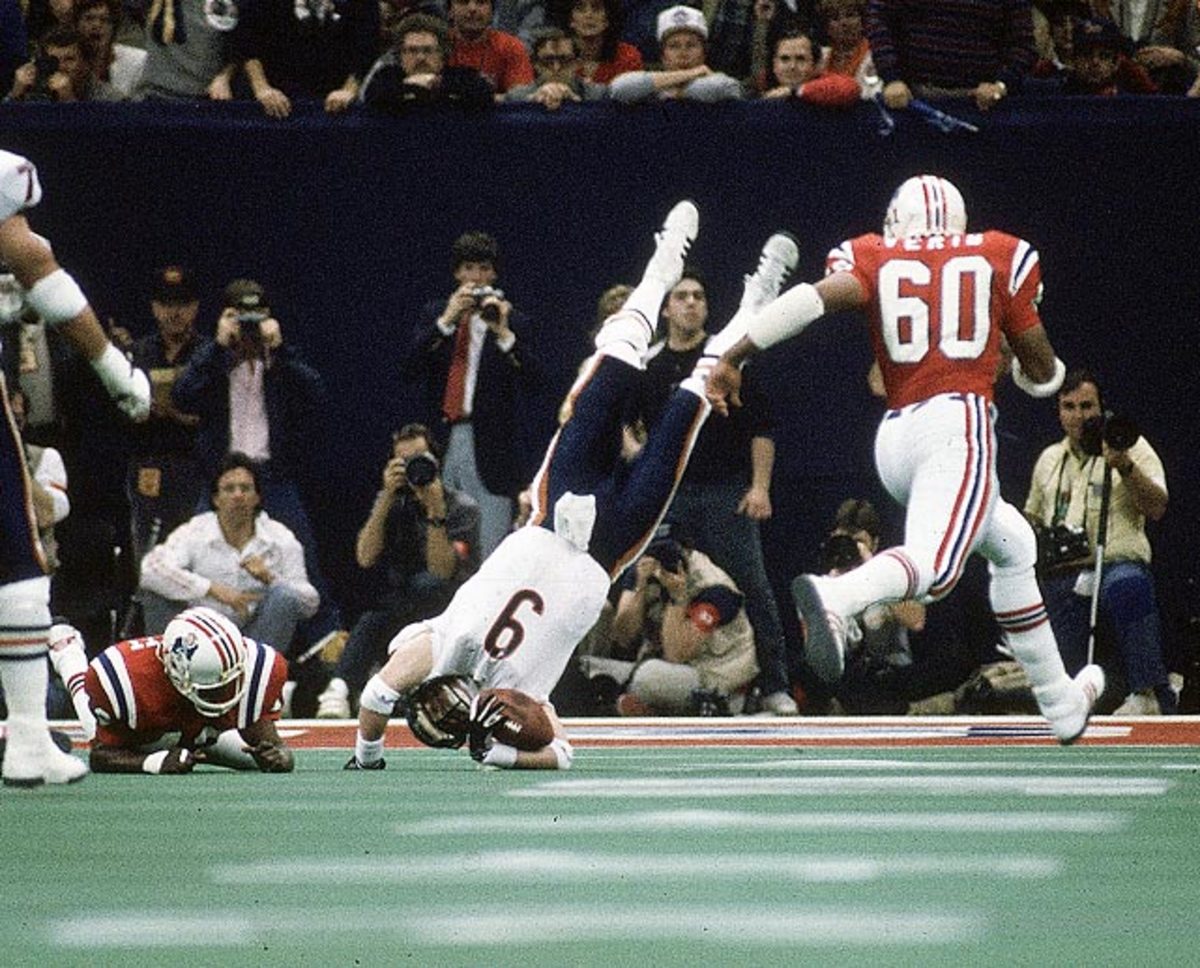
Chicago Bears quarterback Jim McMahon is upended on a scramble by the New England Patriots defense. McMahon became the first quarterback to rush for two touchdowns in a Super Bowl; he threw for 256 yards in the 46-10 rout.
Super Bowl XLIII, Feb. 1, 2009
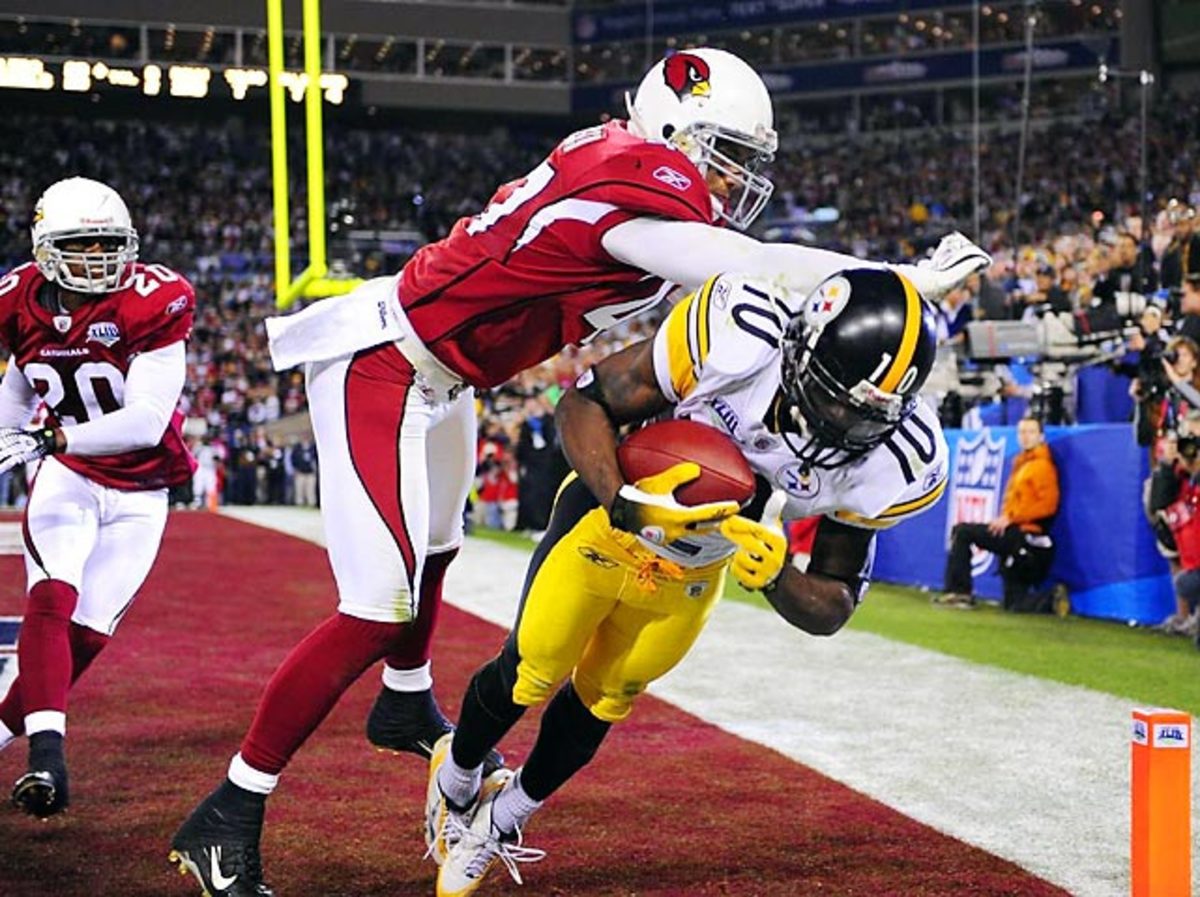
Pittsburgh Steelers wide receiver Santonio Holmes gets both feet down in the back right corner of the end zone to score a game-winning touchdown as safety Aaron Francisco attempts to push him out of bounds. After Arizona had scored 16 consecutive points in the second half to take a 23-20 lead, Holmes pulled in this Ben Roethlisberger pass with 35 seconds left to lift the Steelers to the 27-23 win.
Super Bowl XXV, Jan. 27, 1991
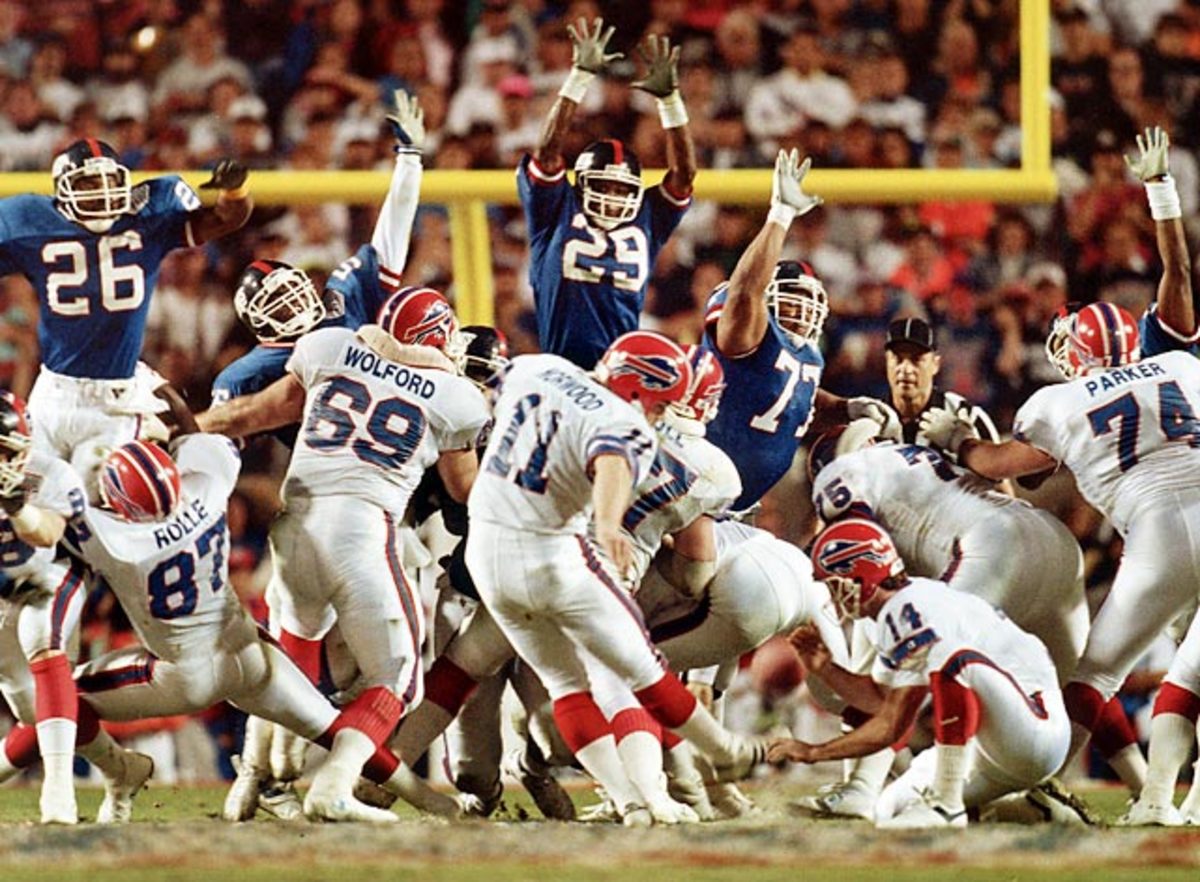
Buffalo Bills kicker Scott Norwood sends his game-winning field goal attempt wide right, securing the New York Giants' 20-19 victory.
Super Bowl XXXI, Jan. 26, 1997
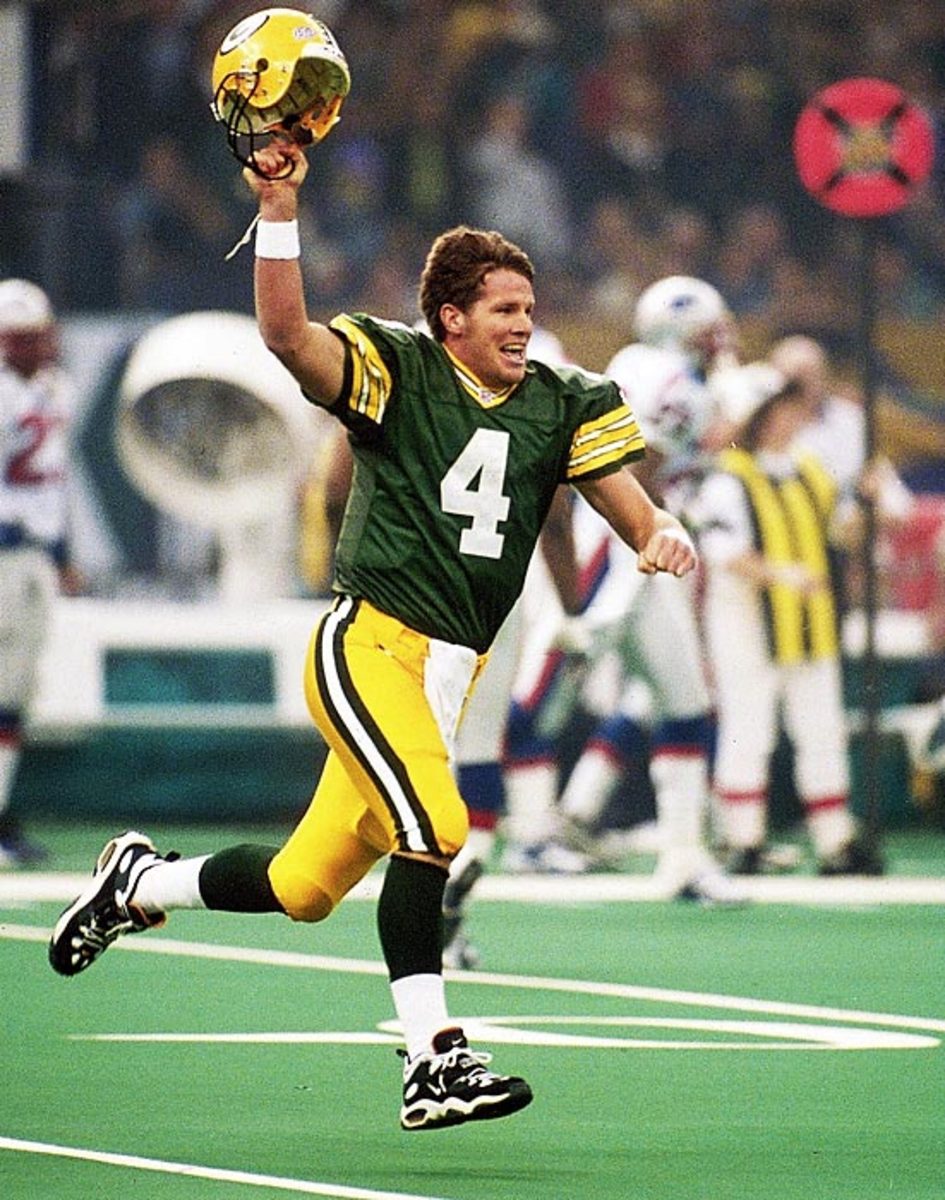
Brett Favre raises his helmet in celebration after throwing a 54-yard touchdown pass to wide receiver Andre Rison in the first quarter. The Green Bay Packers quarterback completed 14 of 27 passes for 246 yards and two touchdowns while rushing for another touchdown in the 35-21 triumph.
Super Bowl XVI, Jan. 24, 1982
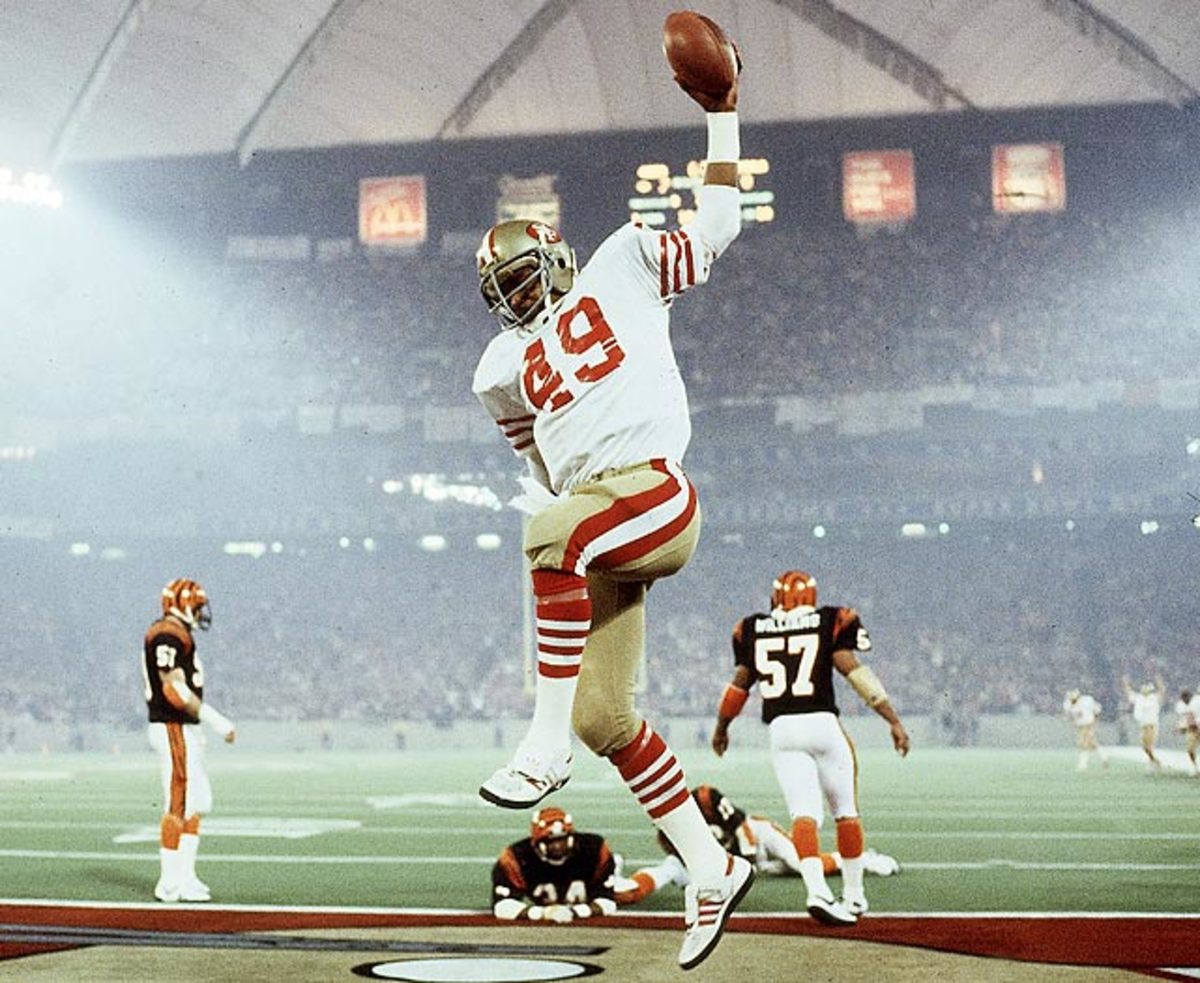
Fullback Earl Cooper celebrates after scoring a 10-yard receiving touchdown in the second quarter while Cincinnati Bengals cornerback Lewis Breeden looks on from the ground. Cooper's touchdown gave the San Francisco 49ers a 14-0 lead as they went on to win 26-21.
Super Bowl XXXVI, Feb. 3, 2002
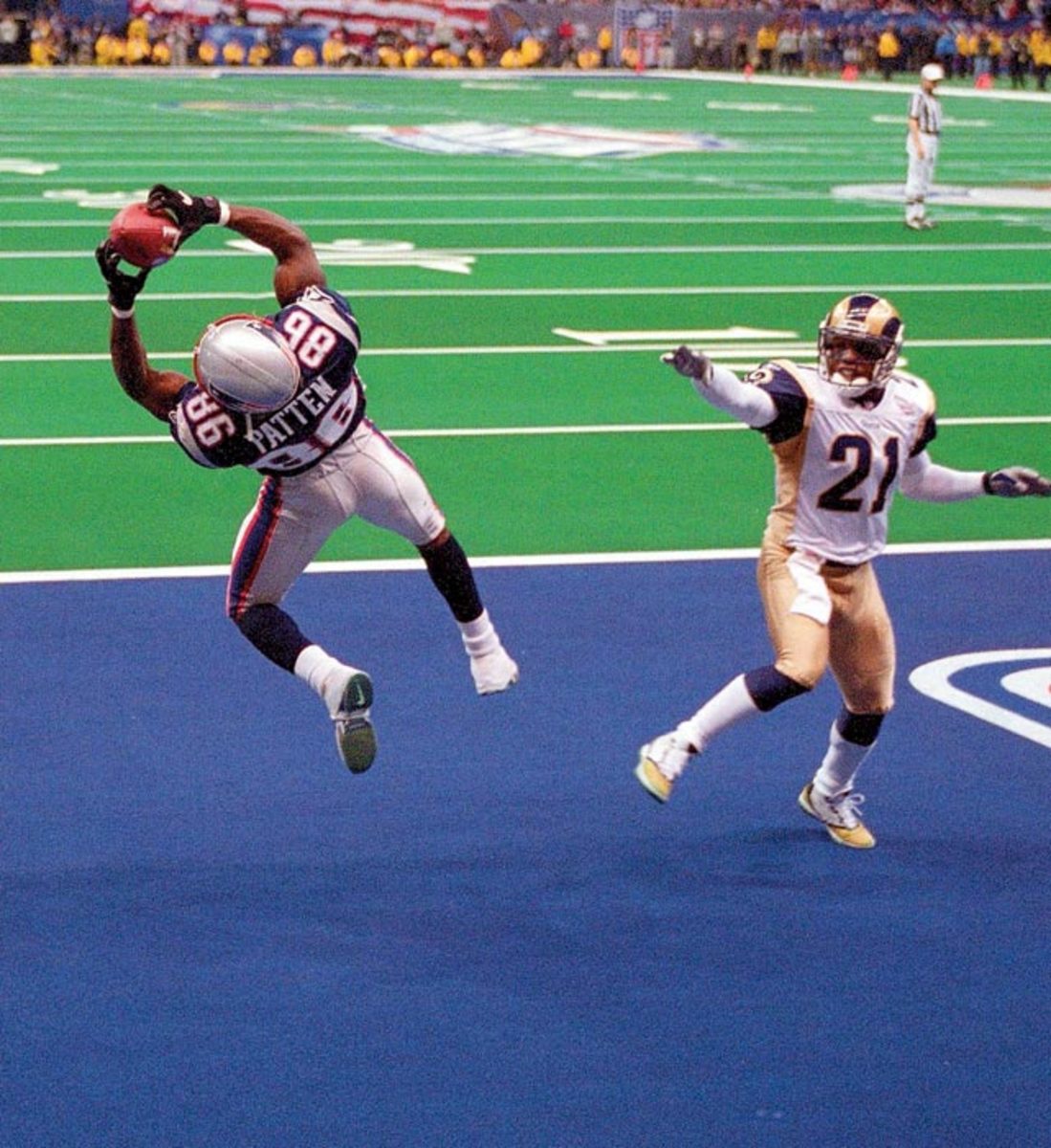
New England Patriots wide receiver David Patten makes an acrobatic catch for a touchdown in the second quarter. The catch gave the Patriots a 14-3 lead at halftime; they won 20-17.
Super Bowl XI, Jan. 9, 1977
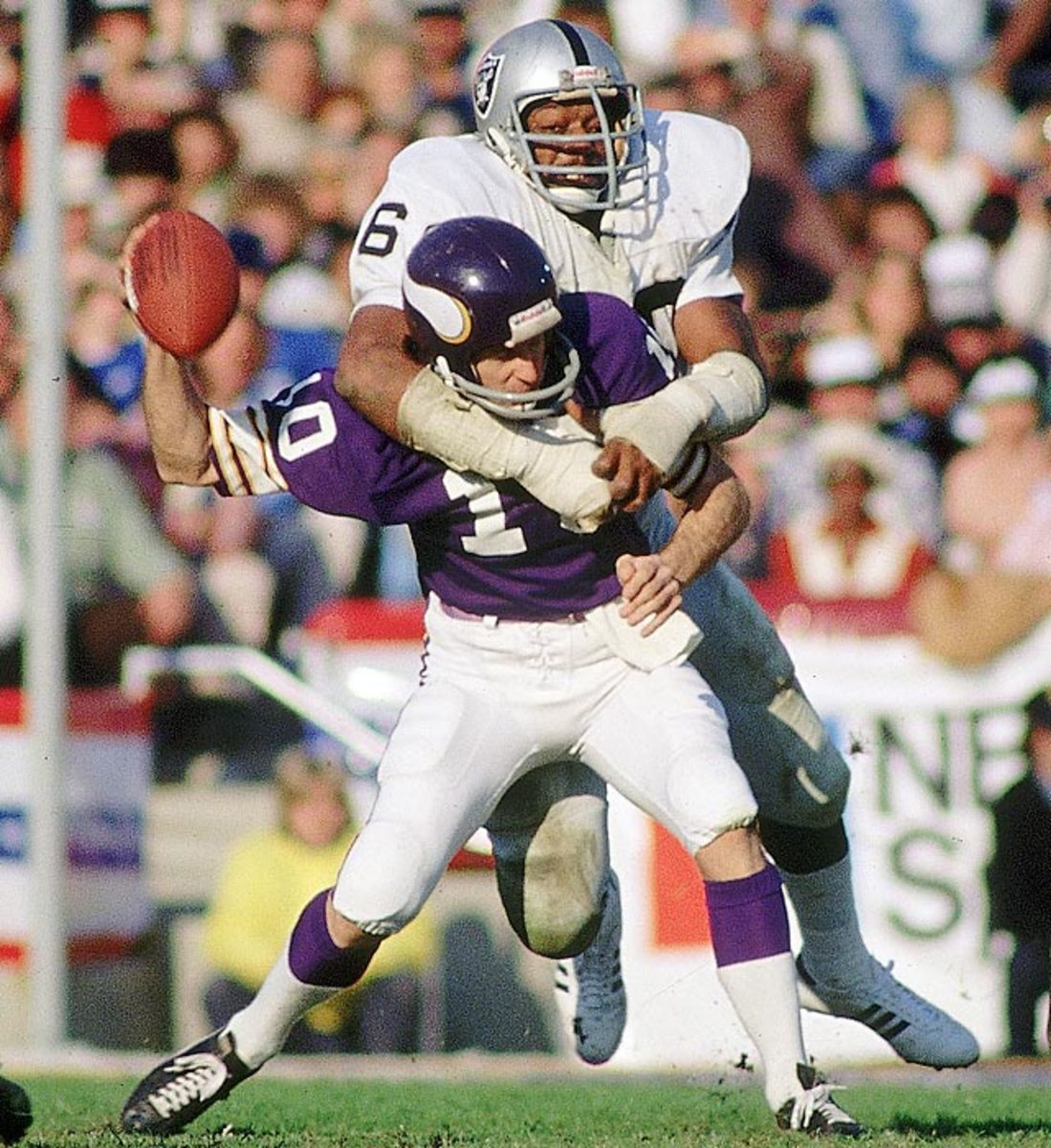
Oakland Raiders defensive end Otis Sistrunk sacks Fran Tarkenton, forcing the Minnesota Vikings quarterback to fumble. Oakland's offense had a field day with the Vikings, setting a Super Bowl record with 429 yards of offense in the 32-14 win.
Super Bowl X, Jan. 18, 1976

An upset Tom Landry shows some uncharacteristic emotion on the sideline. Landry's Cowboys were the first wildcard team to reach the Super Bowl, beating the Minnesota Vikings on a late Hail Mary and destroying the Los Angeles Rams 37-7 in the NFC Championship Game. They lost to the Steelers in this Super Bowl, 21-17.
Super Bowl XLVI, Feb. 5, 2012
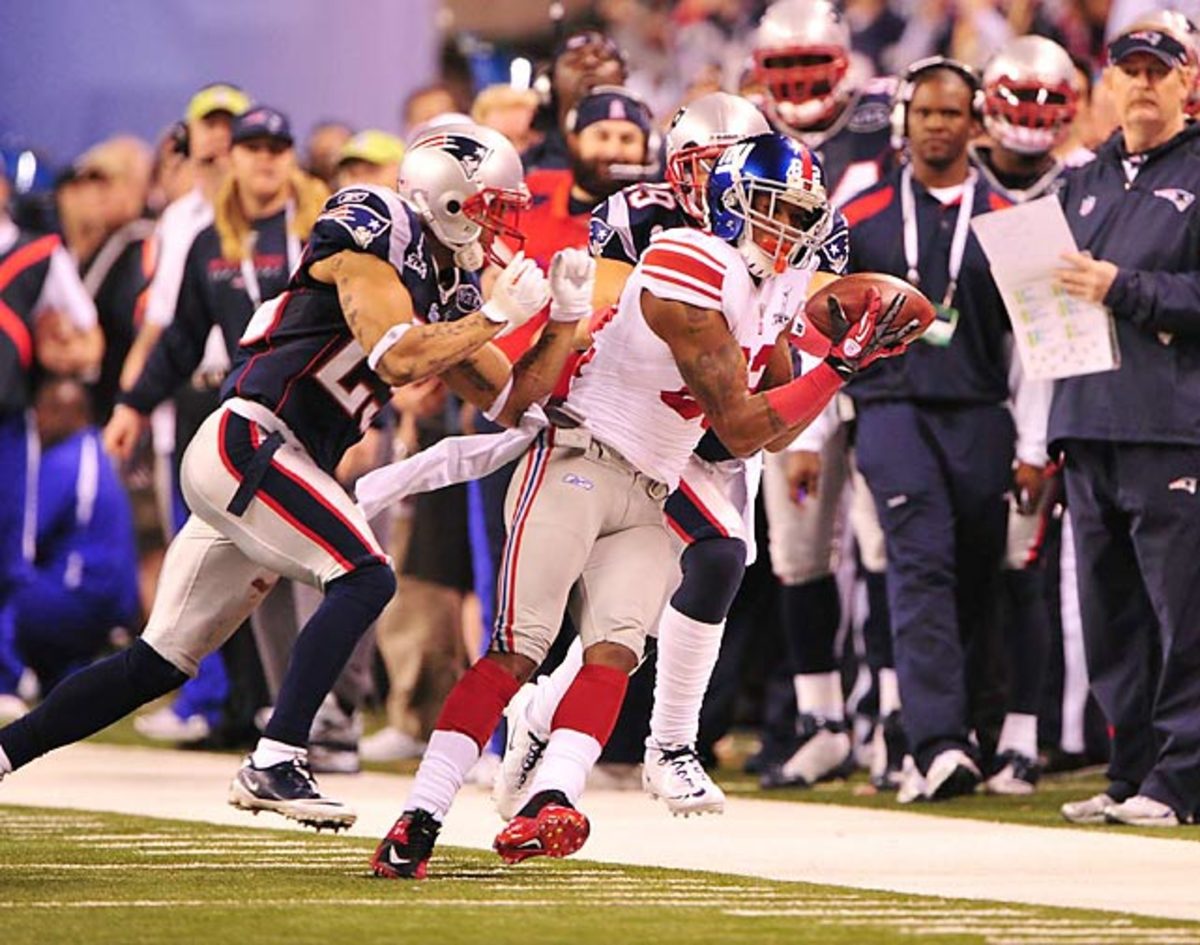
Wide receiver Mario Manningham barely gets both feet down in bounds on a 38-yard reception that set up the New York Giants' game-winner in a 21-17 game. Manningham caught five passes for 73 yards against the Patriots.
Super Bowl XLIV, Feb. 7, 2010
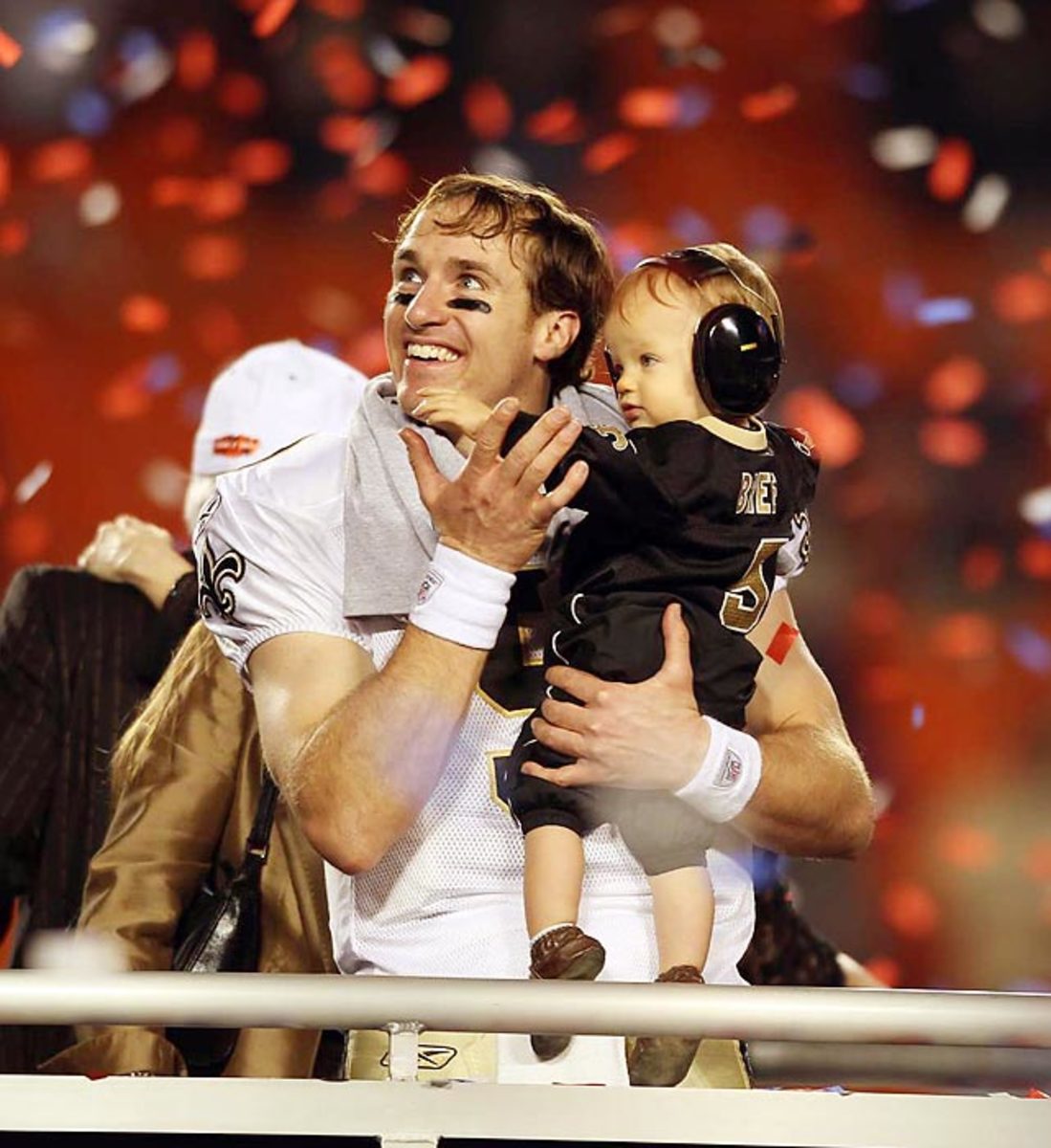
New Orleans Saints quarterback Drew Brees holds his son Baylen after the Saints' 31-17 win over the Indianapolis Colts. The victory was the first Super Bowl title for New Orleans and came just four years after Hurricane Katrina decimated the city and forced the Saints out of the Superdome for a year.
Super Bowl XIX, Jan. 20, 1985
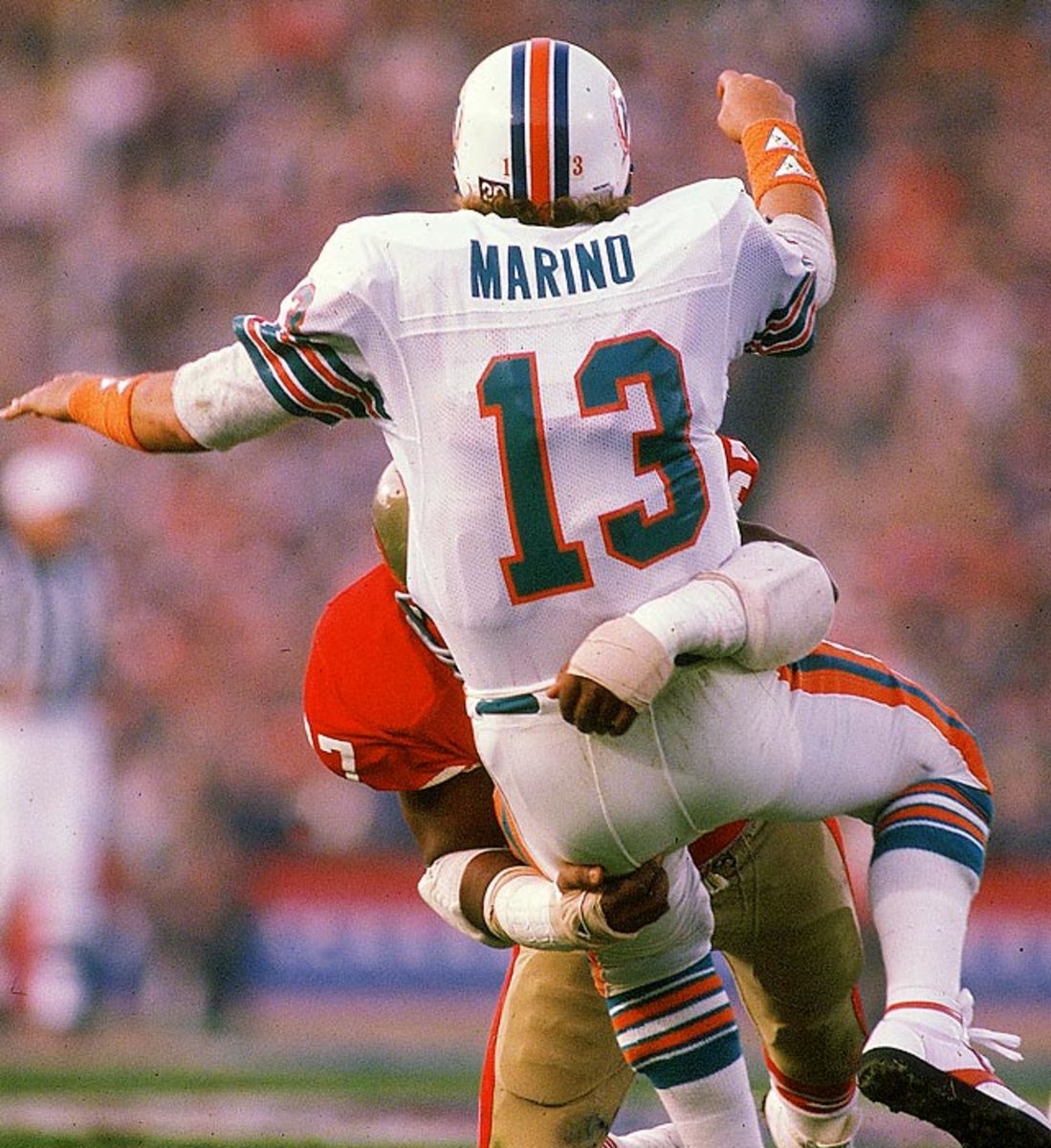
Dan Marino absorbs a big hit from San Francisco 49ers defensive tackle Gary Johnson. Marino completed 29 of 50 passes for 318 yards and a touchdown but his Miami Dolphins fell 38-16.
Super Bowl I, Jan. 15, 1967
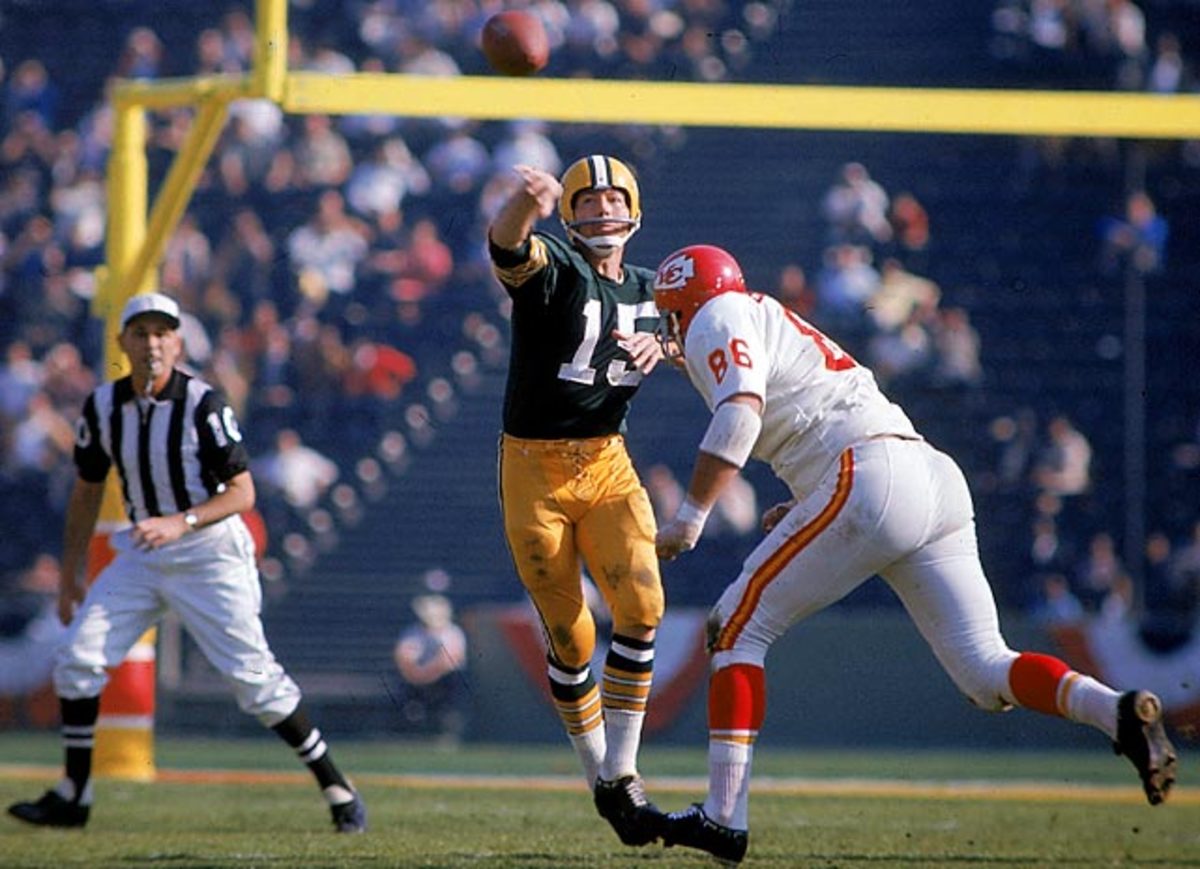
Super Bowl I, Jan. 15, 1967 Green Bay Packers quarterback Bart Starr lofts a pass in the first meeting of AFL and NFL champions, played Jan. 15, 1967. Starr's 250 yards passing and two touchdowns earned him Super Bowl MVP.
Super Bowl XXXIII, Jan. 31, 1999
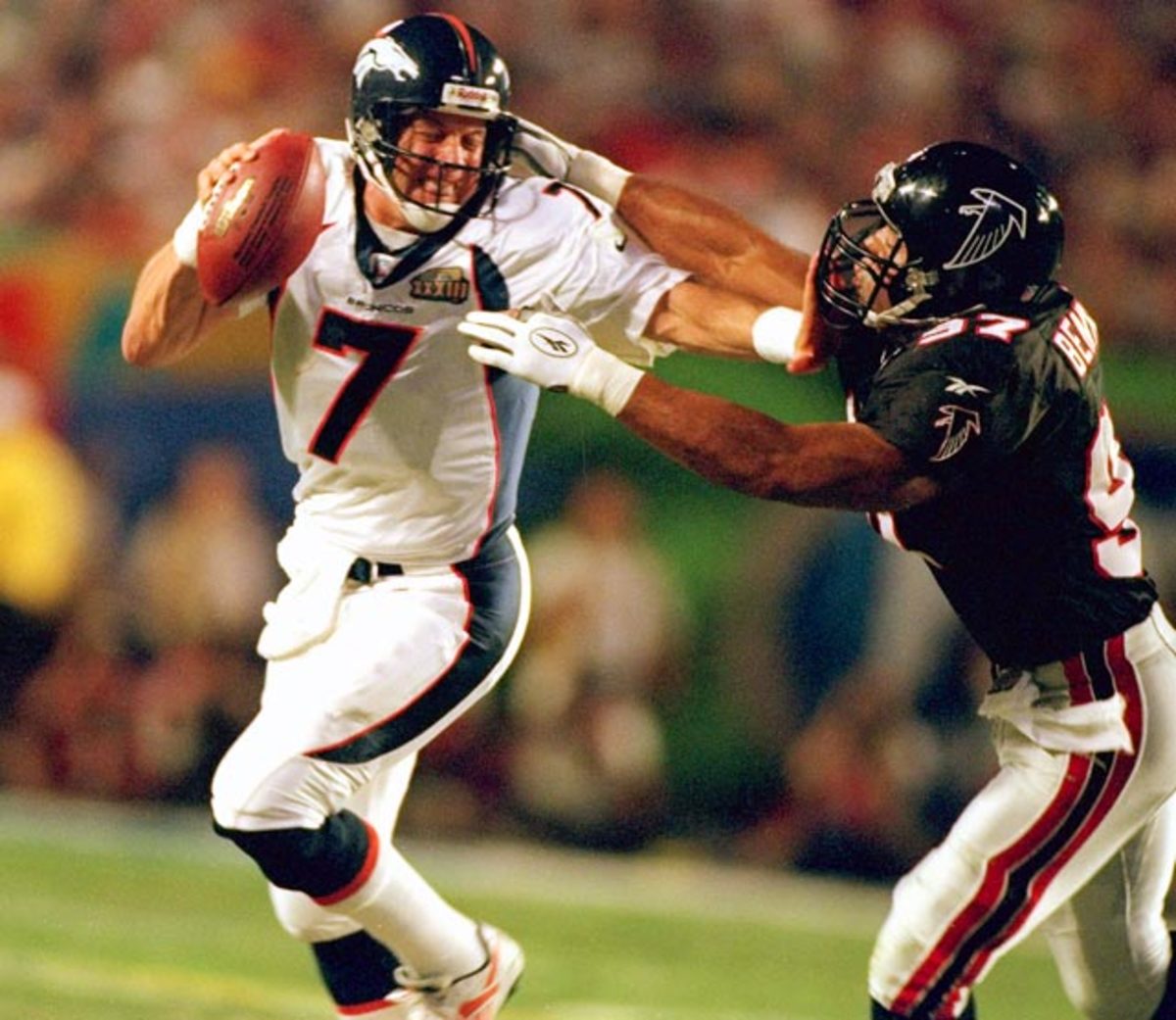
Denver Broncos quarterback John Elway stiff arms an Atlanta Falcons defender on a scramble. The 38-year-old Elway became the oldest player to be named Super Bowl MVP, throwing for 336 yards and a touchdown and rushing for another score in Denver's 34-19 win, the final game of Elway's career.
Super Bowl XXXVIII, Feb. 1, 2004
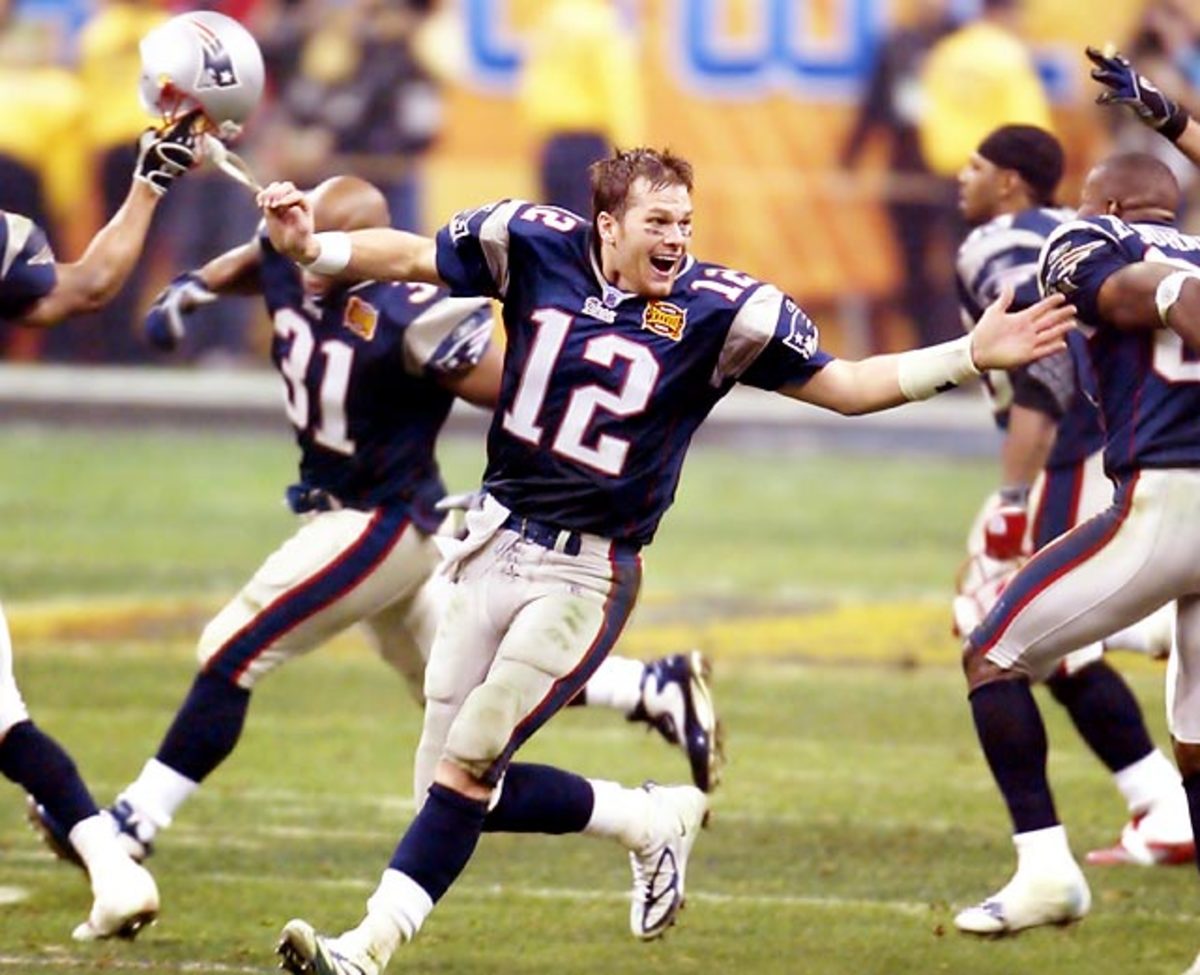
Tom Brady and the New England Patriots rush the field after defeating the Carolina Panthers. Kicker Adam Vinatieri nailed a 41-yard field goal with four seconds remaining to put the Patriots on top 32-29.
Super Bowl XV, Jan. 25, 1981
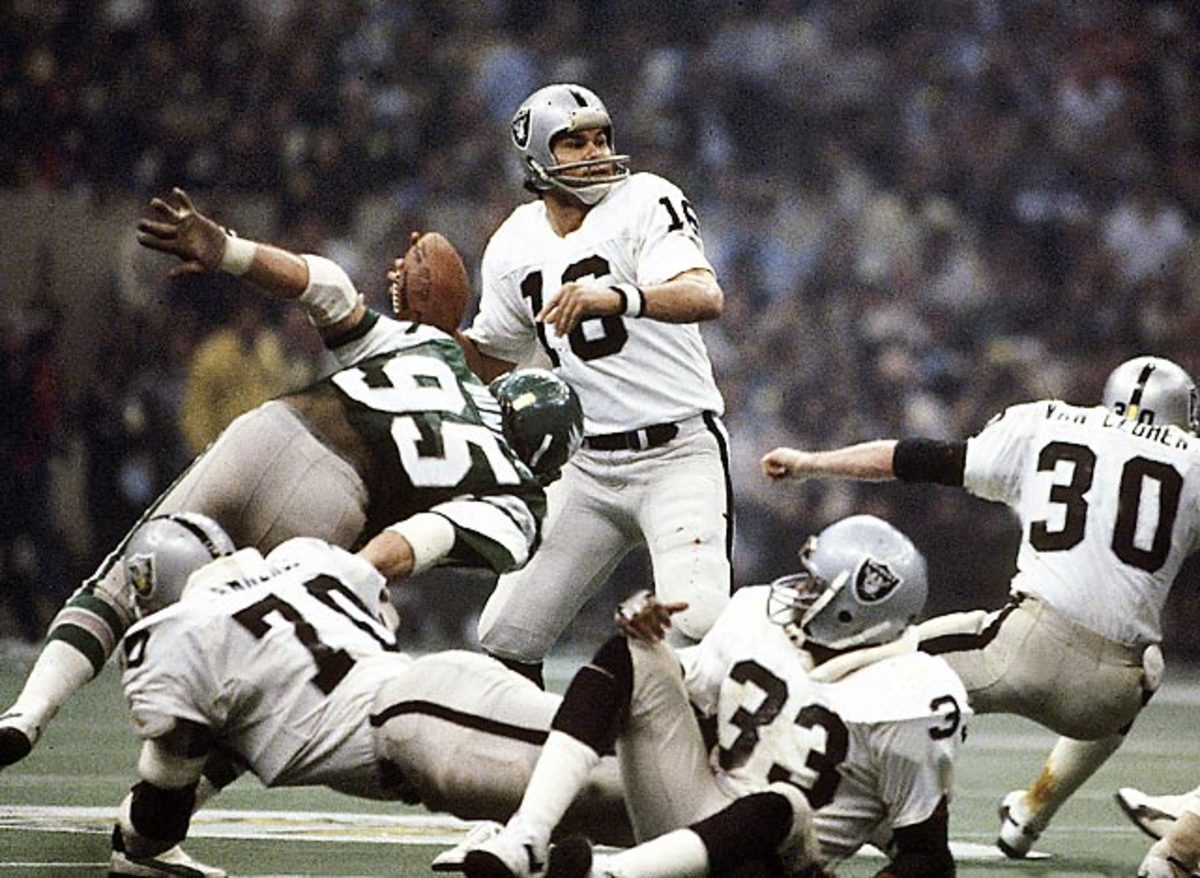
Super Bowl MVP Jim Plunkett looks to pass against the Philadelphia Eagles. Plunkett threw for 261 yards on 13-of-21 passing with three touchdowns to guide the Oakland Raiders to a 27-10 victory.
Super Bowl XII, Jan. 15, 1978
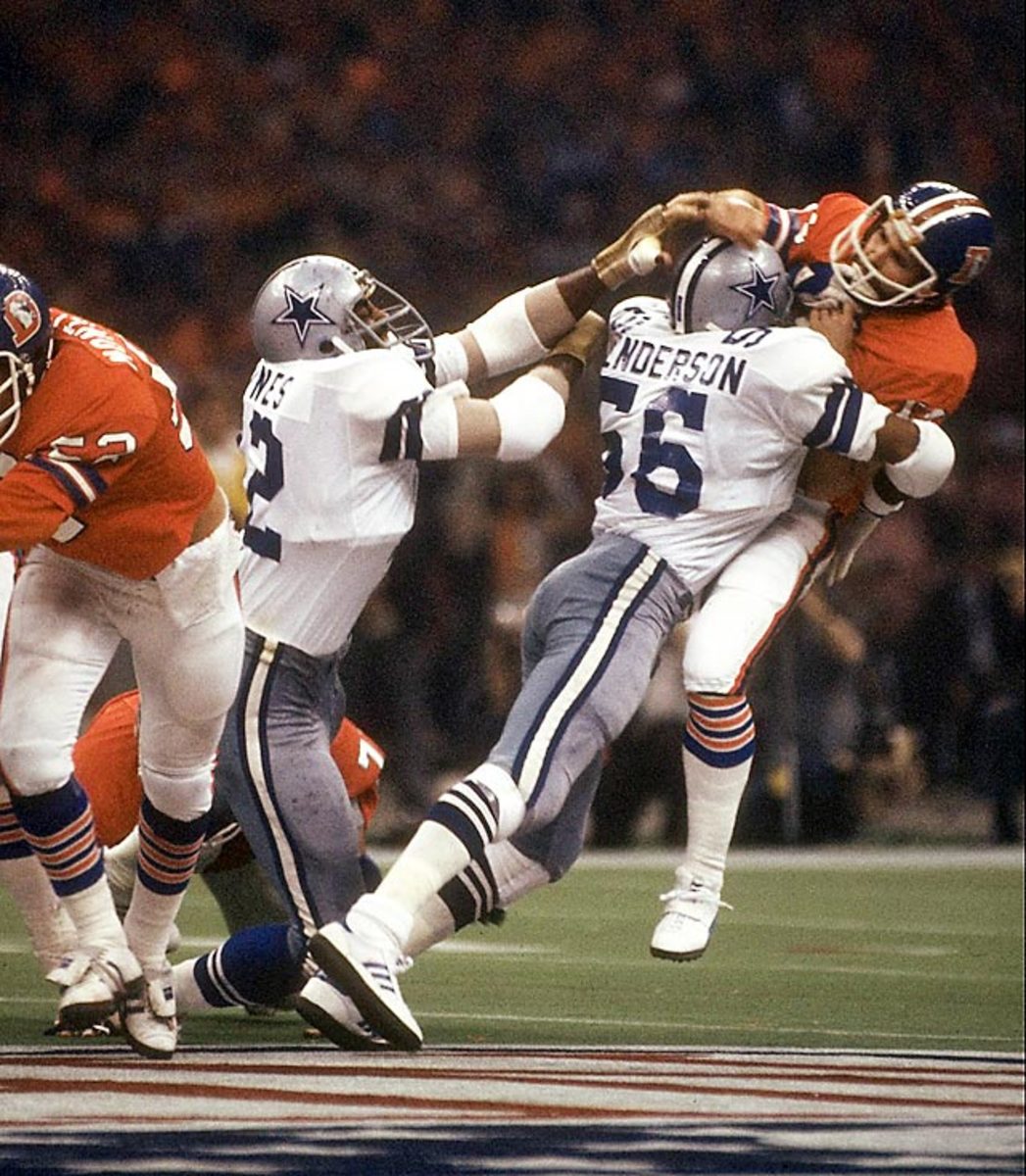
Dallas Cowboys linebacker Thomas Henderson drives Denver Broncos quarterback Norris Weese to the turf. The Cowboys defense ruled the day in New Orleans, forcing eight turnovers and allowing just eight pass completions as Dallas defeated Denver 27-10.
Super Bowl XXXVI, Feb. 3, 2002

Kicker Adam Vinatieri knocks through a game-winning field as the Patriots stun the St. Louis Rams 20-17. Vinatieri's 48-yarder as time expired came after quarterback Tom Brady led the Patriots down the field with 1:30 left and no timeouts.
Super Bowl XXXV, Jan. 28, 2001
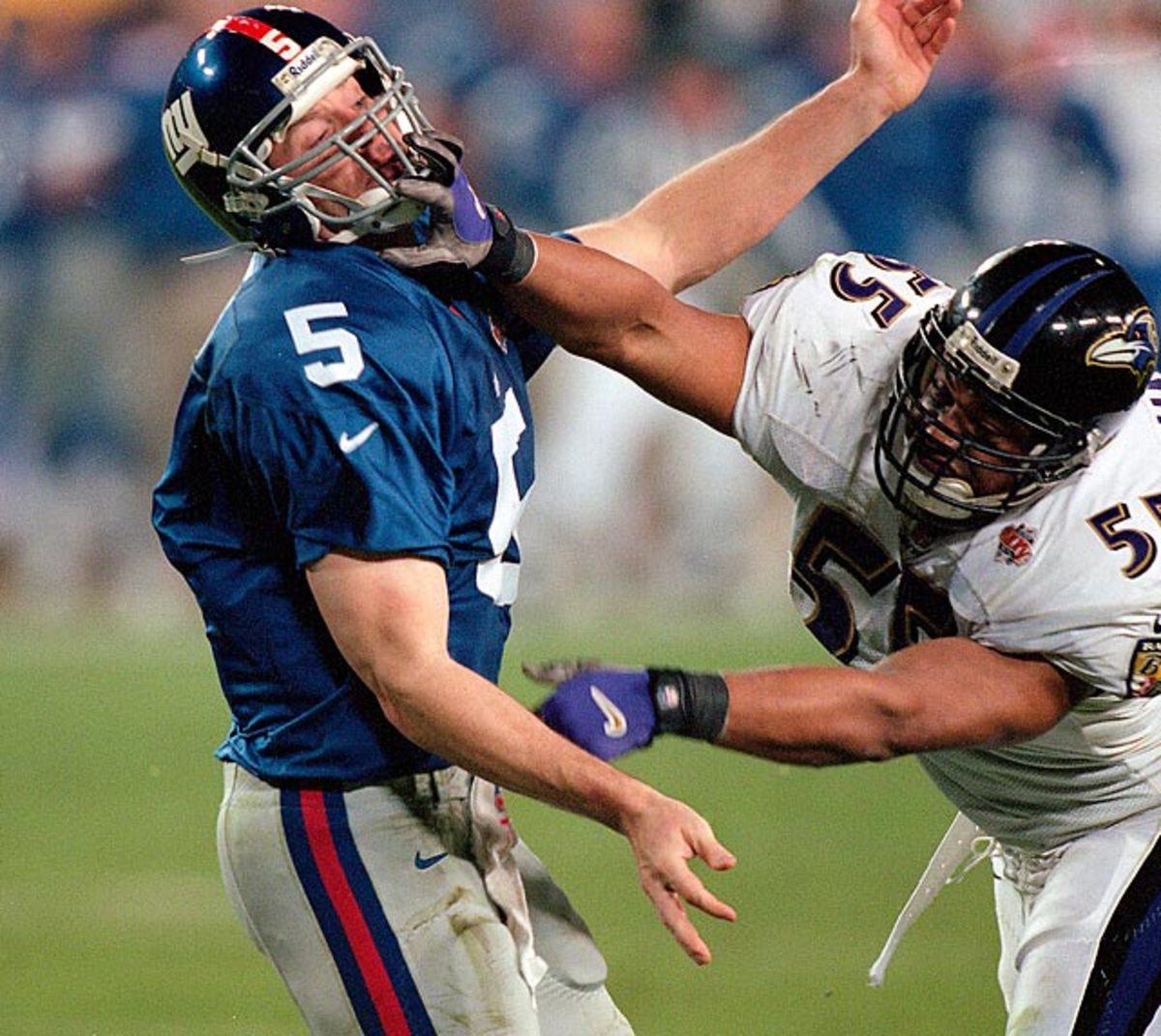
Baltimore Ravens linebacker Jamie Sharper grabs the facemask of New York Giants quarterback Kerry Collins in the fourth quarter. The Ravens defense badgered the Giants all game, recording four sacks and forcing five turnovers to pace a 34-7 victory.
Super Bowl XXII, Jan. 31, 1988
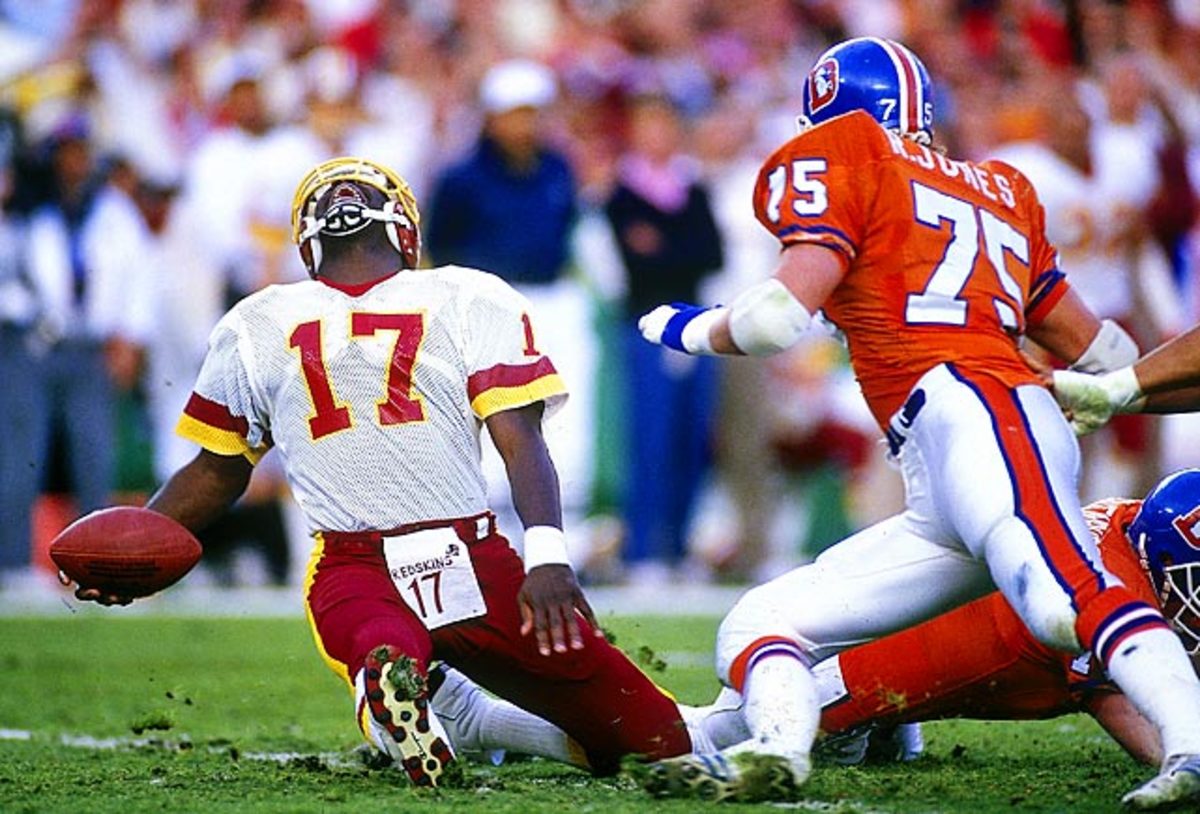
Washington Redskins quarterback Doug Williams twists his leg late in the first quarter, forcing him the leave the game with the Denver Broncos up 10-0. Williams returned to throw for 340 yards and four touchdowns as the Redskins easily defeated the Broncos 42-10. Williams was the first black quarterback to play in the Super Bowl.
Super Bowl XLI, Feb. 4, 2007
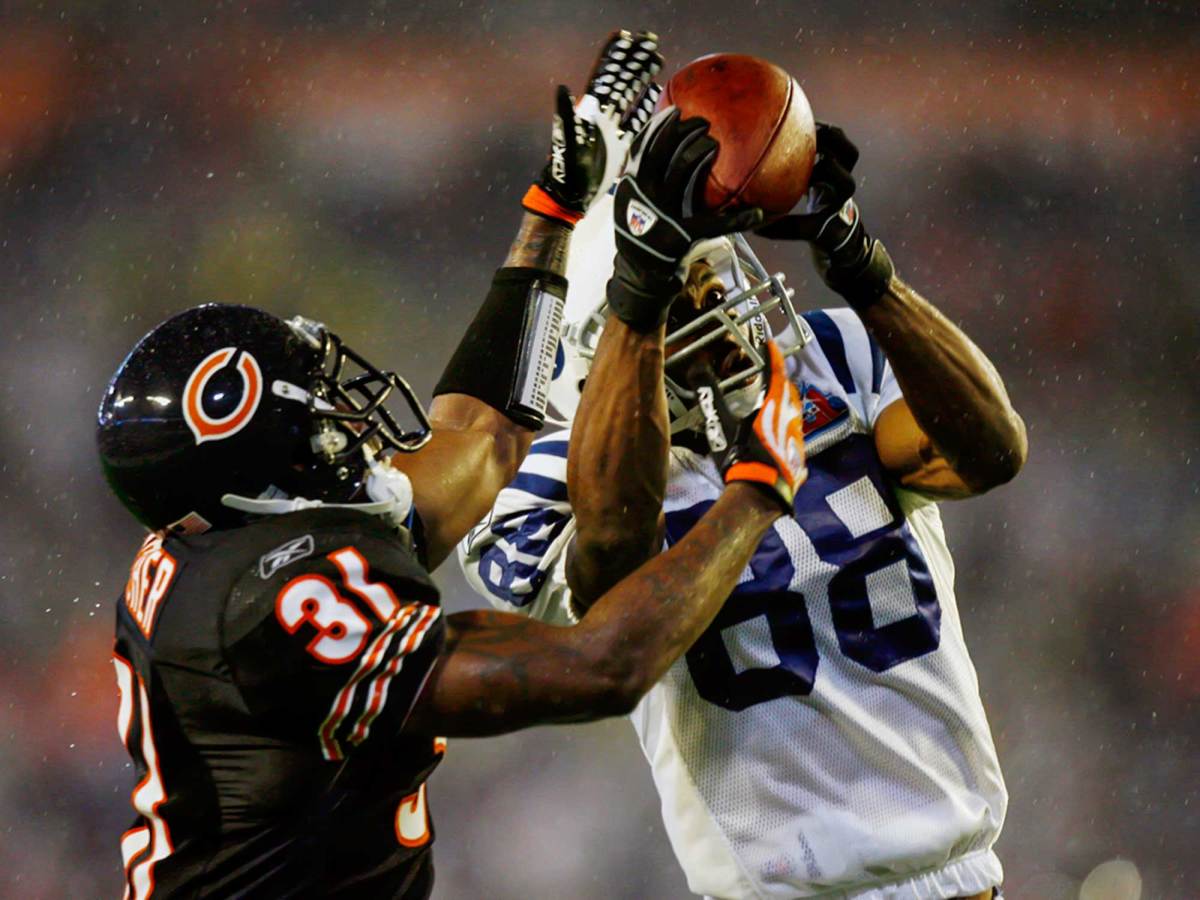
Marvin Harrison of the Indianapolis Colts watches a pass jolt into his hands from quarterback Peyton Manning. The Colts beat the Chicago Bears, 29-17, in Dolphin Stadium.
Super Bowl XXX, Jan. 28, 1996
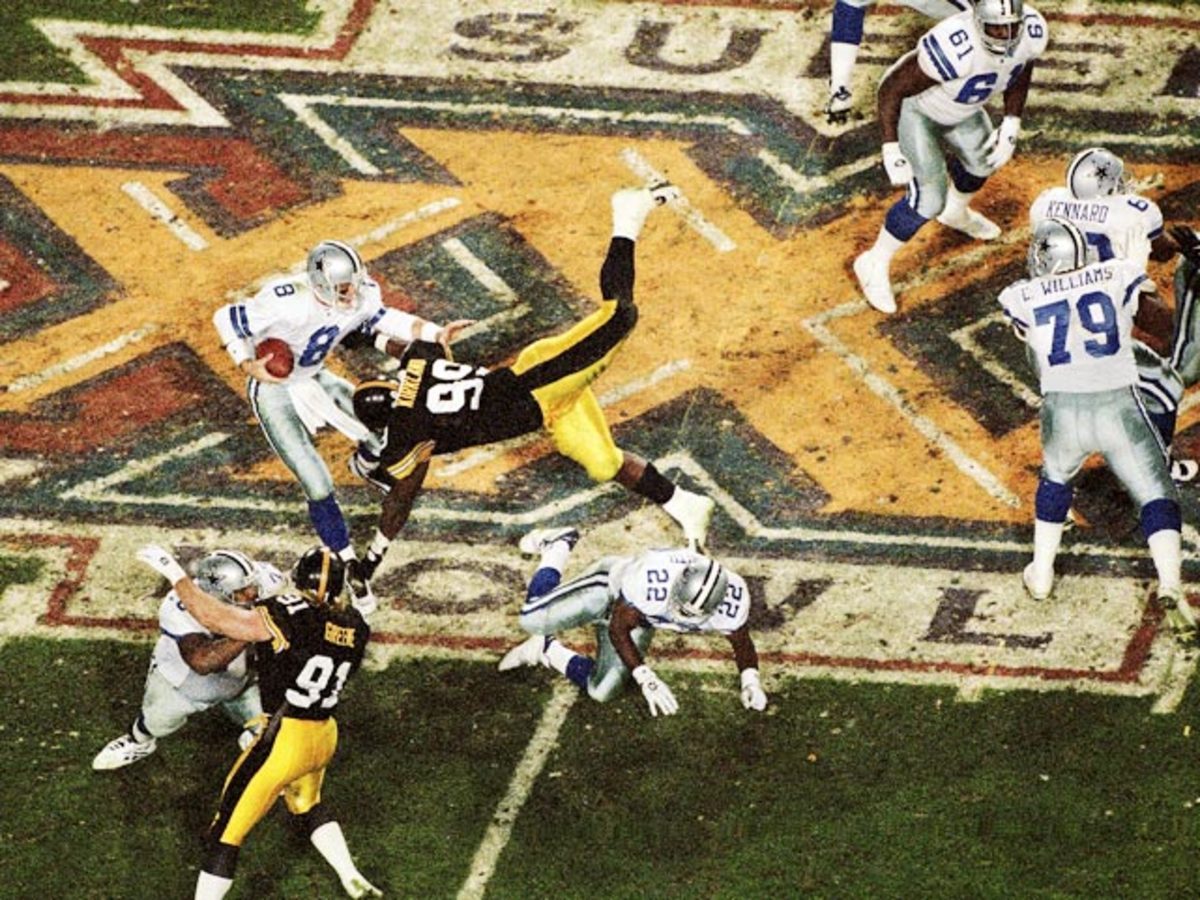
Pittsburgh Steelers linebacker Levon Kirkland dives at the feet of Dallas Cowboys quarterback Troy Aikman. Aikman threw for 209 yards and a touchdown on 15-of-23 passing in the 27-17 victory to become just the third quarterback to win three Super Bowls.
Super Bowl XXI, Jan. 25, 1987
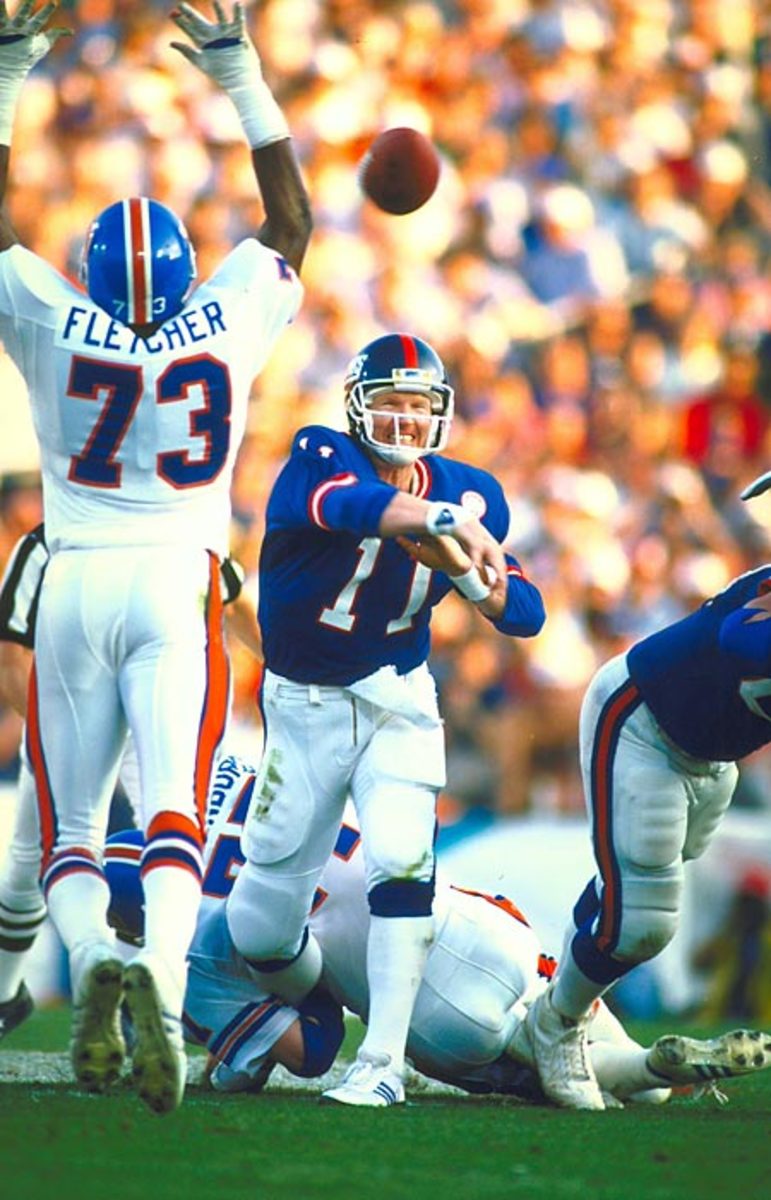
New York Giants quarterback Phil Simms tosses a pass around the outstretched arms of Denver Broncos linebacker Simon Fletcher. Simms carved up the Broncos defense for 268 yards and three touchdowns on 22-of-25 passing as the Giants dominated Denver 39-20.
Super Bowl XXXV, Jan. 28, 2001

Jermaine Lewis sprints down the right sideline for an 84-yard kickoff return for a touchdown in the third quarter. The Baltimore Ravens wide receiver's return capped off a dizzying spell of touchdowns in which the Ravens returned an interception and a kickoff for a touchdown and the New York Giants returned a kickoff for a touchdown on three consecutive plays. Baltimore won 34-7.
Super Bowl XXXII, Jan. 25, 1998
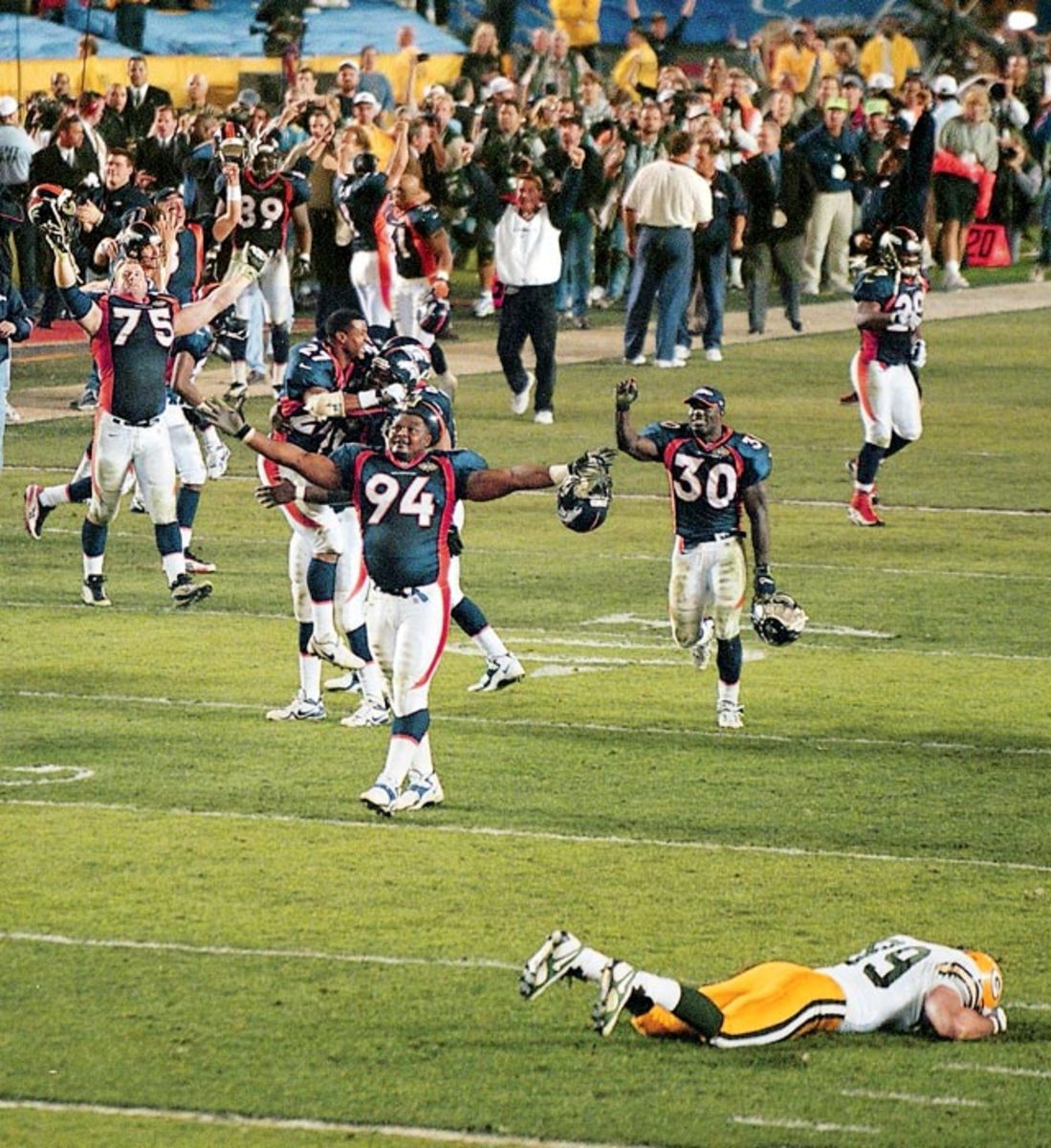
Keith Traylor, Terrell Davis and the Denver Broncos celebrate while Green Bay Packers tight end Mark Chmura lies faced-down on the field after the Broncos' 31-24 victory over the Packers. Denver's win was the first Super Bowl title for the franchise and snapped a 13-game losing streak for AFC teams in the Super Bowl.
Super Bowl XXXIV, Jan. 30, 2000

Tennessee Titans quarterback Steve McNair manages to avoid a sack and escape the tackles of the St. Louis Rams' Jay Williams and Kevin Carter during the final minute of St. Louis' 23-16 win. McNair threw for 214 yards and rushed for 64 more.
Super Bowl XLIV, Feb. 7, 2010
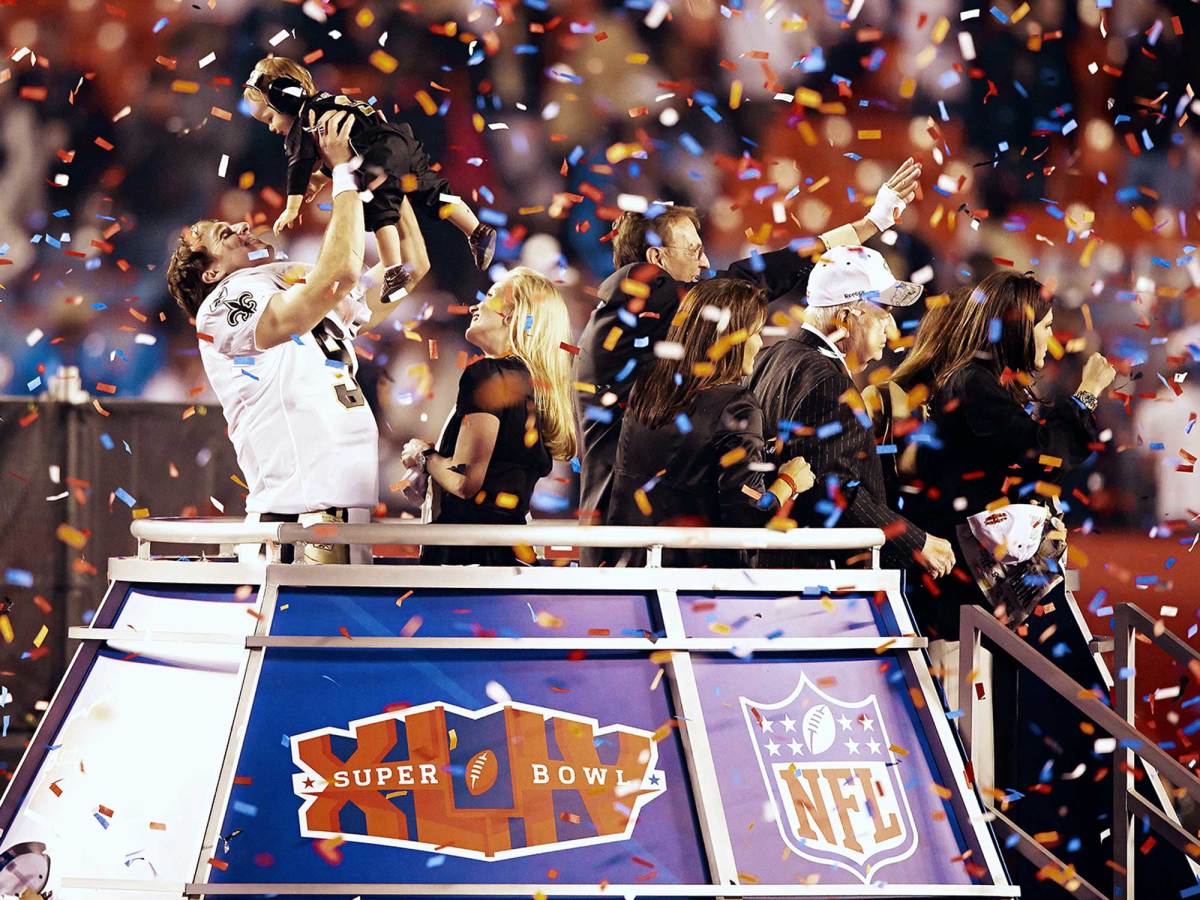
New Orleans Saints quarterback Drew Brees holds his son up in the air, standing on the podium after defeating the Indianapolis Colts, 31-17.
Super Bowl V, Jan. 17, 1971
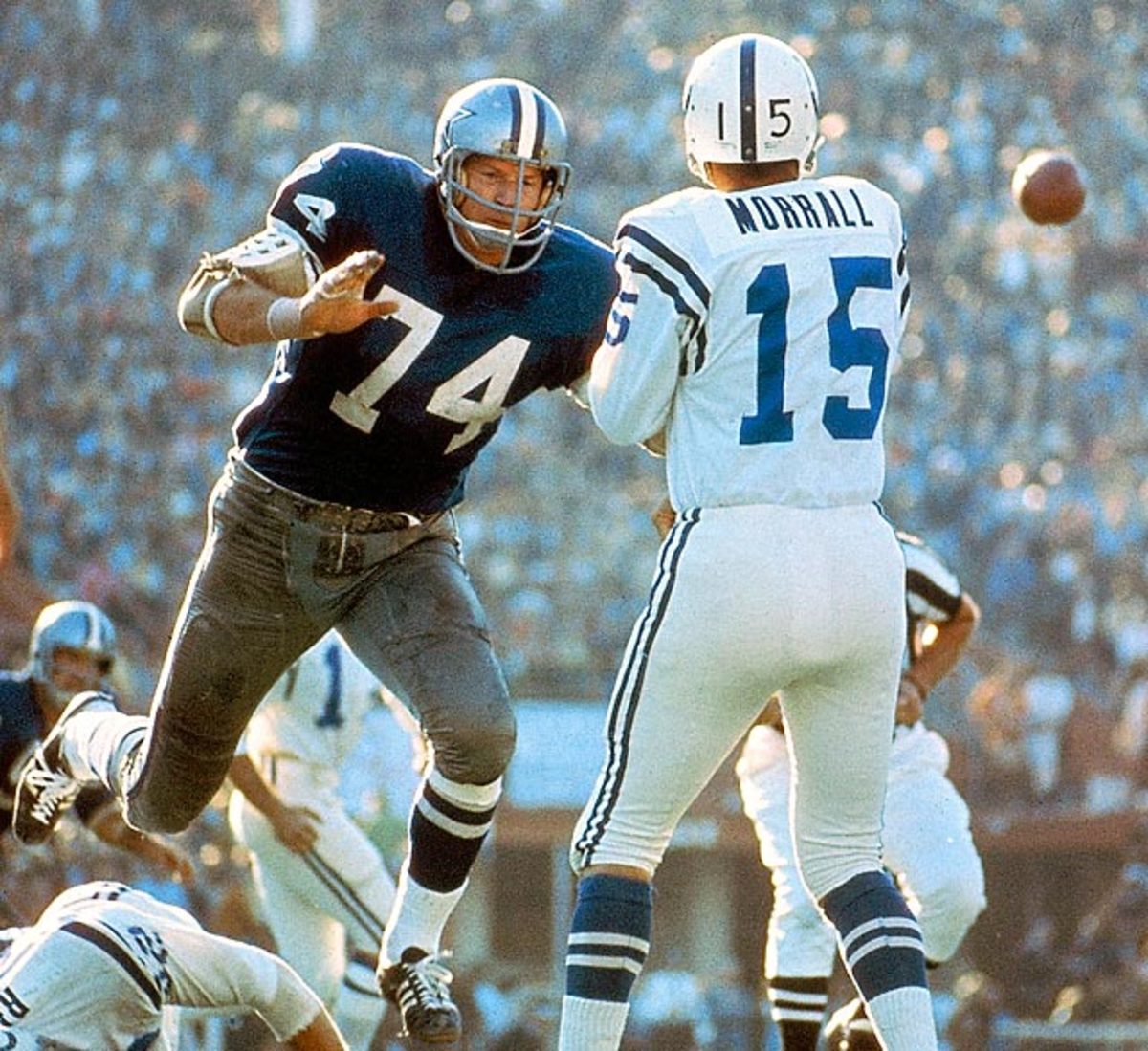
Baltimore Colts quarterback Earl Morrall gets a pass off as Dallas Cowboys defensive tackle Bob Lilly bears down on him. Morrall entered the game only after starting quarterback Johnny Unitas left with a rib injury. Despite completing less than 50 percent of his passes with no touchdowns, Morrall did just enough to guide the Colts to a 16-13 win over the Cowboys.
Super Bowl VII, Jan. 14, 1973
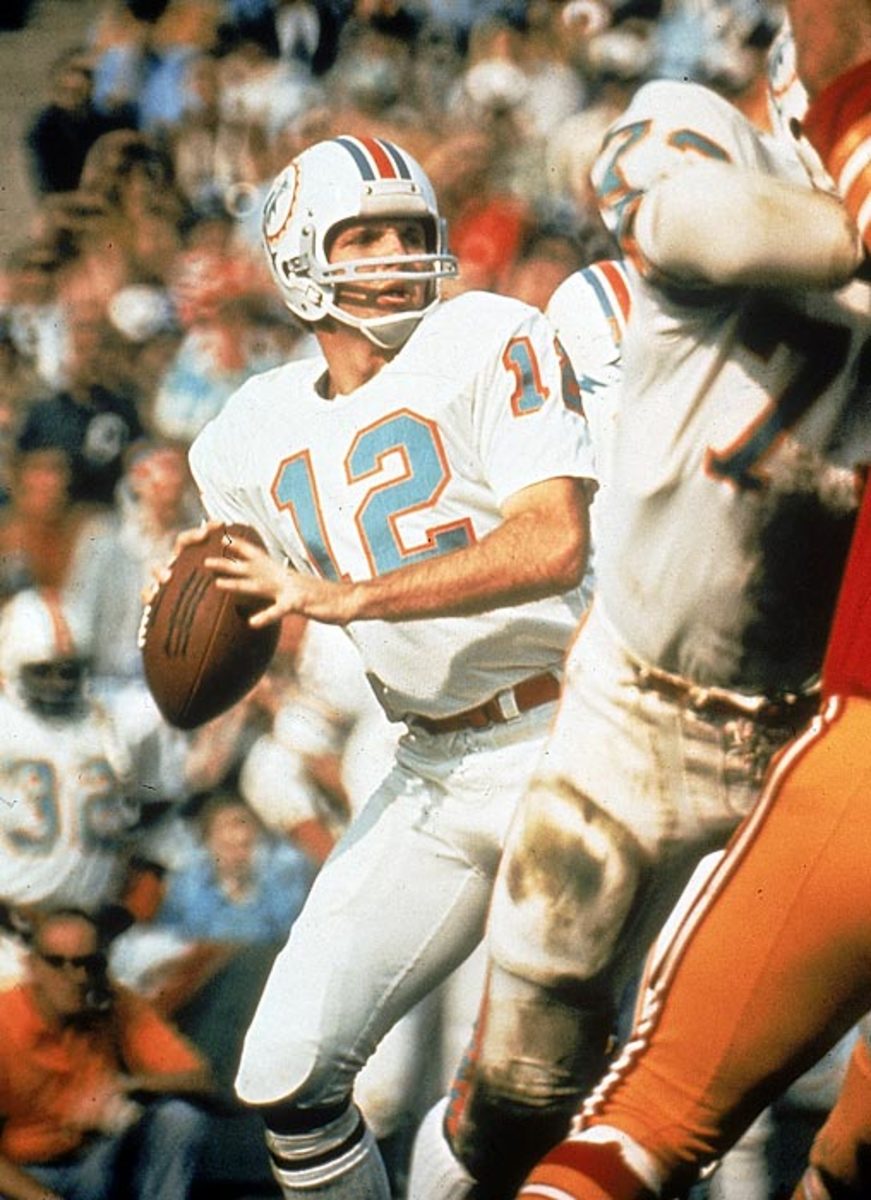
Miami Dolphins quarterback Bob Griese stands in the pocket and looks to pass against the Washington Redskins defense. Griese recovered from a fractured right leg and dislocated ankle suffered in the fifth week of the season to lead the Dolphins to a 14-7 victory, completing eight of 11 passes for a touchdown with one interception.
Super Bowl XXIX, Jan. 29, 1995
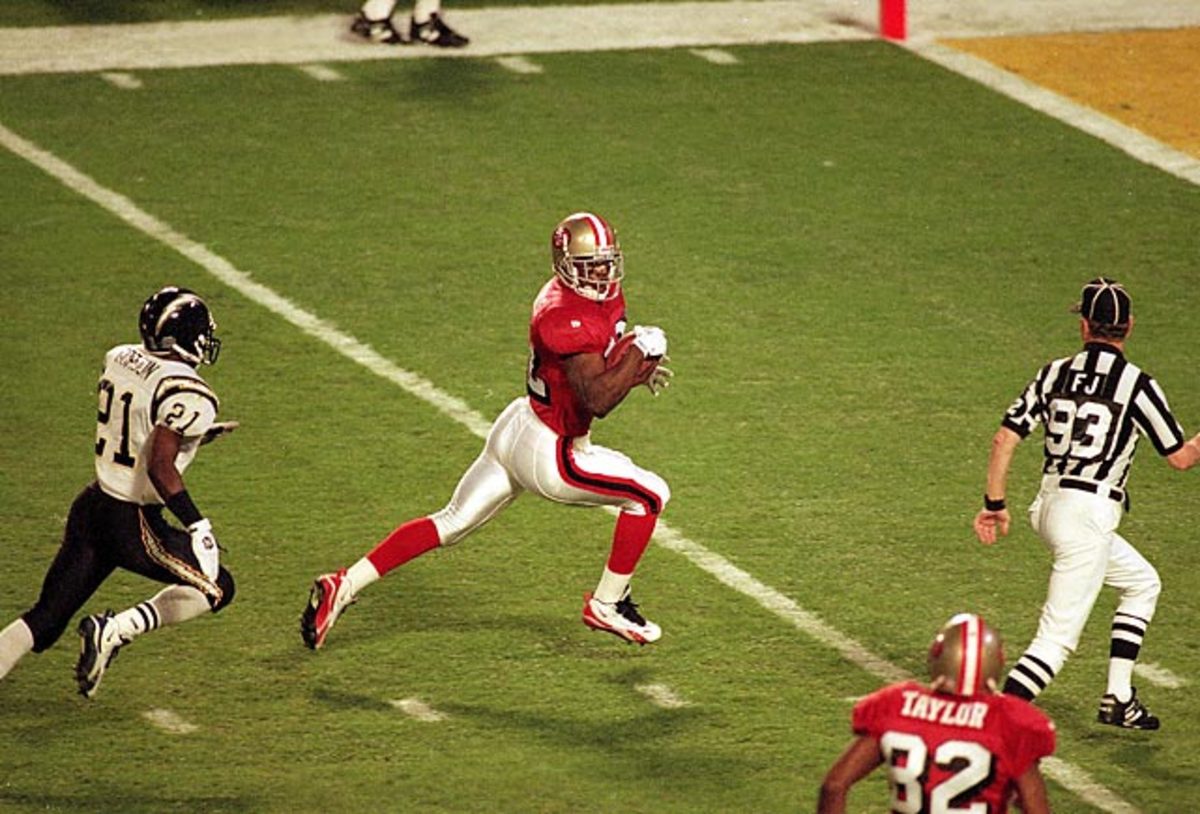
San Francisco 49ers running back Ricky Watters outpaces San Diego Chargers cornerback Darrien Gordon on a 51-yard touchdown pass from quarterback Steve Young. Watters scored three touchdowns in the Niners' 49-26 win, catching two and rushing for a third.
Super Bowl XXXI, Jan. 26, 1997

Green Bay Packers defensive end Reggie White bears down on Drew Bledsoe as the New England Patriots quarterback attempts to pass. The Green Bay Packers defense badly flustered Bledsoe as he threw four interceptions in the Pats' 35-21 loss. White set a Super Bowl record with three sacks.
Super Bowl XVIII, Jan. 22, 1984
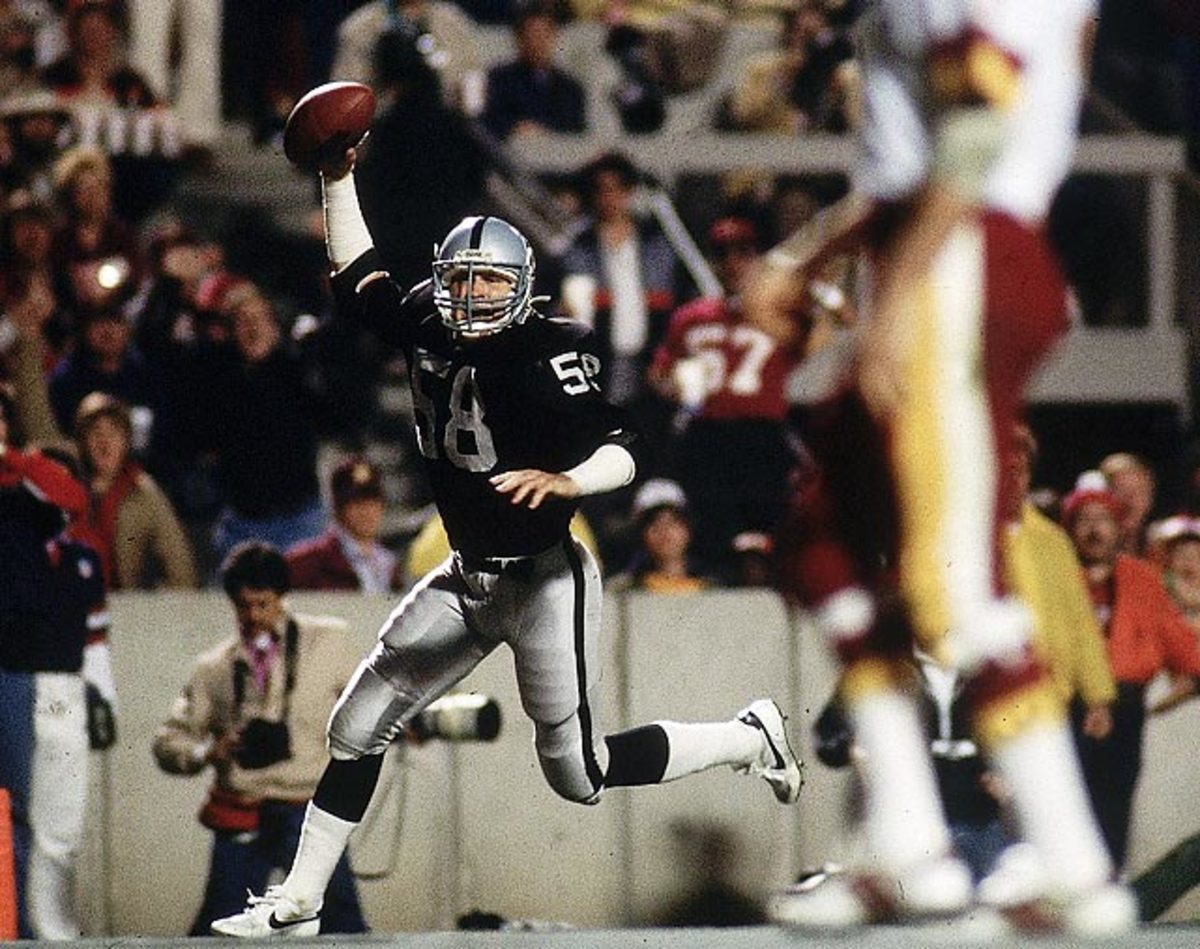
Jack Squirek raises the ball in triumph after intercepting Washington Redskins quarterback Joe Theismann for a touchdown en route to a 38-9 win for L.A. The Los Angeles Raiders linebacker jumped Theismann's screen pass after the Redskins had run the same play for a 67-yard gain in the team's regular season meeting.
Super Bowl XXXIII, Jan. 31, 1999

Wide receiver Rod Smith awaits a bomb from John Elway after gaining separation from Atlanta Falcons free safety Eugene Robinson. Smith took the ball for an 80-yard touchdown to expand the Denver Broncos' lead to 14 points in the second quarter. They went on to win 34-19.
Super Bowl XLIII, Feb. 1, 2009
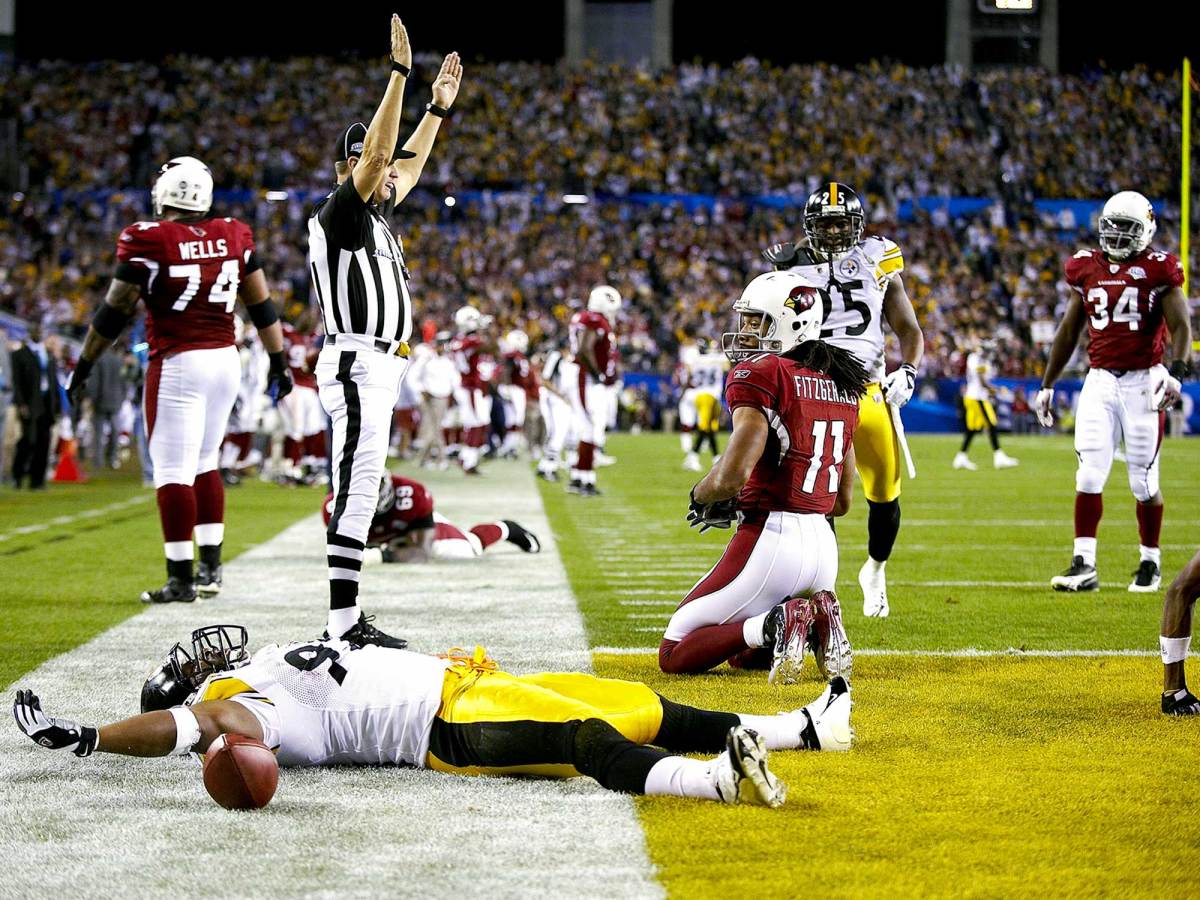
Pittsburgh Steelers linebacker James Harrison rests in the end zone after returning a 100-yard touchdown interception against the Arizona Cardinals. The Steelers topped the Cardinals, 27-23, in Raymond James Stadium.
Super Bowl XXIX, Jan. 29, 1995

With safeties Stanley Richard and Darren Carrington on his tail, Jerry Rice races to the end zone for the opening score of the game. The San Francisco 49ers wide receiver's 44-yard touchdown grab set the record for the fastest touchdown to open a Super Bowl and set the tone for San Francisco's 49-26 win over the San Diego Chargers.
Super Bowl XXXVI, Feb. 3, 2002

New England Patriots linebacker Willie McGinest crashes into Kurt Warner as defensive tackle Richard Seymour closes in from behind. Warner, leading the Greatest Show on Turf offense, threw for 365 yards with two total touchdowns but also tossed two interceptions in the Rams' 20-17 loss.
Super Bowl XXVI, Jan. 26, 1992
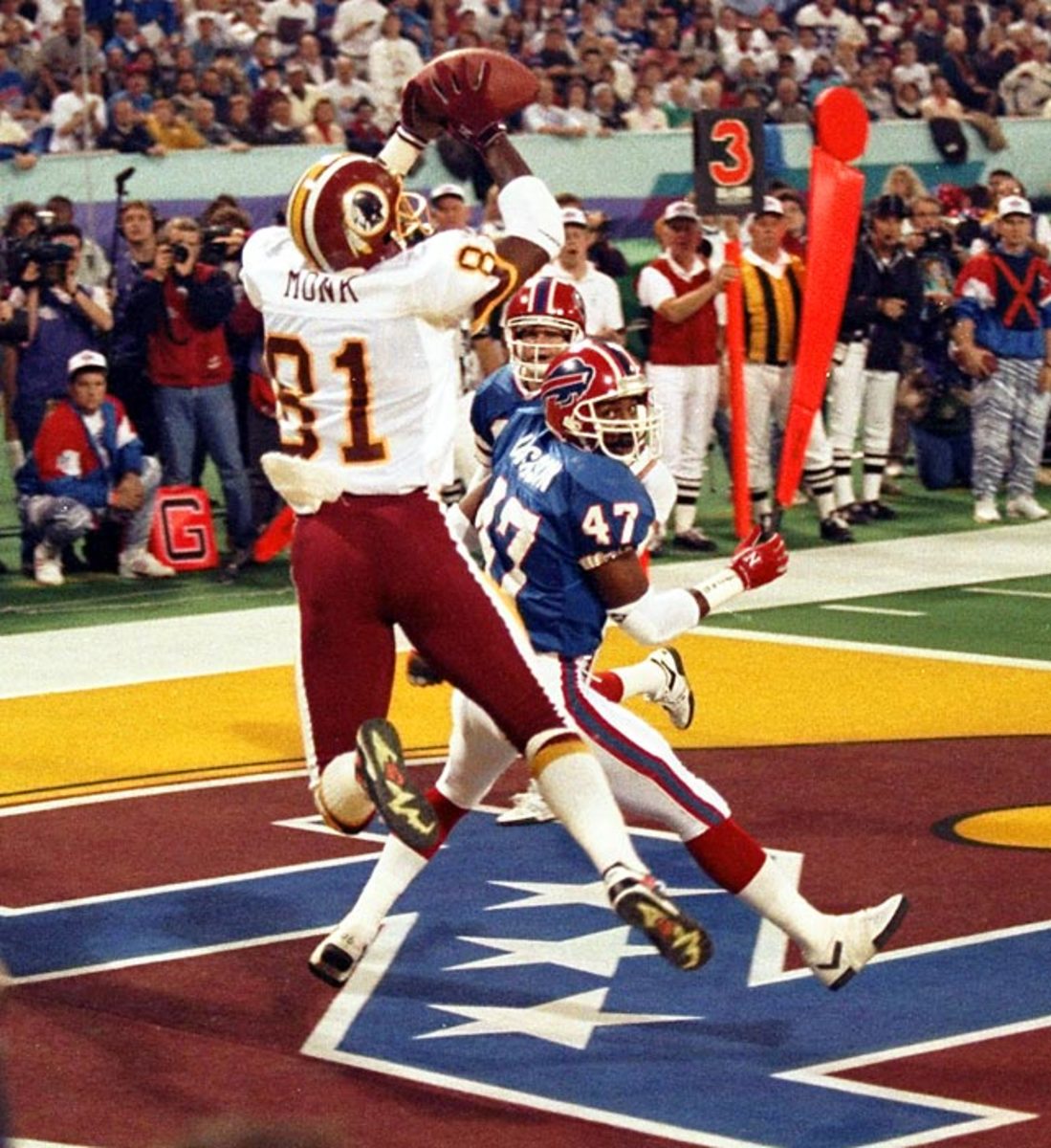
Art Monk appears to catch a touchdown pass over the head of Buffalo Bills cornerback Kirby Jackson. Although the play was ruled a touchdown on the field, a video review overturned the call when replay revealed the Washington Redskins wide receiver's foot landed out of bounds. It was the first time a touchdown was overturned by instant replay in a Super Bowl, although the Redskins went on to win 37-24.
Super Bowl III, Jan. 12, 1969
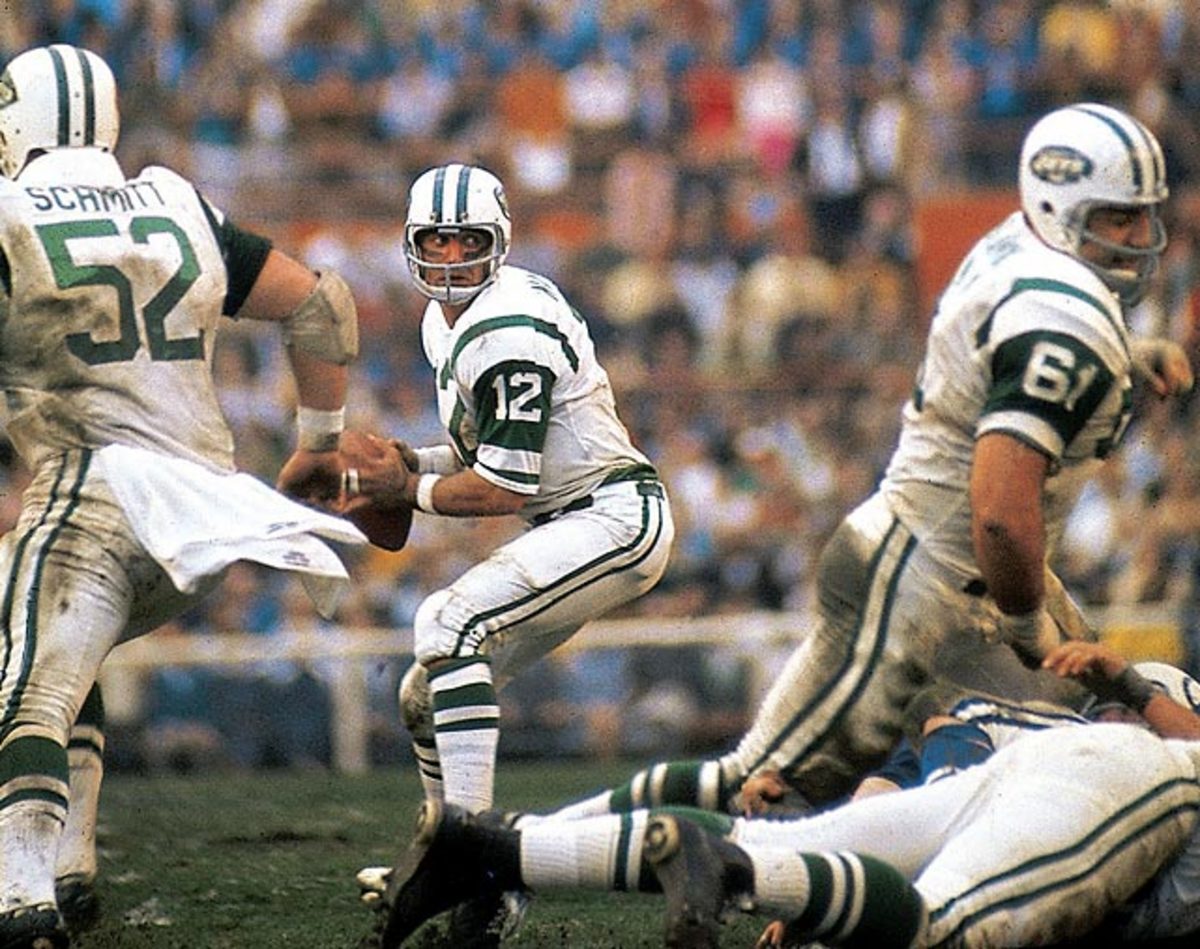
New York Jets quarterback Joe Namath looks downfield to pass against the Baltimore Colts. Broadway Joe's team backed up his victory guarantee as New York upset the heavily favored Colts 16-7. Namath completed 17 of 28 passes for 206 yards and was named Super Bowl MVP.
Super Bowl XXIV, Jan. 28, 1990
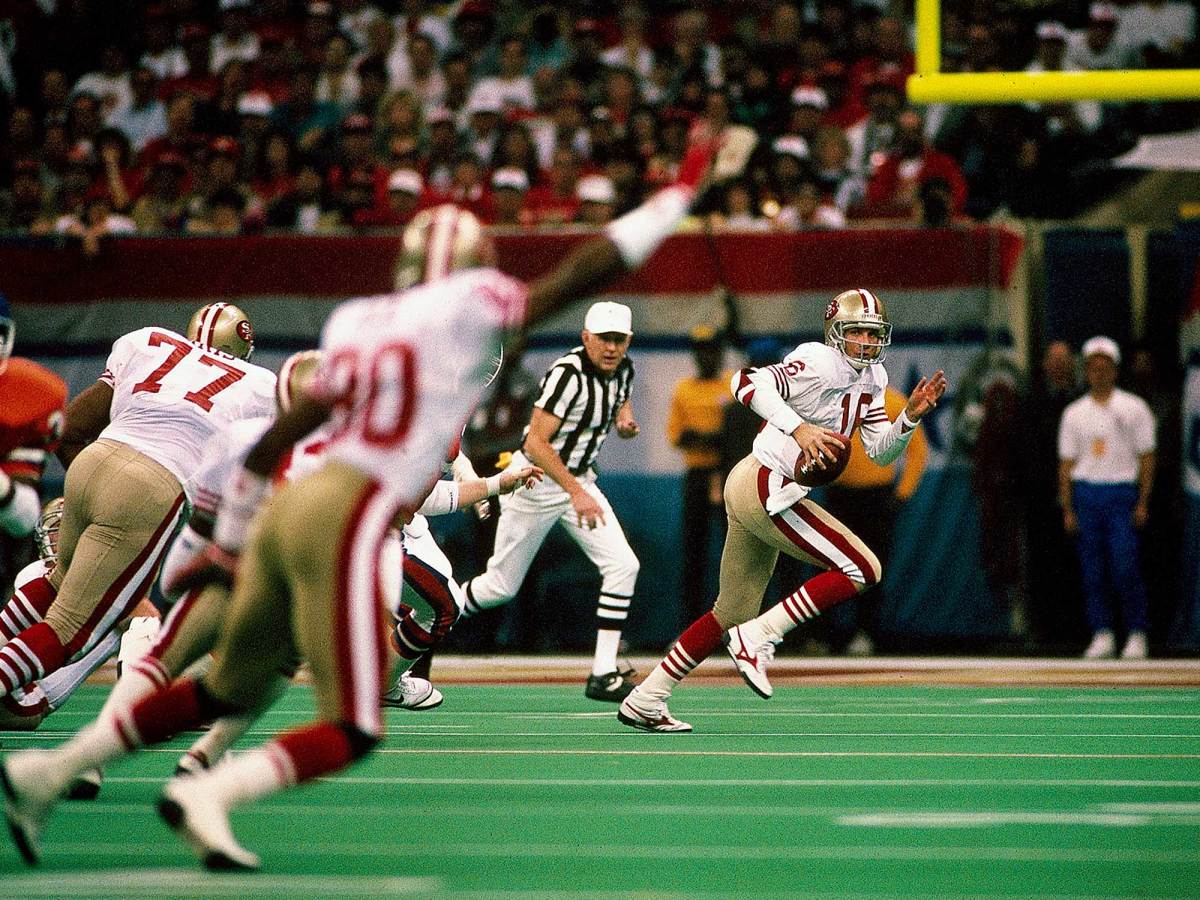
San Francisco 49ers quarterback Joe Montana rolls out as wide receiver Jerry Rice raises his right arm in the foreground. The 49ers trounced the Denver Broncos, 55-10.
Super Bowl XXXIX, Feb. 6, 2005
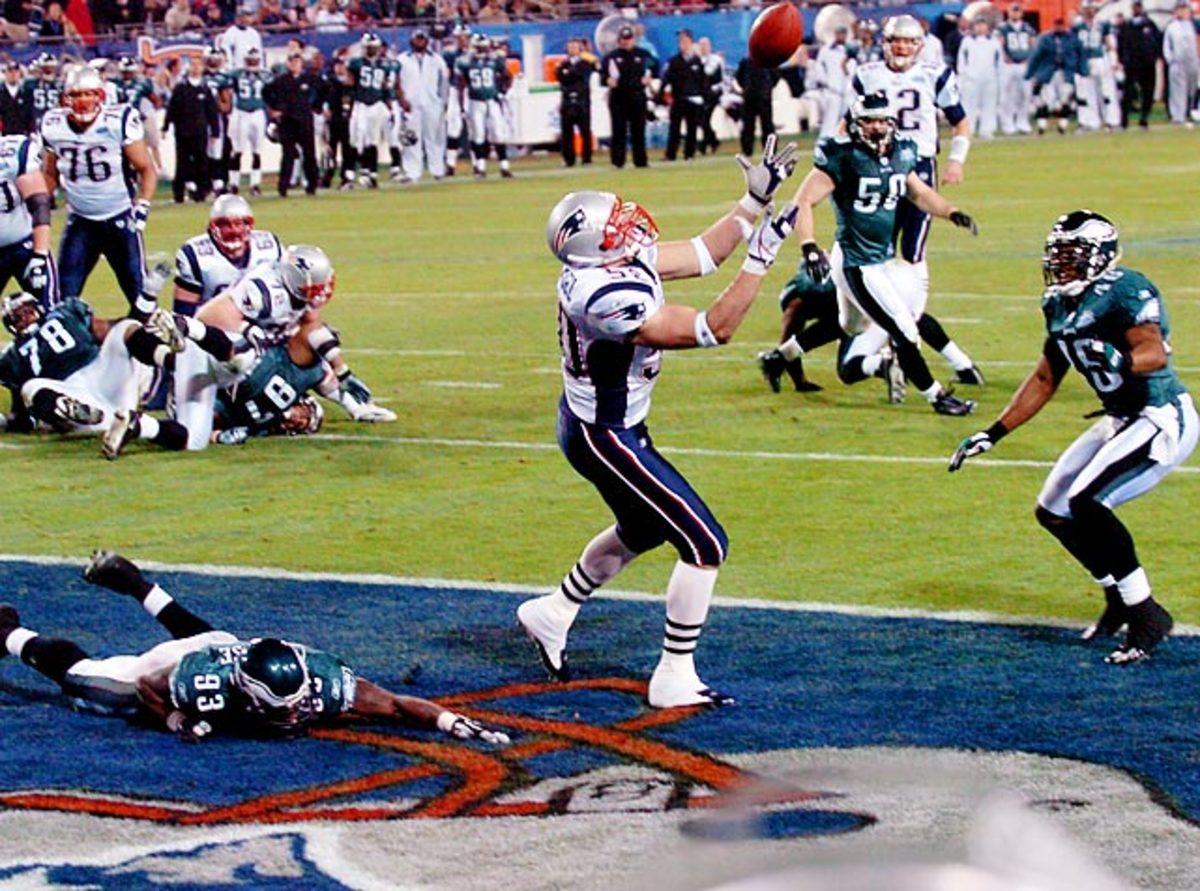
New England Patriots linebacker and tight end Mike Vrabel reaches for a floating pass from Tom Brady in the end zone. Vrabel's touchdown grab put the Patriots up 14-7 in the third quarter. On defense, Vrabel's primary duties, he sacked Philadelphia Eagles quarterback Donovan McNabb for a 16-yard loss. The Patriots won 24-21.
Super Bowl XXXII, Jan. 25, 1998

John Elway raises the Lombardi Trophy after the Denver Broncos' 31-24 triumph over the Green Bay Packers. After 15 seasons in the league, the illustrious quarterback finally won his first Super Bowl.
Super Bowl IX, Jan. 12, 1975
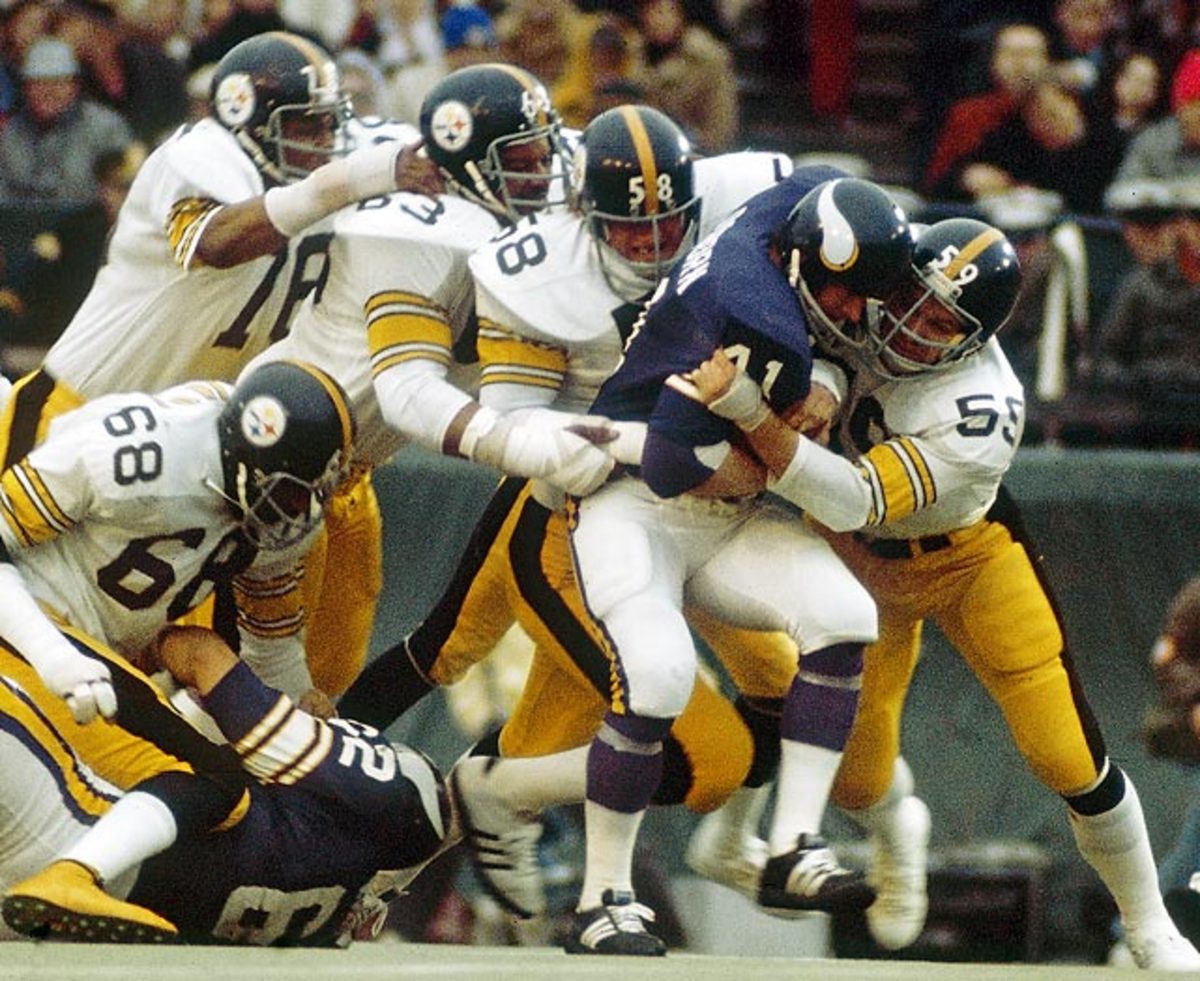
Jack Ham, Jack Lambert, Ernie Holmes and Dwight White of the Pittsburgh Steelers swarm to Minnesota Vikings fullback Dave Osborn. Pittsburgh's Steel Curtain defense contained the Vikings, limiting them to just 119 total offensive yards in pacing a 16-6 win.
Super Bowl II, Jan. 14, 1968

Green Bay Packers defensive end Willie Davis takes down Oakland Raiders quarterback Daryle Lamonica for a sack. The Packers' staunch defense limited the Raiders to 293 yards of offense in Green Bay's 33-14 win.
Super Bowl XLII, Feb. 3, 2008

Plaxico Burress eyes the football as it floats in to him for the game-winning touchdown. The New York Giants wide receiver caught the pass from quarterback Eli Manning with 35 seconds left to upset the New England Patriots 17-14, ruining the Patriots' bid for a perfect season.
Super Bowl IV, Jan. 11, 1970
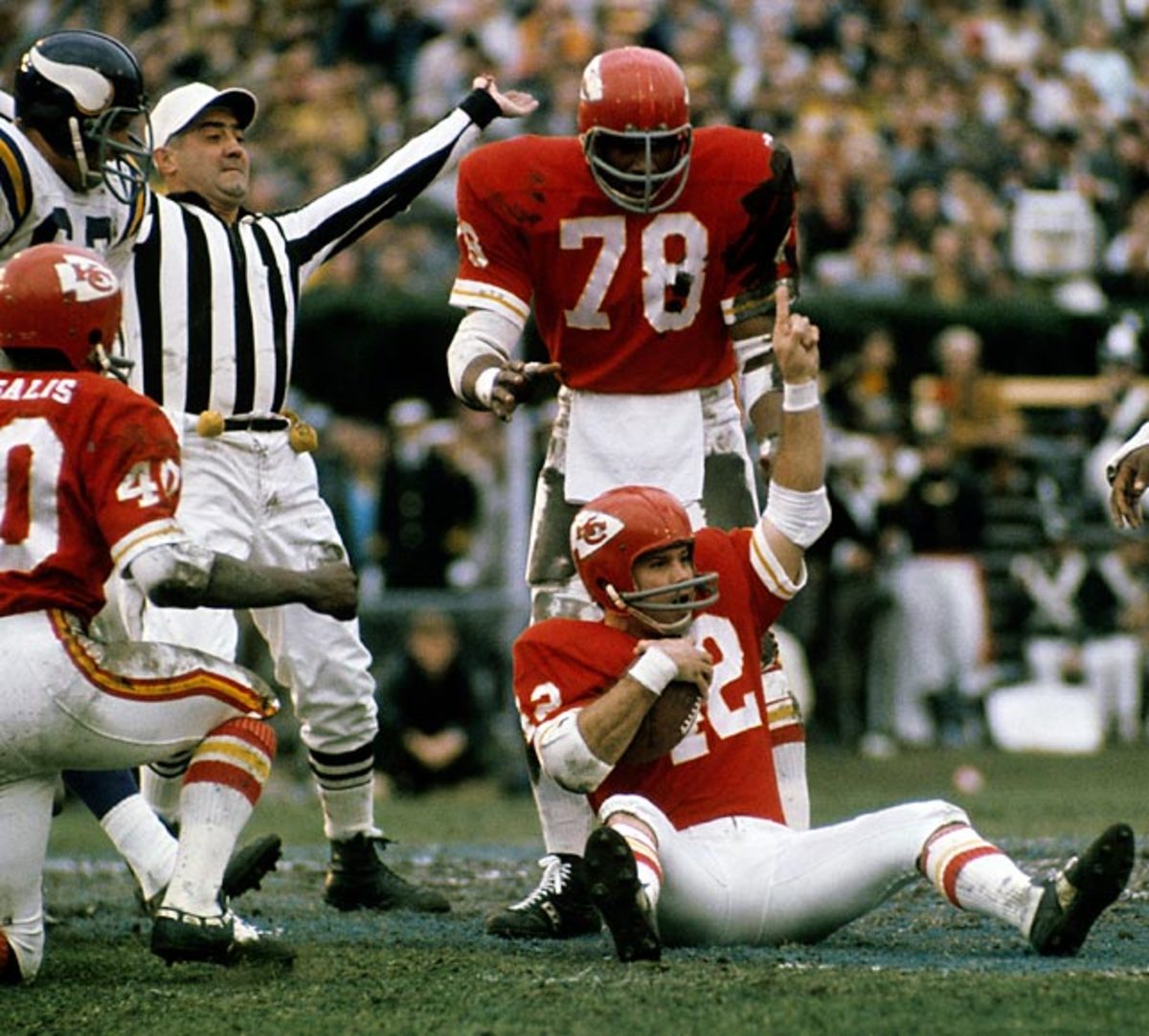
Kansas City Chiefs defensive back Johnny Robinson celebrates after recovering John Henderson's fumble in the second quarter of Super Bowl IV. The Chiefs defense, running a 3-4 scheme unfamiliar to the Minnesota Vikings in the NFL, forced five turnovers to lead Kansas City to a 23-7 victory.
Super Bowl XVIII, Jan. 22, 1984

Los Angeles Raiders running back Marcus Allen races away from Anthony Washington and the rest of the Washington Redskins defense for a 74-yard touchdown in the third quarter of a 38-9 blowout. Allen's run was the longest in Super Bowl history at the time.
Super Bowl XL, Feb. 5, 2006
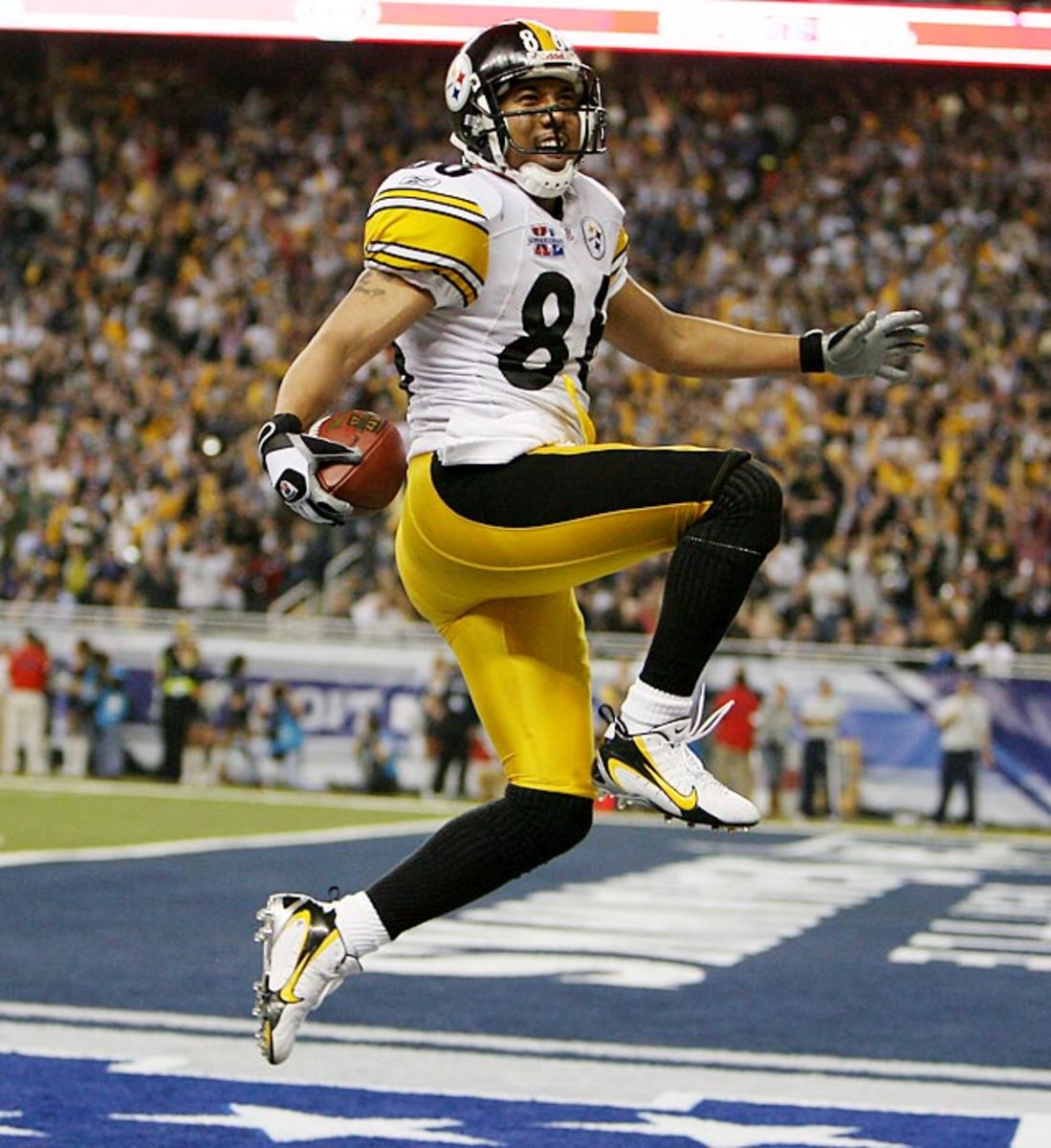
Pittsburgh Steelers wide receiver Hines Ward leaps in the end zone after catching a 43-yard touchdown pass from Antwaan Randle El. Randle El, a wide receiver who played quarterback in college, threw the pass after a wide receiver reverse that left Ward wide open. Ward led all receivers with 123 yards on five catches in the 21-10 win over the Seattle Seahawks.
Super Bowl VI, Jan. 16, 1972
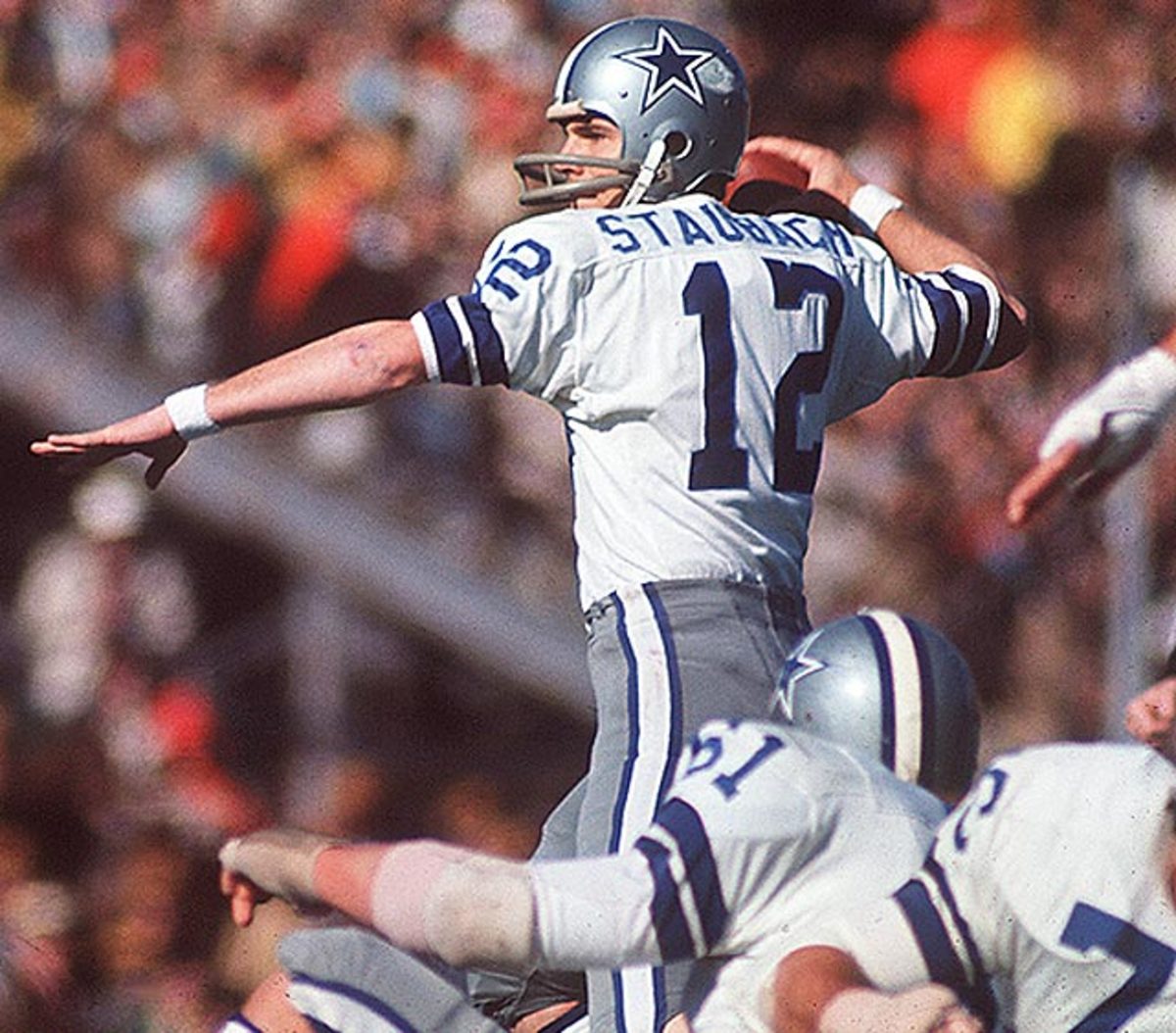
Dallas Cowboys quarterback Roger Staubach stares down the Miami Dolphins defense and looks for an open receiver. Staubach was named Super Bowl MVP after completing 12 of 19 passes for 119 yards and two touchdowns in the 24-3 win.
Super Bowl LI, Feb. 5, 2017
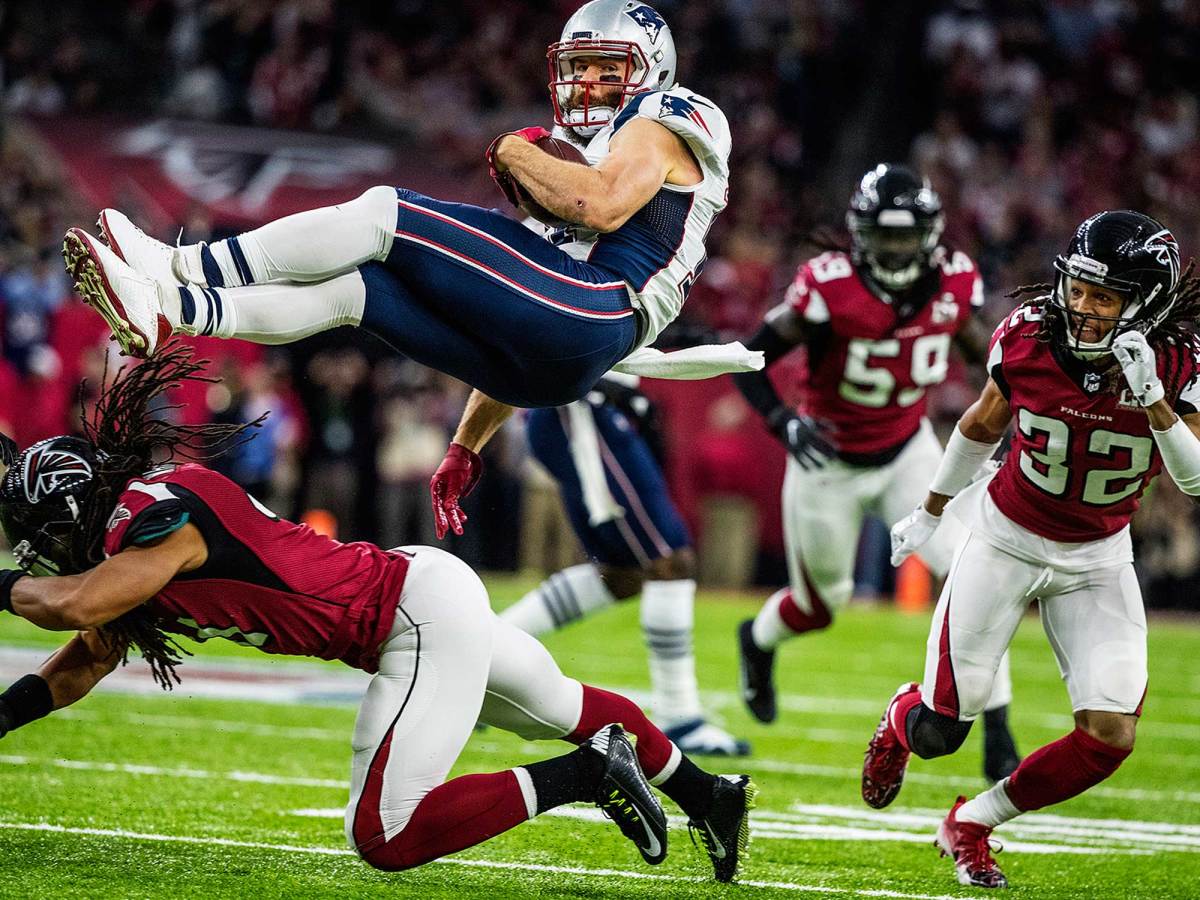
New England Patriots wideout Julian Edelman hangs onto the ball while an Atlanta Falcons defender sends him airborn. The Patriots completed a historic 25-point comeback against the Falcons to win in overtime.
Super Bowl XXVII, Jan. 31, 1993
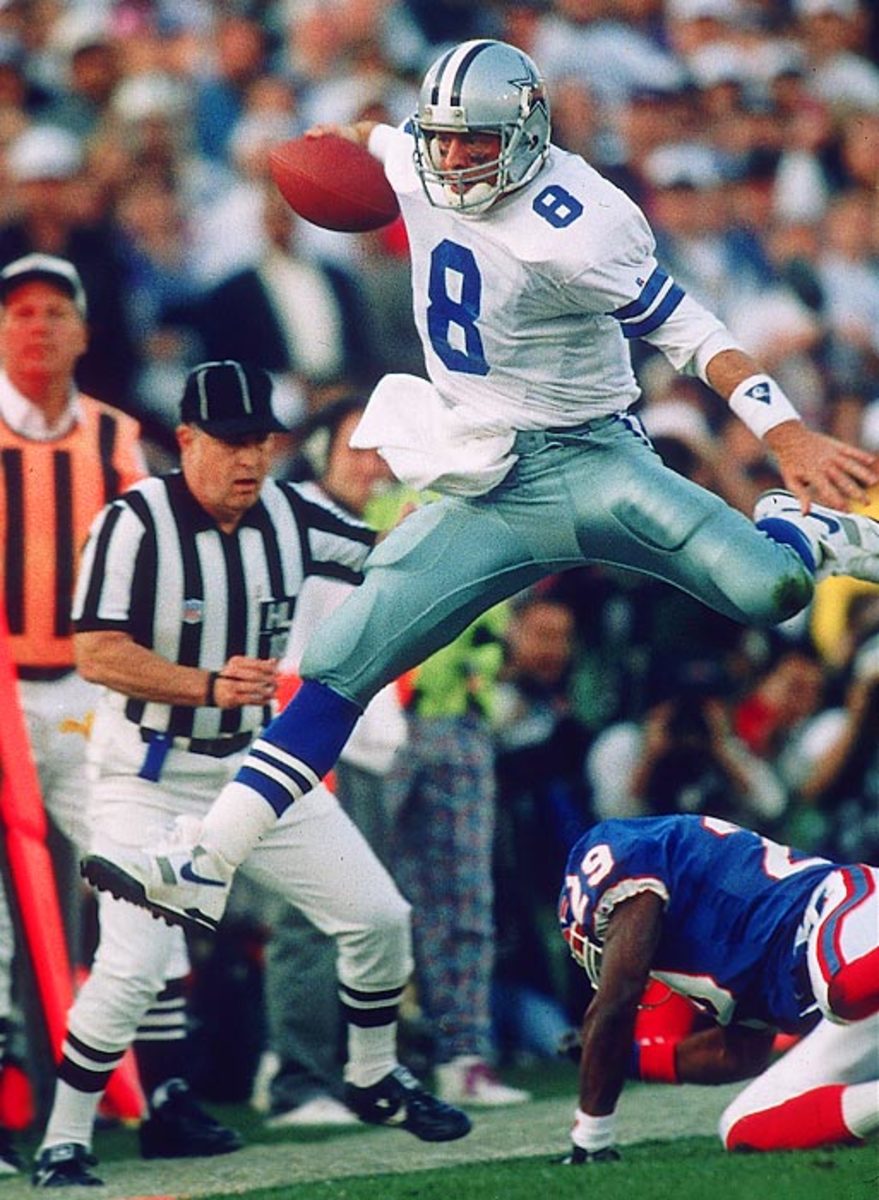
Troy Aikman hurdles a Buffalo Bills defender on a scramble. The Dallas Cowboys quarterback was named Super Bowl MVP after completing 22 of 30 passes for 273 yards and four touchdowns. He also rushed for 28 yards in the 52-17 romp.
Super Bowl XXIII, Jan. 22, 1989

San Francisco 49ers defensive tackle Michael Carter tugs at Boomer Esiason as the Cincinnati quarterback attempts to pass. The 49ers defense limited Esiason to just 11-of-25 passing and 144 yards with no touchdowns and one interception in San Francisco's 20-16 win.
Super Bowl XLIV, Feb. 7, 2010
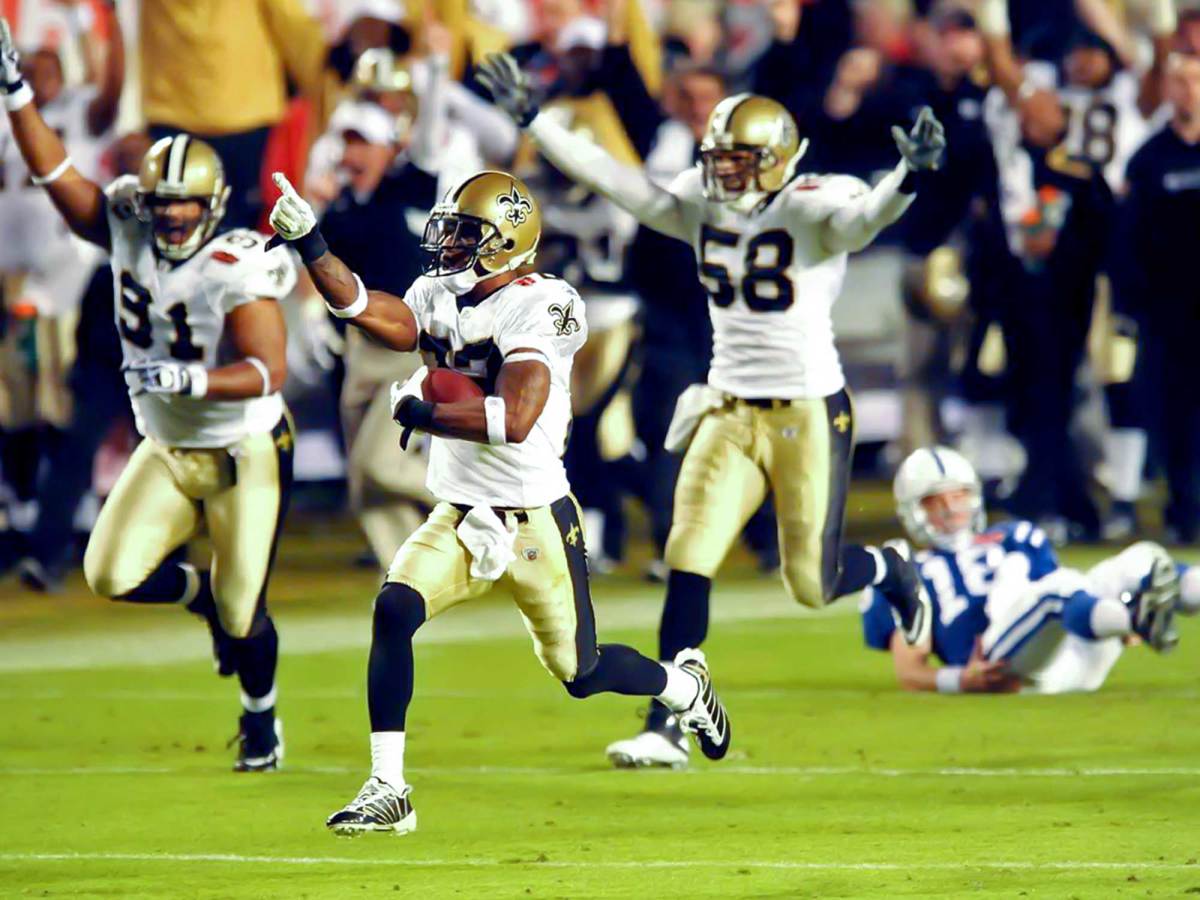
New Orleans Saints cornerback Tracy Porter returns an interception from Indianapolis Colts QB Peyton Manning for a touchdown. That score put New Orleans up, 31-17, in the fourth quarter.
Super Bowl XXVII, Jan. 31, 1993

Dallas Cowboys safety Thomas Everett intercepts a pass from Buffalo Bills quarterback Jim Kelly in the end zone on fourth down. Everett picked off two passes as the Cowboys routed the Bills 52-17.
Super Bowl XIV, Jan. 20, 1980
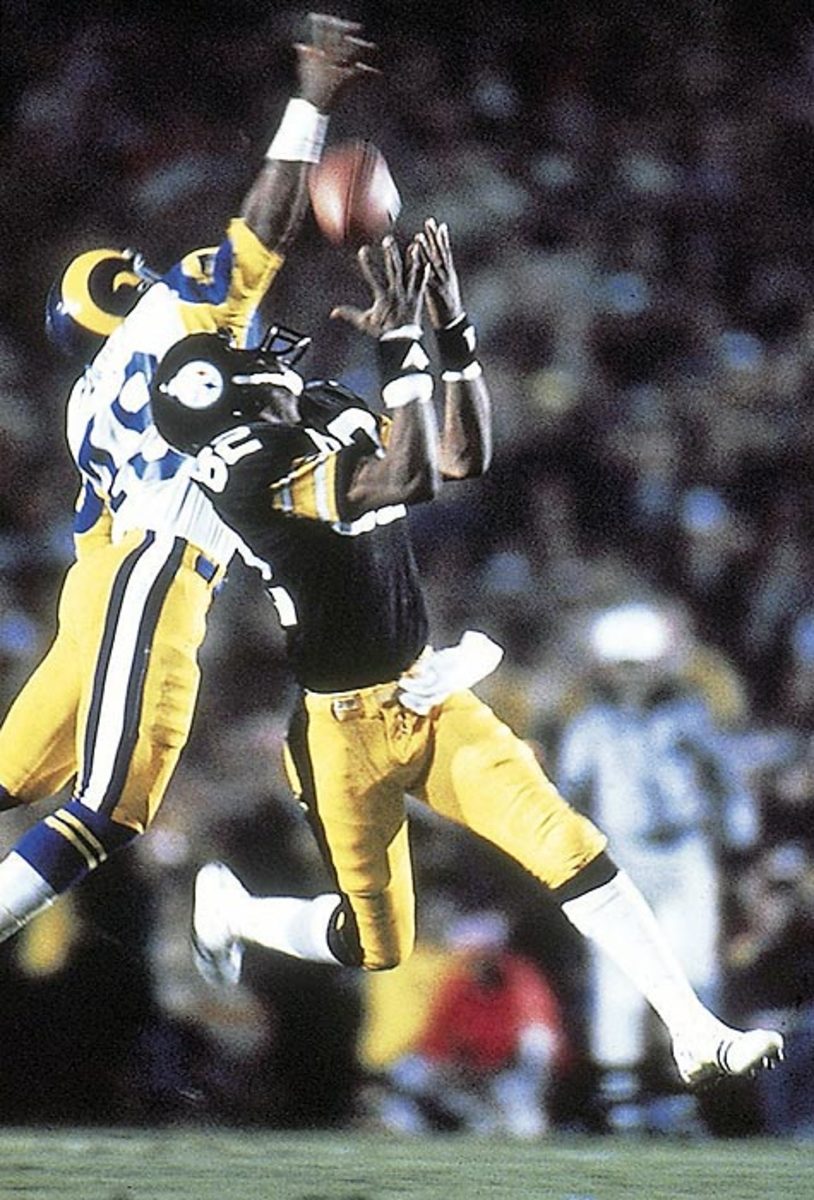
Pittsburgh Steelers wide receiver John Stallworth hauls in a pass from Terry Bradshaw just beyond the outstretched fingers of Los Angeles Rams cornerback Rod Perry. Stallworth took the pass 73 yards to the end zone to give the Steelers the lead for good in their 31-19 win.
Super Bowl VIII, Jan. 13, 1974
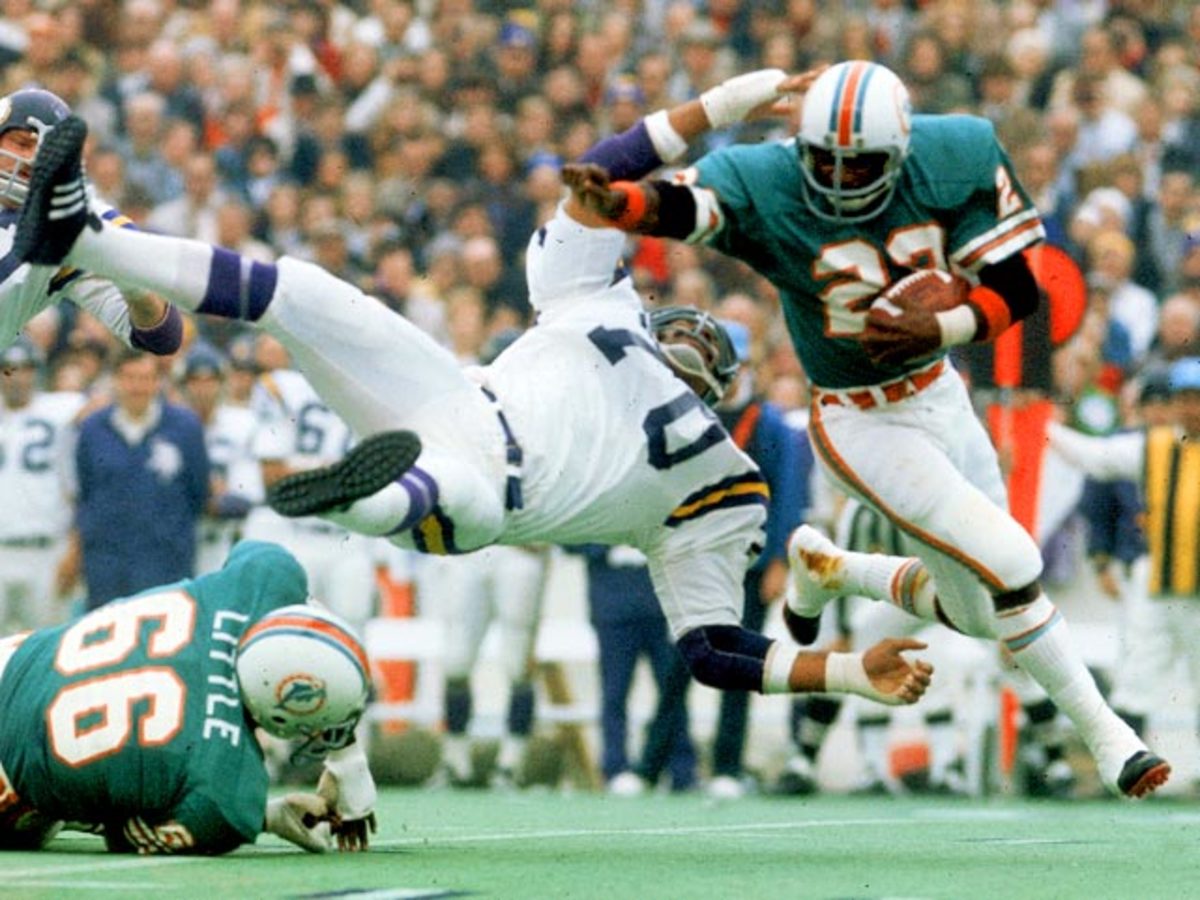
Miami Dolphins running back Mercury Morris breaks a tackle on a carry to the outside. Morris provided the latter part of the 1-2 punch of Miami's running game in the 24-17 win over Minnesota, spelling Csonka for 11 carries for 34 yards.
Super Bowl XLV, Feb. 6, 2011
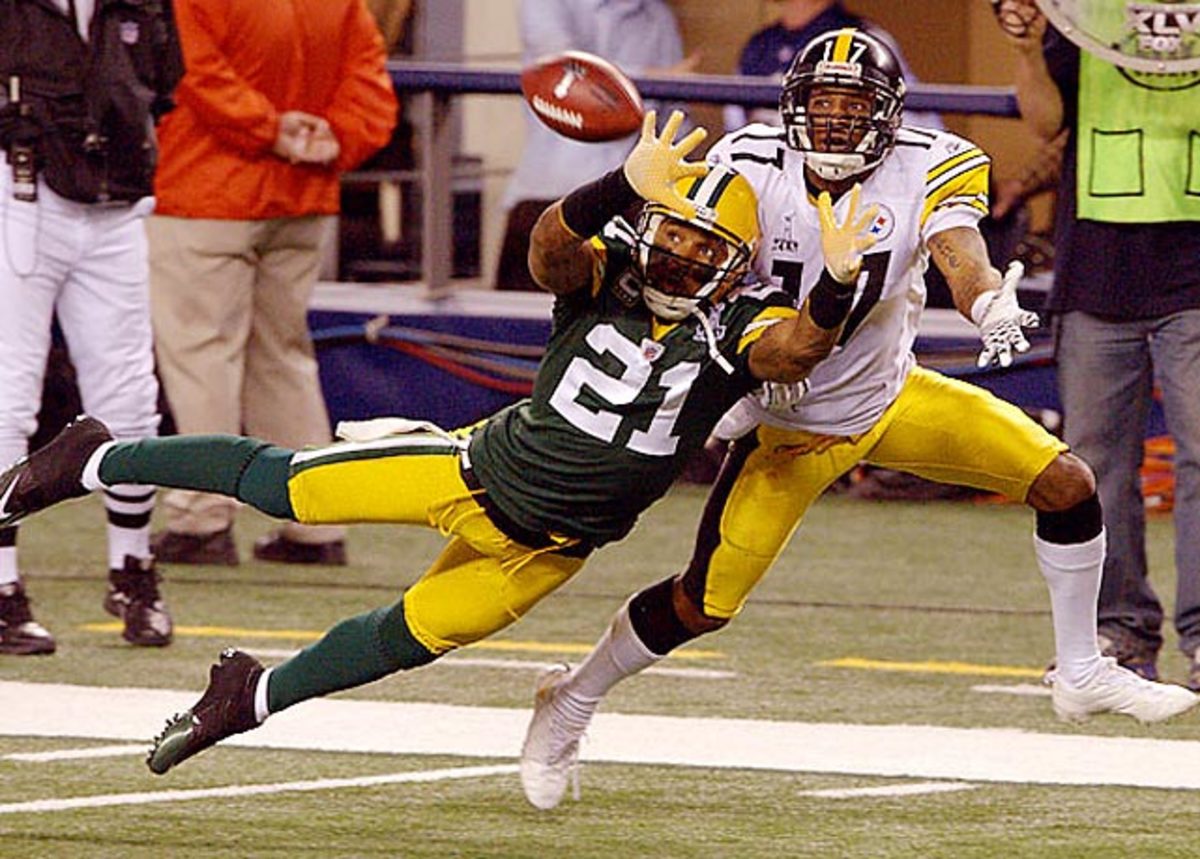
Green Bay Packers cornerback Charles Woodson breaks up a pass intended for Pittsburgh Steelers wide receiver Mike Wallace. Woodson broke his collarbone on the play and did not return. The Packers won 31-25.
Super Bowl XX,Jan. 25, 1986
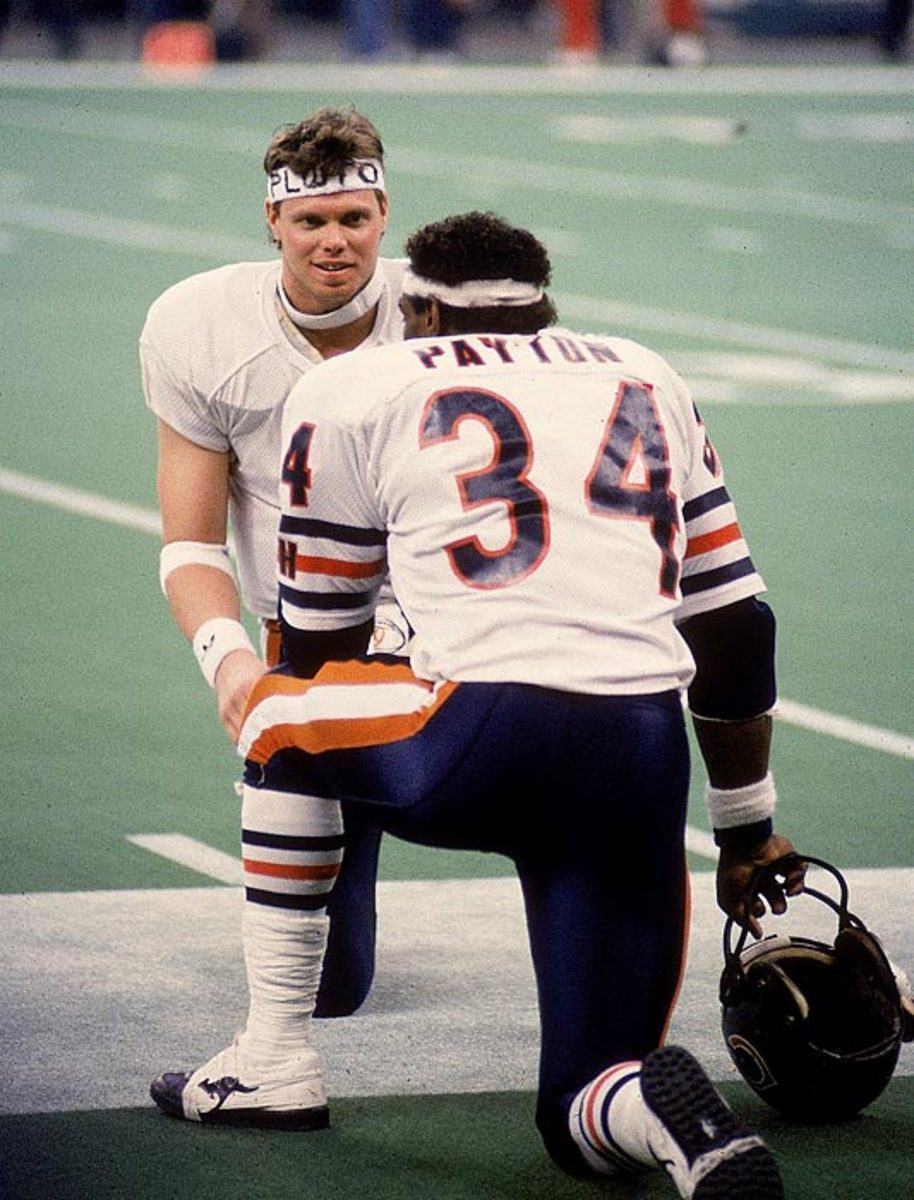
Legendary running back Walter Payton chats on the sidelines with quarterback Jim McMahon. In the only Super Bowl of Payton's Hall of Fame career, he was held to 61 yards on 22 carries with a fumble. Very little went right for the New England Patriots other than limiting Payton as the Chicago Bears routed New England 46-10.
Super Bowl XX, Jan. 26, 1986

Chicago Bears defensive back Reggie Phillips raises his arms after returning an interception 28 yards for a touchdown against the New England Patriots. The Bears' innovative 46 defense dominated the game, registering seven sacks and allowing just seven rushing yards in the 46-10 win, while directly putting nine points on the board.
Super Bowl XVIII, Jan. 22, 1984

Marcus Allen dives into the end zone for his first of two touchdowns against the Washington Redskins. The Los Angeles Raiders running back was named Super Bowl MVP after rushing for a Super Bowl-record 191 yards in the Raiders' 38-9 victory.
Super Bowl XLVII, Feb. 3, 2013
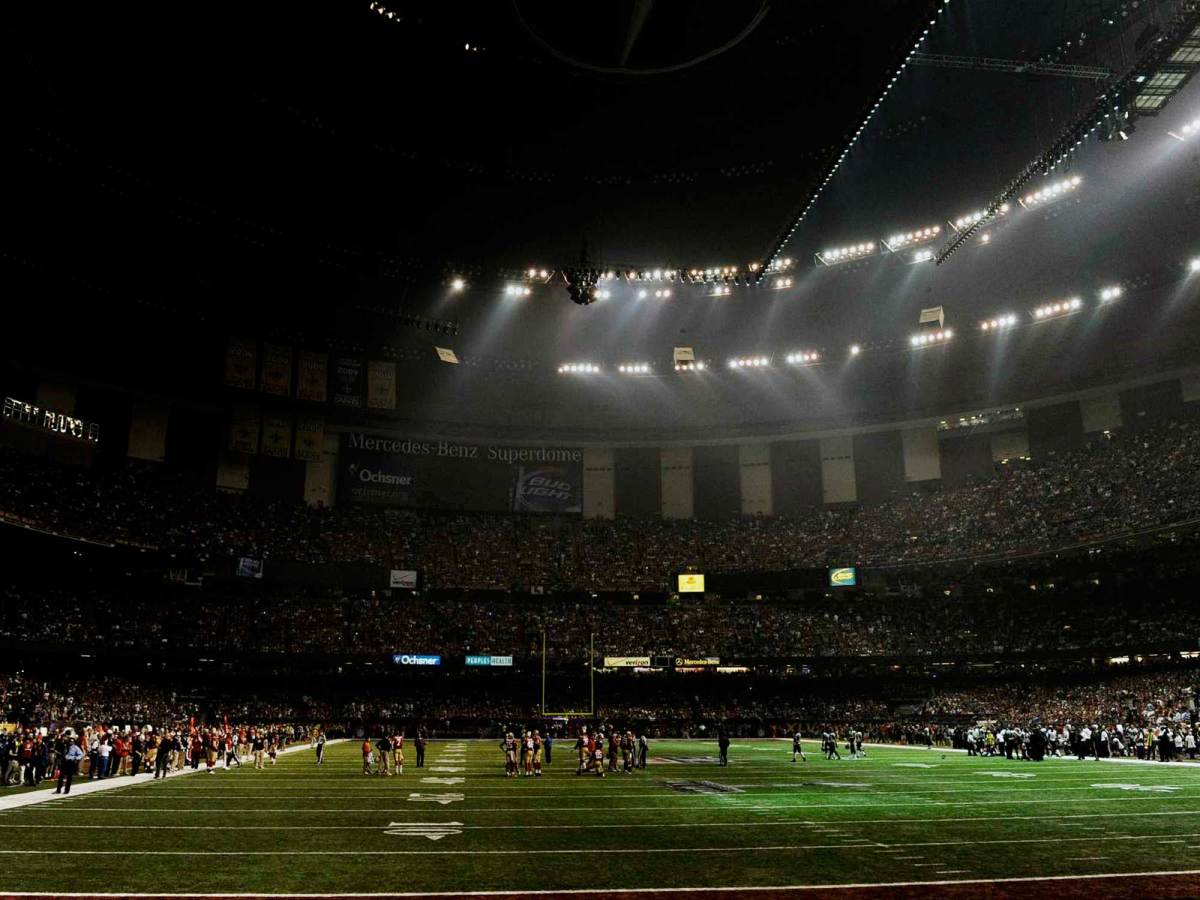
The New Orleans Superdome sits in darkness after the lights went out in the second half of the 49ers-Ravens Super Bowl. San Francisco mounted a second-half comeback after the lights flickered on but fell short of Baltimore, 34-31.
Super Bowl XVI, Jan. 24, 1982

San Francisco 49ers tight end Charles Young hangs on to a pass while being sandwiched between linebacker Jim LeClair and another Cincinnati Bengals defender. Young's grab went for a gain of 14 yards and helped set up the 49ers' first score in their 26-21 victory.
Super Bowl XVII, Jan. 30, 1983
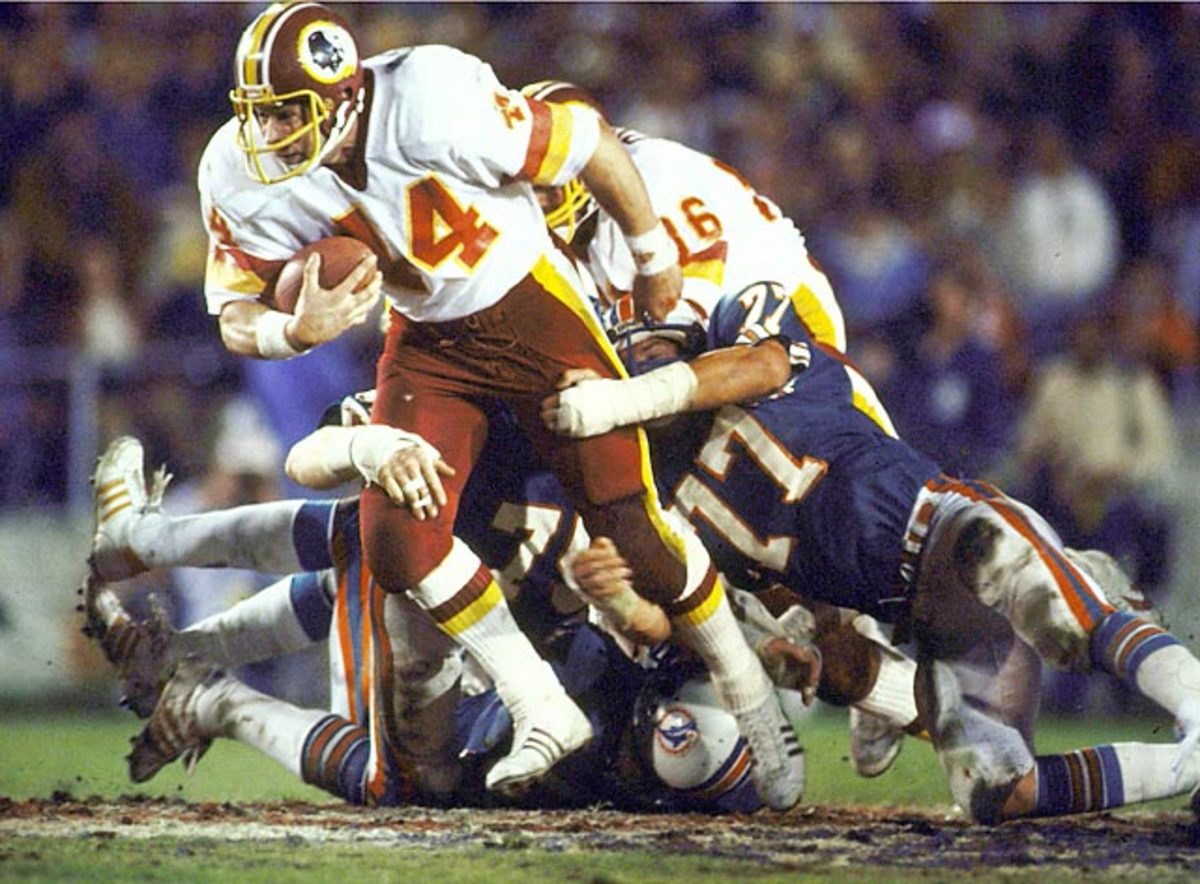
Washington Redskins running back John Riggins powers his way through Miami Dolphins tacklers. Riggins outgained the entire Miami offense with 181 total yards, 166 of them on the ground in the 27-17 win. With his team trailing 17-13 in the fourth quarter, Riggins came up huge on a crucial fourth-and-one, taking the ball 43 yards to the end zone.
Super Bowl V, Jan. 17, 1971

Baltimore Colts rookie kicker Jim O'Brien boots a game-winning field goal with five seconds left over the outstretched arms of the Dallas Cowboys rush. O'Brien's field goal delivered the championship to Baltimore and broke a 13-13 tie.
Super Bowl VII, Jan. 14, 1973

The Miami Dolphins carry head coach Don Shula off the field after defeating the Washington Redskins 14-7. The win capped off the Dolphins' undefeated season, still unmatched in NFL history, and gave Shula his first Super Bowl victory after losing Super Bowls III and VI.
Super Bowl XXV, Jan. 27, 1991

Defensive back Everson Walls basks in the triumph after his New York Giants' 20-19 win over the Buffalo Bills. The Giants overcame a 12-3 deficit to claim the only Super Bowl decided by one point.
Super Bowl XIV, Jan. 20, 1980

Pittsburgh Steelers defensive tackle Joe Greene leaps as Los Angeles Rams quarterback Vince Ferragamo attempts to get a pass off. Mean Joe starred in his famous Coca-Cola ad during the commercials of the game, a 31-19 Steelers victory.
Super Bowl LII, Feb. 4, 2018
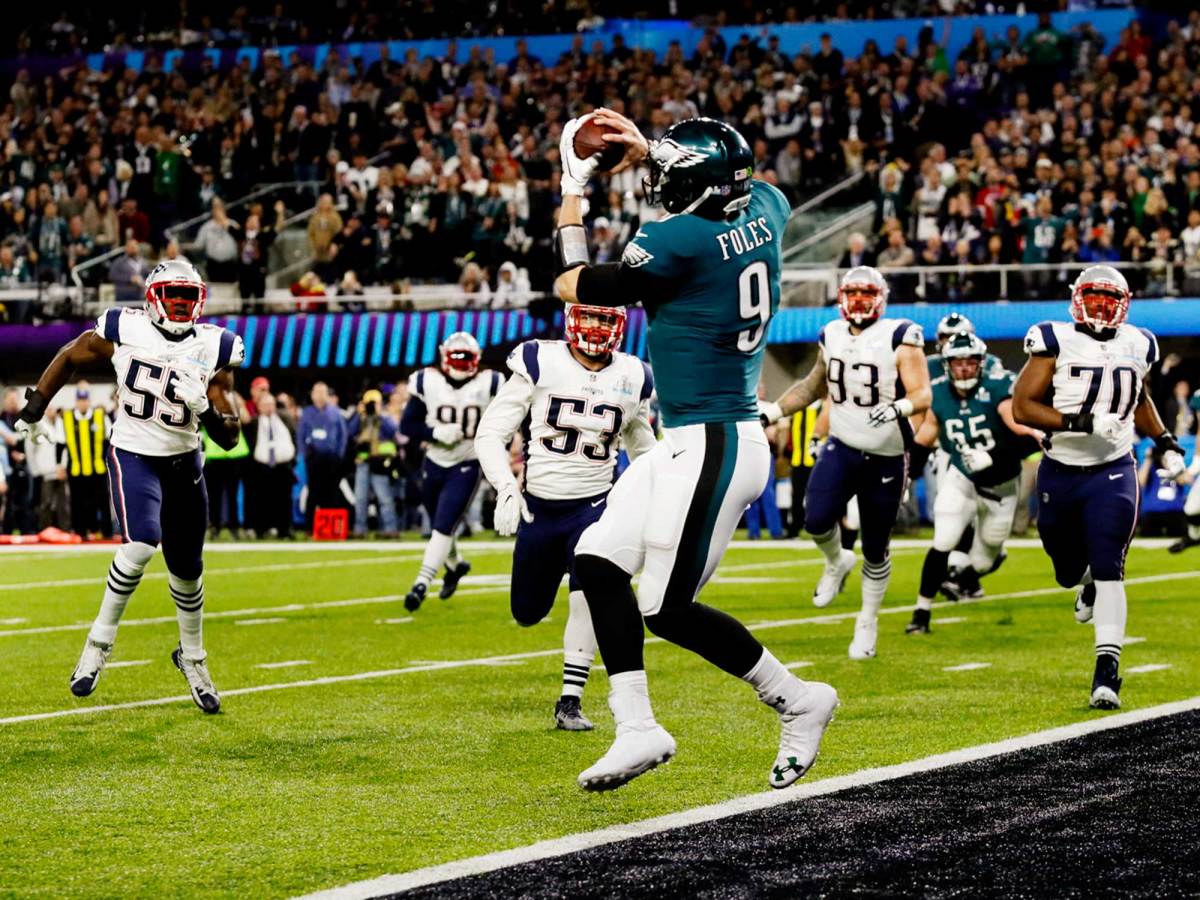
Philadelphia Eagles quarterback Nick Foles wraps his hands around a touchdown pass against the New England Patriots. The Eagles won, 41-33, with the Foles trick play touchdown remembered by the play name "Philly Special."
Super Bowl XXXVII, Jan. 26, 2003
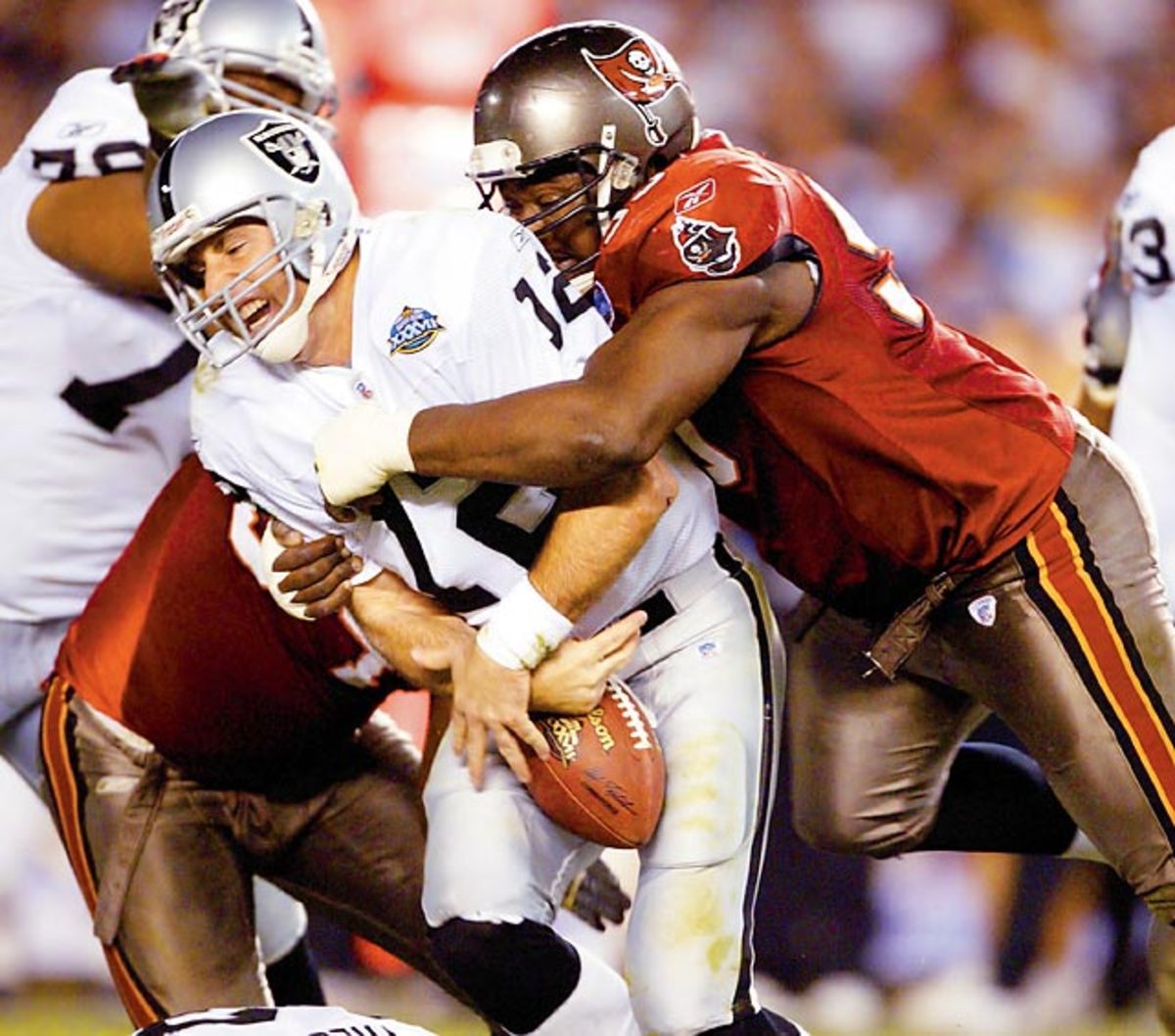
Tampa Bay defensive tackle Warren Sapp brings down Oakland quarterback Rich Gannon and jars the ball free for a fumble. Although the Raiders recovered the fumble, the Buccaneers' defense controlled the game, scoring three touchdowns on interception returns. Those touchdowns helped Tampa Bay easily prevail 48-21.
Super Bowl XVII, Jan. 30, 1983
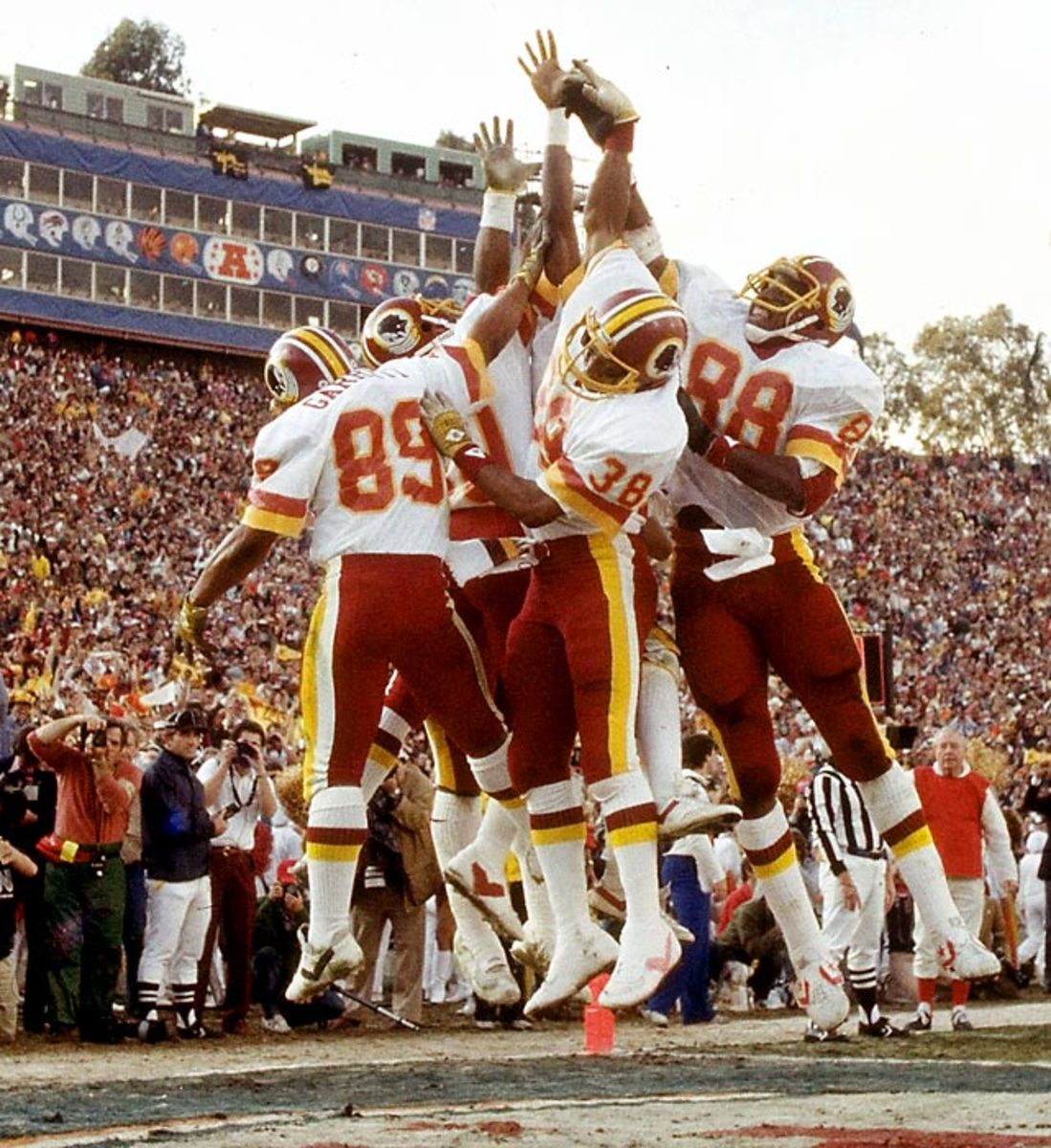
The Smurfs of the Washington Redskins celebrate after a touchdown. Washington scored 17 consecutive points in the second half to defeat the Miami Dolphins 27-17.
Super Bowl XXXVIII, Feb. 1, 2004

New England Patriots quarterback Tom Brady throws a pass as Carolina Panthers linebacker Dan Morgan advances toward him. Brady was named Super Bowl MVP after completing 32 of 48 passes for 354 yards and three touchdowns in the 32-29 win.
Super Bowl XXXII, Jan. 25, 1998

Denver Broncos quarterback John Elway gets helicoptered on a third-down hit by Green Bay Packers safeties LeRoy Butler and Mike Prior. Despite the big hit, Elway picked up a first down on the play, keeping Denver's drive alive for a later Terrell Davis touchdown. That touchdown drive proved crucial in the Broncos' hard-fought 31-24 win.
Super Bowl IV, Jan. 11, 1970

Kansas City Chiefs quarterback Len Dawson throws a pass against the Minnesota Vikings in the last meeting of AFL and NFL champions before the two leagues merged after the season. Dawson earned Super Bowl MVP honors after completing 12 of 17 passes for 142 yards and a touchdown in Kansas City's 23-7 victory.
Super Bowl XLI, Feb. 4, 2007
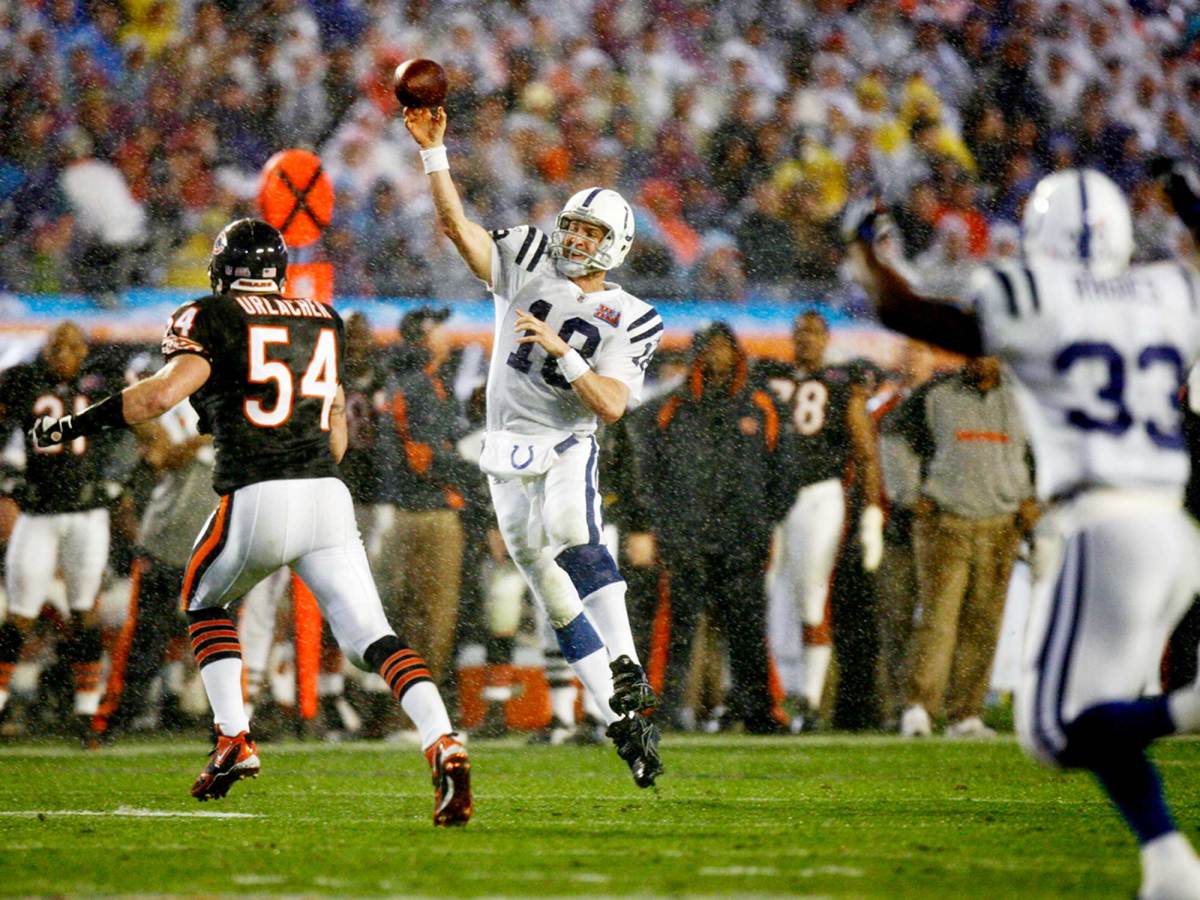
Indianapolis Colts quarterback Peyton Manning unleashes a pass through the rain at Dolphin Stadium in Miami Gardens, Florida
Super Bowl IX, Jan. 12, 1975

Pittsburgh Steelers fullback Franco Harris sprints away from the Minnesota Vikings defense on a carry. Harris set a Super Bowl record with 158 rushing yards as he earned Super Bowl MVP honors in the Steelers' 16-6 victory.
Super Bowl XIII, Jan. 21, 1979

Pittsburgh Steelers quarterback Terry Bradshaw scrambles away from the Dallas Cowboys defense before tossing a touchdown pass to Rocky Bleier. Led by Bradshaw's 318 passing yards and four touchdowns, the Steelers won in a shootout, beating the Cowboys 35-31. Dallas is the only team to score 30 or more points and lose a Super Bowl.
Super Bowl XIX, Jan. 20, 1985

Miami Dolphins running back Tony Nathan dives on top the San Francisco 49ers defense. Nathan had limited success running the ball in the 38-16 loss, gaining just 18 yards on the ground. He did pick up 83 receiving yards on 10 catches.
Super Bowl XXVI, Jan. 26, 1992

Washington Redskins quarterback Mark Rypien tosses a pass against the Buffalo Bills. Rypien earned Super Bowl MVP honors by throwing for 292 yards and two touchdowns on 18-of-33 passing in the Redskins' 37-24 win.
Super Bowl XLVII, Feb. 13, 2013
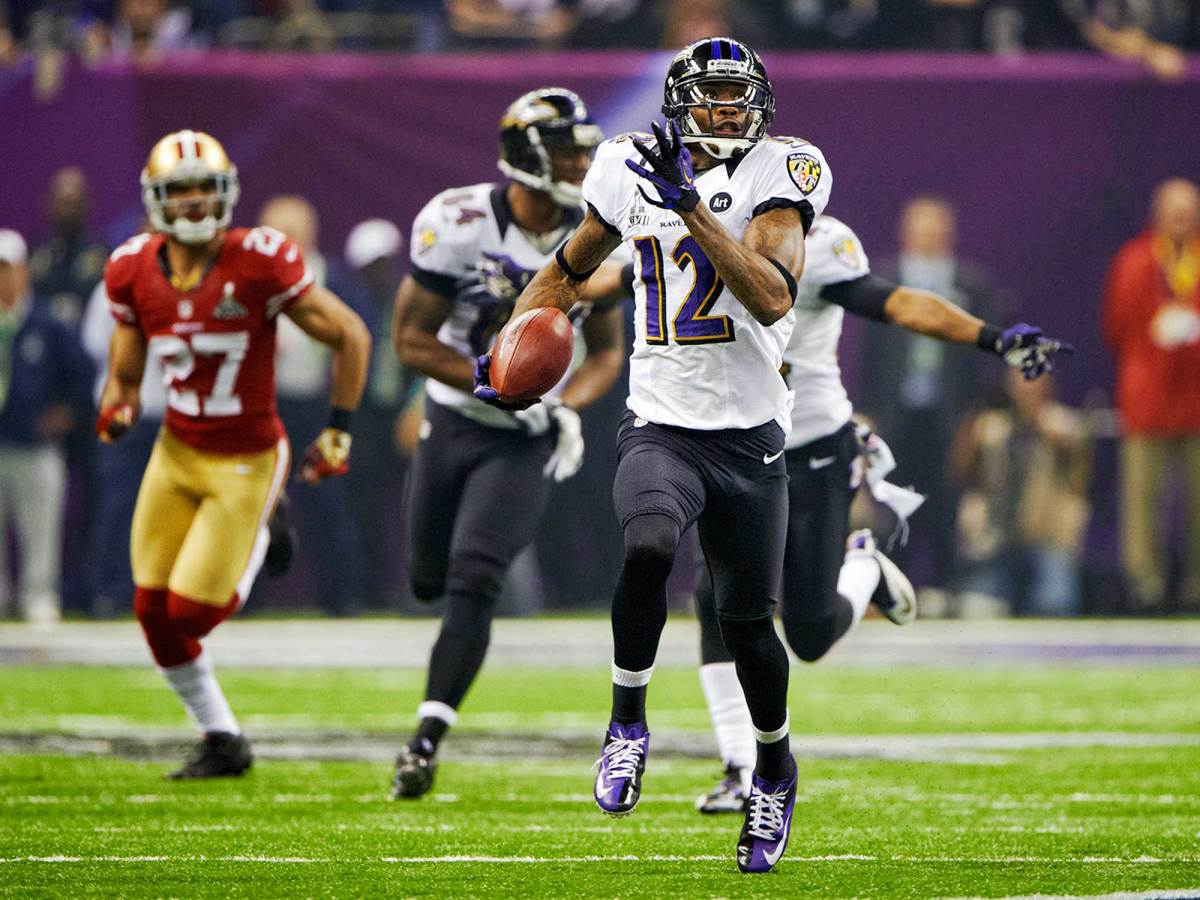
Baltimore Ravens wide receiver Jacoby Jones returns the second-half kickoff for a 108-yard touchdown against the San Francisco 49ers. Despite a late 49ers comeback, the Ravens held on to win 34-31 at the Mercedes-Benz Superdome.
Super Bowl XXXVII, Jan. 26, 2003

Tampa Bay Buccaneers wide receiver Joe Jurevicius extends a stiff arm at cornerback Tory James in the Bucs 38-21 victory. Jurevicius led all receivers with 78 yards on four catches despite playing with the distraction of his infant son, who was born prematurely five days before the NFC Championship and eventually died in March 2003.
Super Bowl XXVII, Jan. 31, 1993

Dallas Cowboys running back Emmitt Smith escapes from Buffalo Bills safety Henry Jones at midfield. Smith led all rushers in the Cowboys 52-17 win, racking up 108 yards on the ground with a touchdown.
Super Bowl I, Jan 15. 1967

Jon Gilliam and Jerry Mays of the Kansas City Chiefs greet the Green Bay Packers' Willie Davis and Bob Skoronski at midfield before the start of the first Super Bowl. At the time the game was known as the First AFL-NFL World Championship Game or the Super game. It was the only Super Bowl to not sell out. Green Bay won 35-10.
Super Bowl VI, Jan. 16, 1972

Dallas Cowboys running back Calvin Hill attempts to leap over the pile but gets tackled by the Dolphins defense. The Cowboys dominated on the ground, rushing for a Super Bowl-record 252 yards en route to a 24-3 victory.
Super Bowl XXXV, Jan. 28, 2001

New York Giants cornerback Dave Thomas attempts to wrap up Jamal Lewis in the fourth quarter. The Baltimore Ravens' rookie running back gained 102 yards on the ground, becoming just the second rookie to rush for 100 yards in a Super Bowl. He also scored a fourth-quarter touchdown as the Ravens rolled to a 34-7 win.
Super Bowl XLVIII, Feb. 2, 2014
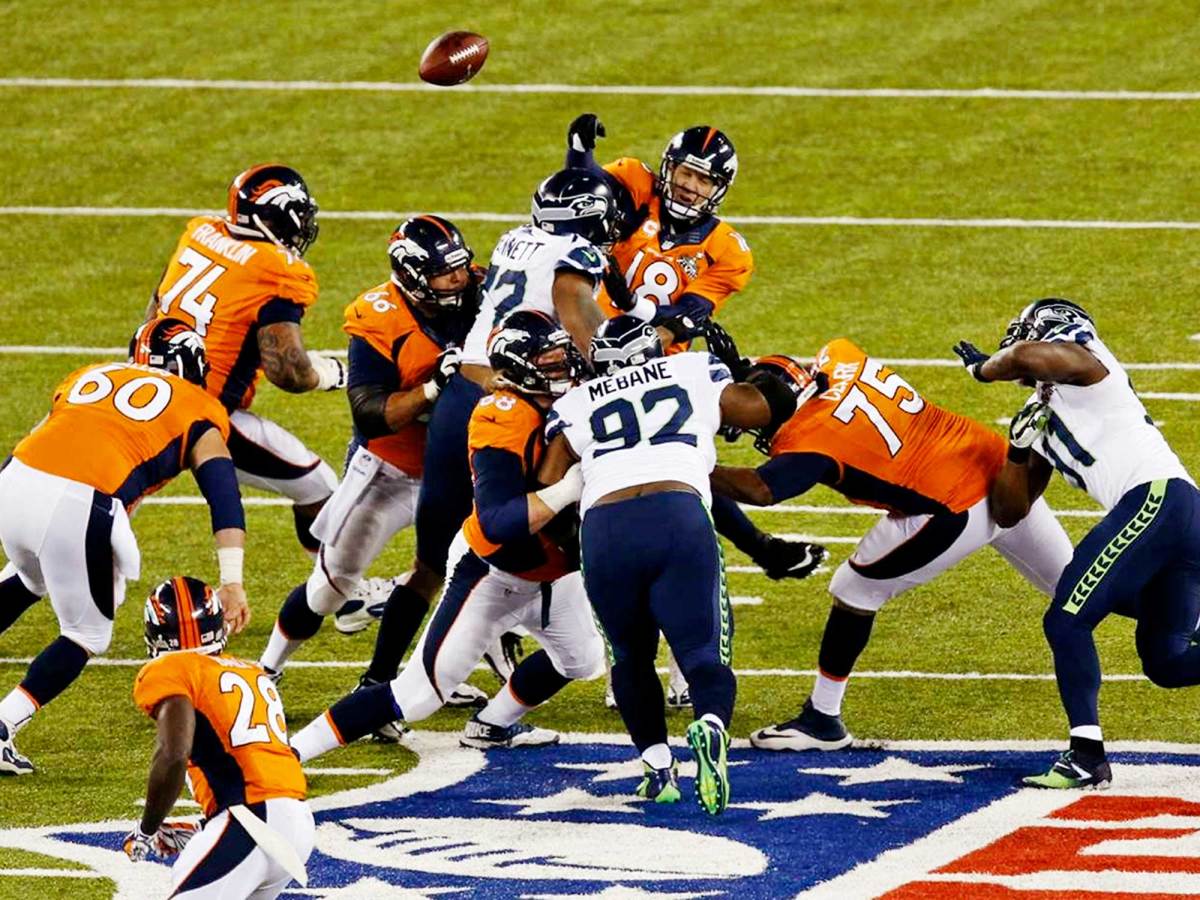
Denver Broncos quarterback Peyton Manning is crushed by the Seattle Seahawks defense as he lets go of a pass. The Seahawks demolished the Broncos, 43-8, to win their first Super Bowl title.
Super Bowl XLIV, Feb. 7, 2010

New Orleans Saints running back Pierre Thomas dives into the end zone in the third quarter. Thomas gained 85 total yards against the Indianapolis Colts, including 55 receiving yards on six catches in the 31-17 Saints' win.
Super Bowl XLV, Feb. 6, 2011

Green Bay Packers safety Nick Collins gets into the end zone to complete his interception return in the first quarter. Collins' pick was part of a hot start for the Packers against the Pittsburgh Steelers as Green Bay built leads of 14-0 and 21-3 before winning 31-25.
Super Bowl XXVIII, Jan. 30, 1994
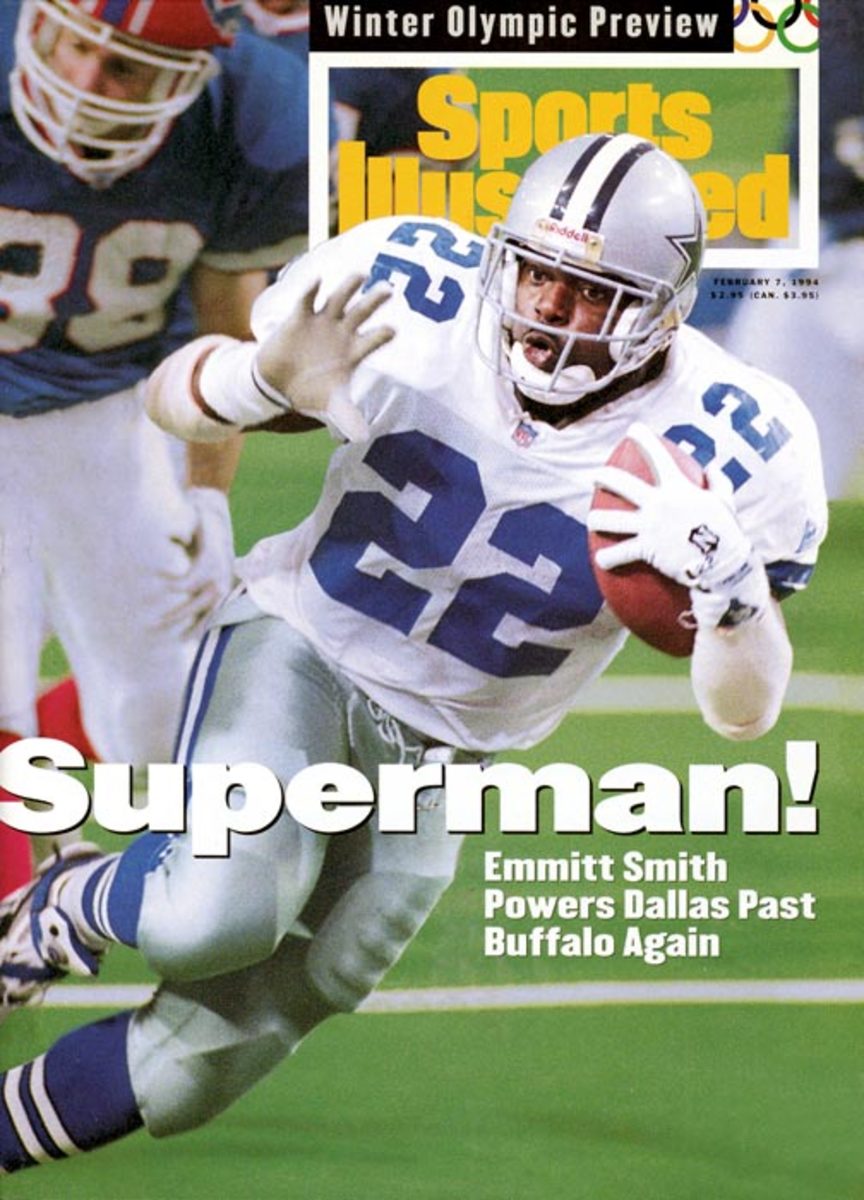
Emmitt Smith dominates the Buffalo Bills in a Super Bowl rematch, rushing for 132 yards and two touchdowns. Smith was named Super Bowl MVP as he and the Dallas Cowboys sent the Bills to their fourth straight Super Bowl defeat, 30-13.
Super Bowl XXXIX, Feb. 6, 2005

New England Patriots running back Kevin Faulk attempts to leap through a tackle in the second quarter. Faulk gained 65 total yards and had two catches and a rush that set up of the Patriots winning score in their 24-21 victory over the Philadelphia Eagles.
Super Bowl 50, Feb. 7, 2016
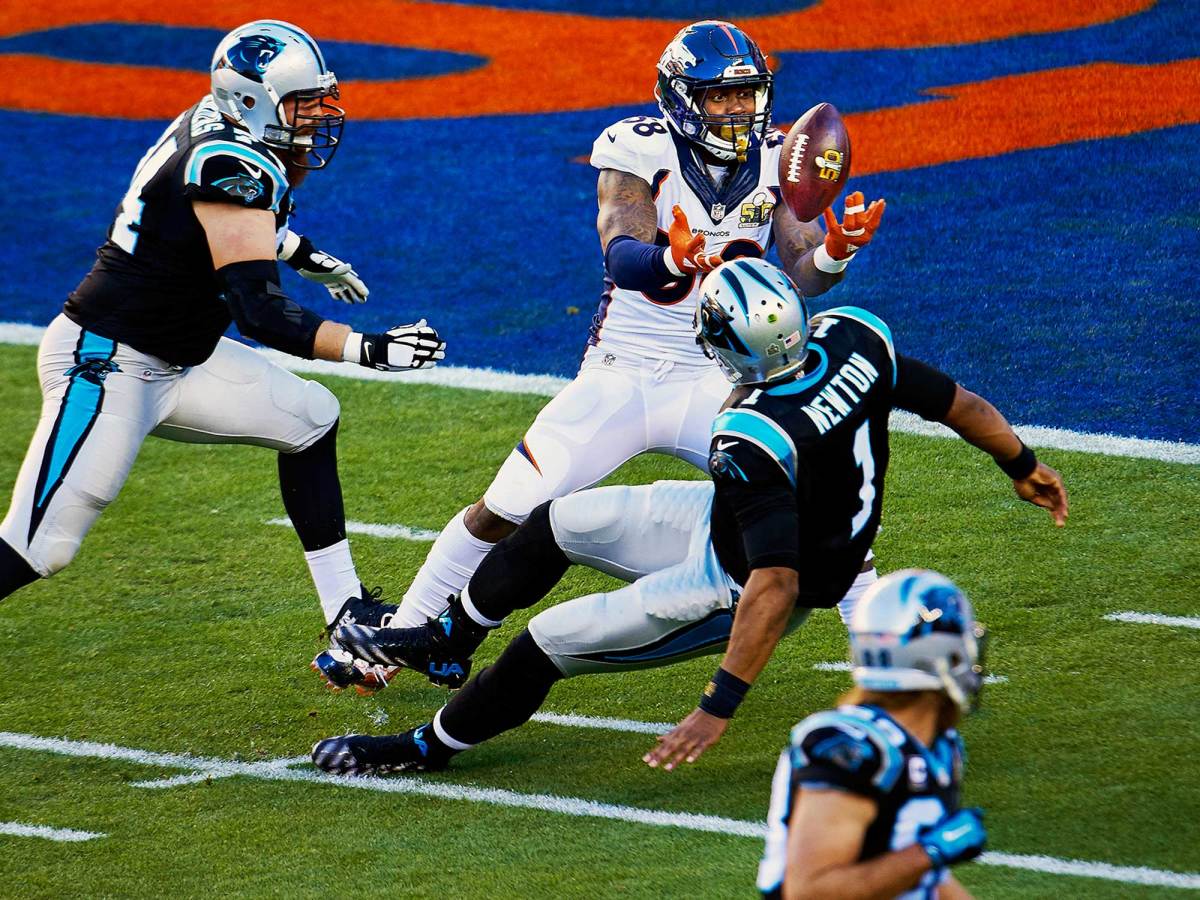
Denver Broncos linebacker Von Miller strips the ball from Carolina Panthers QB Cam Newton. Malik Jackson recovered the ball in the end zone for a Broncos touchdown. Denver topped Carolina, 24-10, at Levi's Stadium.
Super Bowl XL, Feb. 5, 2006

Ben Roethlisberger follows the block of running back Jerome Bettis for a one-yard touchdown run in the second quarter. The Steelers quarterback tossed two interceptions and didn't throw a touchdown, but Pittsburgh defeated the Seattle Seahawks 21-10.
Super Bowl XIX, Jan. 20, 1985

San Francisco 49ers running back Roger Craig rushes past a diving Miami Dolphins defender for a touchdown in his team's 38-16 win. Craig became the first player to score three touchdowns in a Super Bowl, catching two and rushing for a third.
Super Bowl XXXII, Jan. 25, 1998

Denver Broncos running back Terrell Davis rushes past Green Bay Packers linebacker Seth Joyner. Davis missed most of the second quarter with a migraine but still rushed for 157 yards with three touchdowns to earn Super Bowl MVP in Denver's 31-24 victory..
Super Bowl XLIX, Feb. 1, 2015
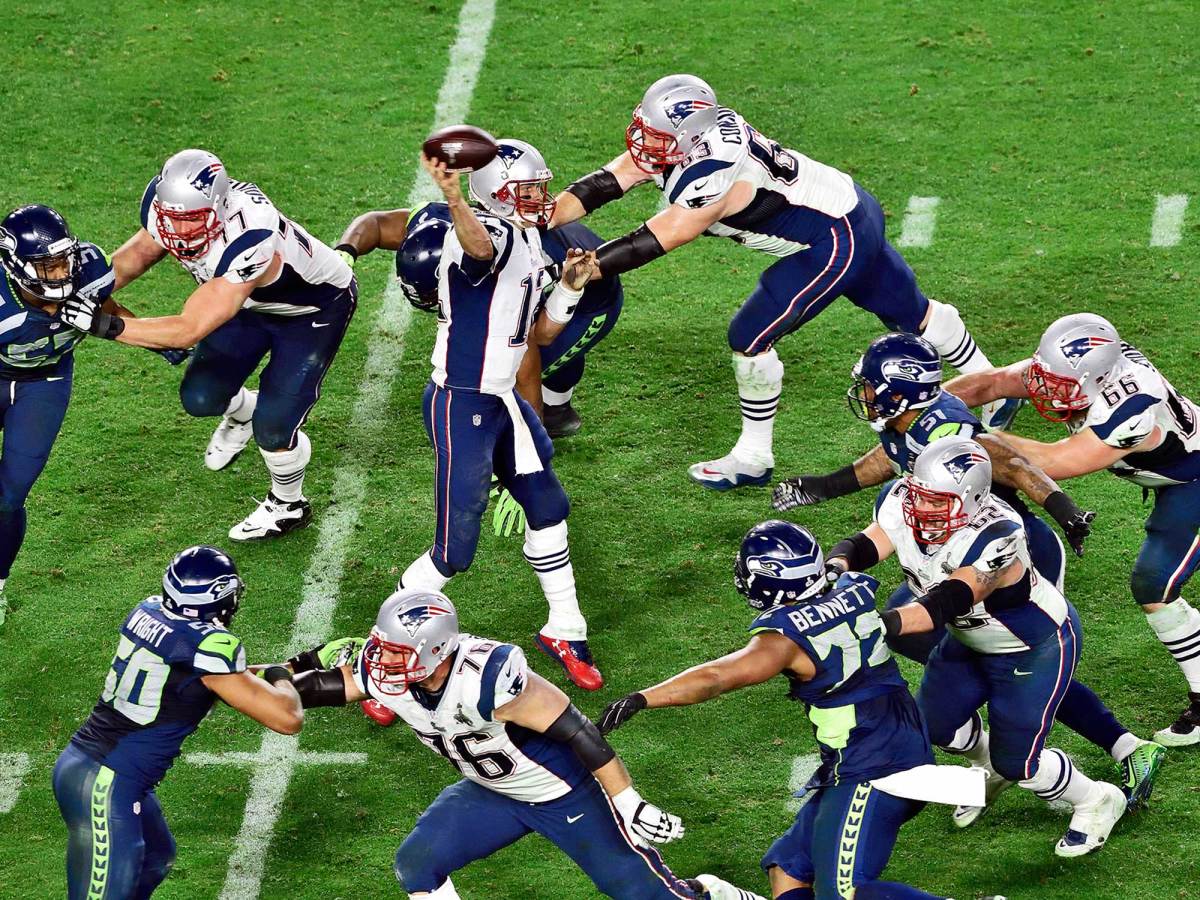
New England Patriots quarterback Tom Brady fires a pass as Seattle Seahawks defenders swirl around him. The Patriots won the game in the final seconds on a goal-line interception by Malcolm Butler.
Super Bowl XXX, Jan. 28, 1996
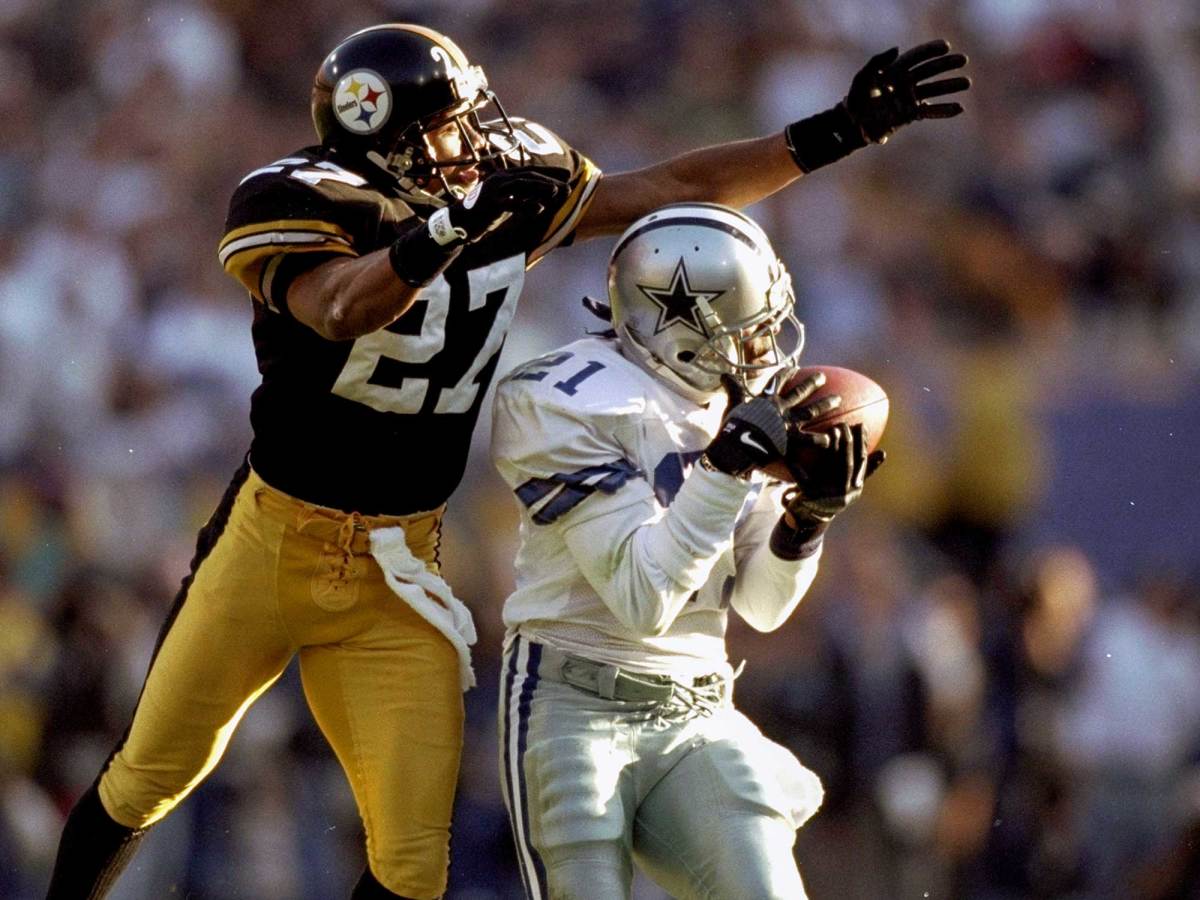
Deion Sanders of the Cowboys hauls in a pass with the Steelers' Willie Williams towering over him. The Cowboys edged the Steelers, 27-17, at Sun Devil Stadium.
[pagebreak]
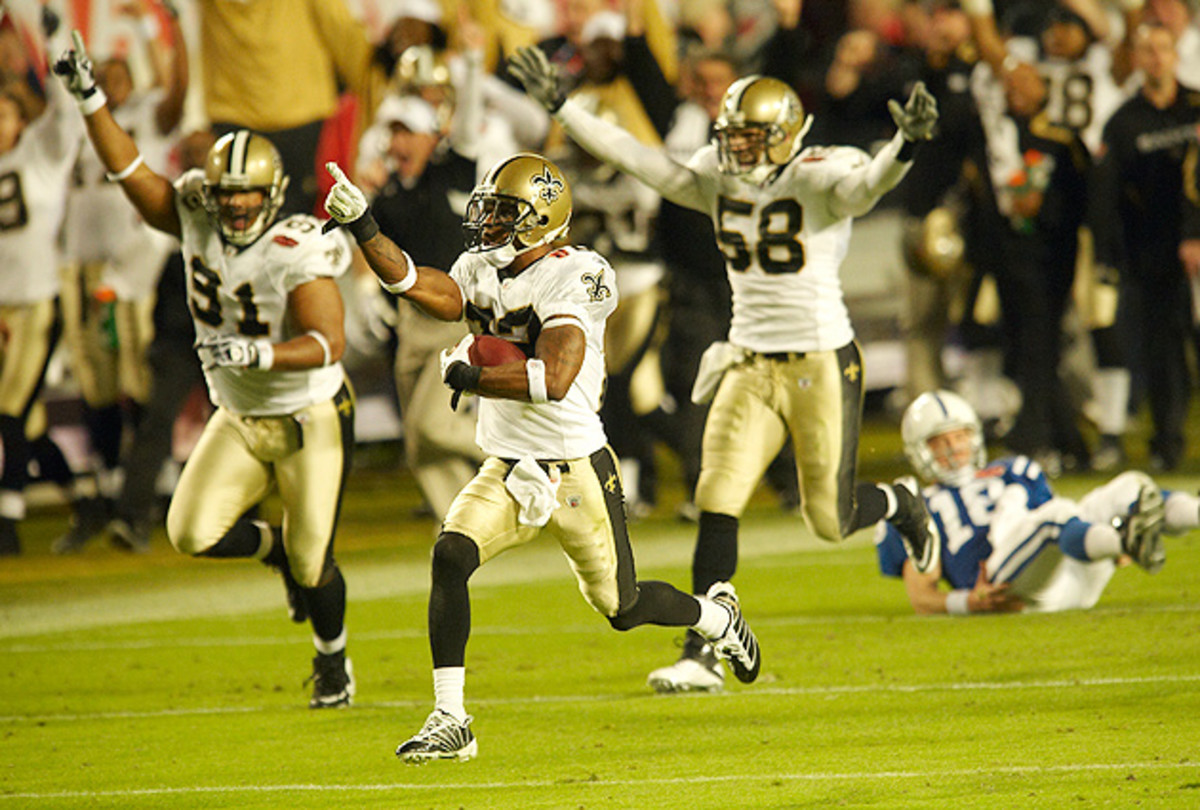
The Pick-Six: Tracy Porter, Super Bowl XLIV, New Orleans 31, Indianapolis 17
Visualization is often a big part of an athlete’s success, and the ability to see it before you do it has been credited as the origin for many pivotal plays and moments. But second-year Saints cornerback Tracy Porter really had seen it before he did it, because he and his fellow New Orleans defensive backs had discovered something in the midst of an impromptu film study session on Wednesday of Super Bowl week in early 2010. Their opponents, the Indianapolis Colts, loved to run this one particular pass play to receiver Reggie Wayne out of the same alignment on third-and-mediums.
The more Porter studied that week, the more he felt certain he would be able to recognize the formation and react accordingly if the situation presented itself in the Super Bowl. Naturally it did, giving Porter one of those wonderful preparation-meets-opportunity moments, in the NFL’s spotlight game of the season, no less.
NFL draft redux: Reprojecting the first round of the 2014 draft
The situation: Trailing 24-17 with under four minutes to play, the favored Colts are driving for the game-tying score, but face a third-and-5 from the Saints 31. Having once led the game 10-0 after the first quarter, the pressure is starting to build for Indianapolis and especially quarterback Peyton Manning, whose postseason struggles have been well-documented. But this game was billed as a legacy game for Manning, presenting the opportunity to win his second Super Bowl in a four-season span and join the select club of repeat ring winners.
Then Porter happened. Jumping the short hitch route to Wayne out of the slot that he had watched on tape all week, Porter intercepted Manning's pass at the Saints 26 and streaked 74 yards into the end zone, giving New Orleans a 31-17 lead with 3:12 left and all but starting the party on Bourbon Street. For Porter, it was a storybook moment of triumph, with him having grown up a Saints fan in Louisiana and starring at Indiana University, in the same state Manning and the Colts called home.
"We went over the play so much that I had it embedded in my mind," said Porter, a second-round draft pick in 2008. "Once you see something over and over again, it kind of becomes part of you. I made that play because we ran it a few times in practice, and we knew it was a third-down staple for those guys. I made that play in practice, [fellow Saints cornerback] Jabari Greer made the play in practice, a bunch of guys were able to make that play in practice because we saw it so much.
"Once it happened in the game and they came out in that formation, my mind was made up. I was like, OK, this is the play. This is what they’re about to run. I know what’s about to happen, and I know what I’ve got to do. So there’s no need for me to take any steps back. I’m going to sit here and wait for them to run this route and I’m going to make a play on the ball and be gone to the end zone."
Porter saw it, he thought it, and then he did it, adding his name forever to Saints lore. And what a playoff run he had in 2009, first intercepting Minnesota’s Brett Favre to force overtime in New Orleans’ thrilling NFC title game win over the Vikings, and then capping the Saints’ 25-point second-half showing in their upset of the Colts in the Super Bowl, giving the franchise its first and only championship.
"To be honest, it didn’t register until after the Super Bowl and we were celebrating on the field, what I had really done," said Porter, now with Washington, after playing with Denver and Manning in 2012, and Oakland in 2013. "One of my teammates, and I’m not even sure which one it was at that moment, he ran up and we hugged and congratulated each other and one of the things he said was, 'Man, you just picked Peyton Manning and took him to the house.' I kind of sat back and thought about it, and I’m like, 'You know what, you’re right.' And to get him and Brett Favre in the same year, that was big.
"Any time I come home for whatever reason, and I’m back in New Orleans or anywhere in Louisiana, people recognize me and they’re going to bring that play up. They’re like, 'Thanks for the pick. Thanks for giving us the Super Bowl. We miss you in New Orleans. We wish you were still here.'"
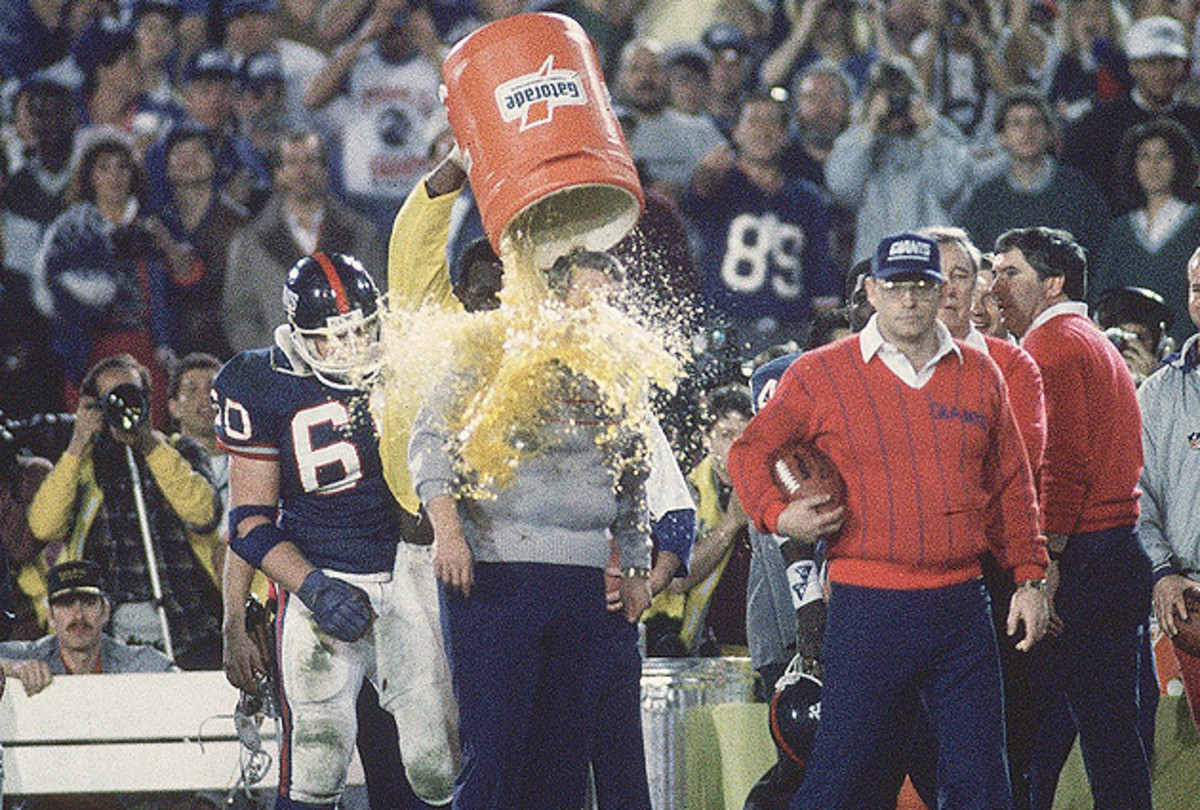
The Dousing: Harry Carson, Super Bowl XXI: N.Y. Giants 39, Denver 20
What? You think linebacker Harry Carson didn’t change the game on the lone Super Bowl Sunday of his well-decorated 13-year NFL career? Please. Carson was a nine-time Pro Bowl selection and a key member of the Giants’ first Super Bowl championship team in 1986. But he only became iconic when he was the first player with enough moxie to dump the contents of a Gatorade bucket over the head of the Super Bowl-winning head coach -- in this case, the all-business Bill Parcells, in the waning moments of New York’s 19-point thrashing of the Broncos in Pasadena’s Rose Bowl in early 1987.
Carson’s teammate, Giants defensive tackle Jim Burt, is often credited with dreaming up the Gatorade bath for Parcells in the 1985 regular season. More recent evidence has been uncovered that the 1984 Chicago Bears were actually the first to execute the move, with defensive stars Dan Hampton, Mike Singletary and Steve McMichael conspiring to surprise head coach Mike Ditka with the sudden shower upon clinching the NFC Central title that season. But it was Carson who ensured the now-ritualistic dumping would take its rightful place in American pop culture when he decided to keep Burt’s brainstorm alive as a game-ending staple of each and every Giants victory in 1986 on their way to the Super Bowl. For the record, Parcells took 17 such baths that glorious season, with the final one actually being two separate dumpings in the latter stages of the Giants’ rout of Denver.
"The truth is I almost forgot that day, because when you’re in the Super Bowl, and you’re dealing with all the hoopla of winning the biggest game and everyone is so thrilled about it, there’s a lot going on," said Carson, now 61. "But I had to do it, because it was something we perpetuated through the course of that season. What actually happened that a lot of people don’t notice is, in trying to figure out how I was going to get him, I asked a security guard for his jacket and he let me put it on. Then I snuck up and doused Parcells with a bucket of orange Gatorade.
"But if you look at some of the film, he was already wet in some of the pictures, because I got him with two buckets. It was Gatorade once, and then it was a whole bucket of water to rinse him off, so he wasn’t so sticky."
Carson has long acknowledged that once he started the dumpings after Giants wins in 1986, he was afraid to stop them, because Parcells was known to be almost pathologically superstitious and he feared incurring the wrath of his legendarily volatile head coach. And Carson saw no reason to tempt fate either, especially since New York fans soon began to make the Gatorade bath their favorite part of a Giants win. New York went 17-2 that season, including the playoffs.
"We were winning and I kept doing it," Carson said. "“Not necessarily because I wanted to, but I didn’t want to get out of that winning routine. It was our thing. It just sort of caught on. And we were trying to have fun with it. Everybody knew it was coming, but I was just trying to disguise it as best I could and make it fun."
The stunt became so wildly popular that soon TV analyst John Madden was comically diagraming Carson’s moves on his handy telestrator, and Carson was widely recognized as the father of the Gatorade bath, the sideline equivalent of Sammy Baugh popularizing the forward pass.
"I never thought about this thing going beyond Super Bowl XXI, because we did it that season, and then that was it," Carson said. "We didn’t do it any more in ’87 or ’88, and then I retired and I really didn’t think about it. You’d see other people doing it, but I looked at it as something Jim Burt thought up in the ’85 season, and then something we did that year in ’86, getting the coach with Gatorade. It was something that was really fun, but I never really thought it would continue to be so prominent.
"I still sign cards showing me dousing Parcells all the time at card shows. There are some people who only know me for doing the whole Gatorade thing. Parents will come to a signing with their kids, and kids will look at me like 'Who is this guy?' And the parents will say he played with the Giants a long time ago, back in ’86 when they won the Super Bowl and he did the whole Gatorade thing. And the kid will go, 'Oh!' So that has become part of my persona. The kids know me because I threw Gatorade on the coach, not necessarily what I did on the football field."
It’s a ritual that has crossed over into nearly every sport -- even the indoor NBA has had its celebratory coach dousings -- and become part of the landscape of high-profile victory celebrations. But Carson is still old school, and he thinks he and Parcells have never really seen the art form improved.
"My only thing is, if you’re going to get the coach with the Gatorade, you’ve got to do it right," he said. "You’ve got to get that bucket just right over his head and not give him a concussion or bang him in the head. And don’t get it down the back. You’ve got to get it on his head, and just let it linger a little bit. That’s what I did with Parcells. I emptied the entire bucket on his head, and he stood there and took the whole thing."
[pagebreak]
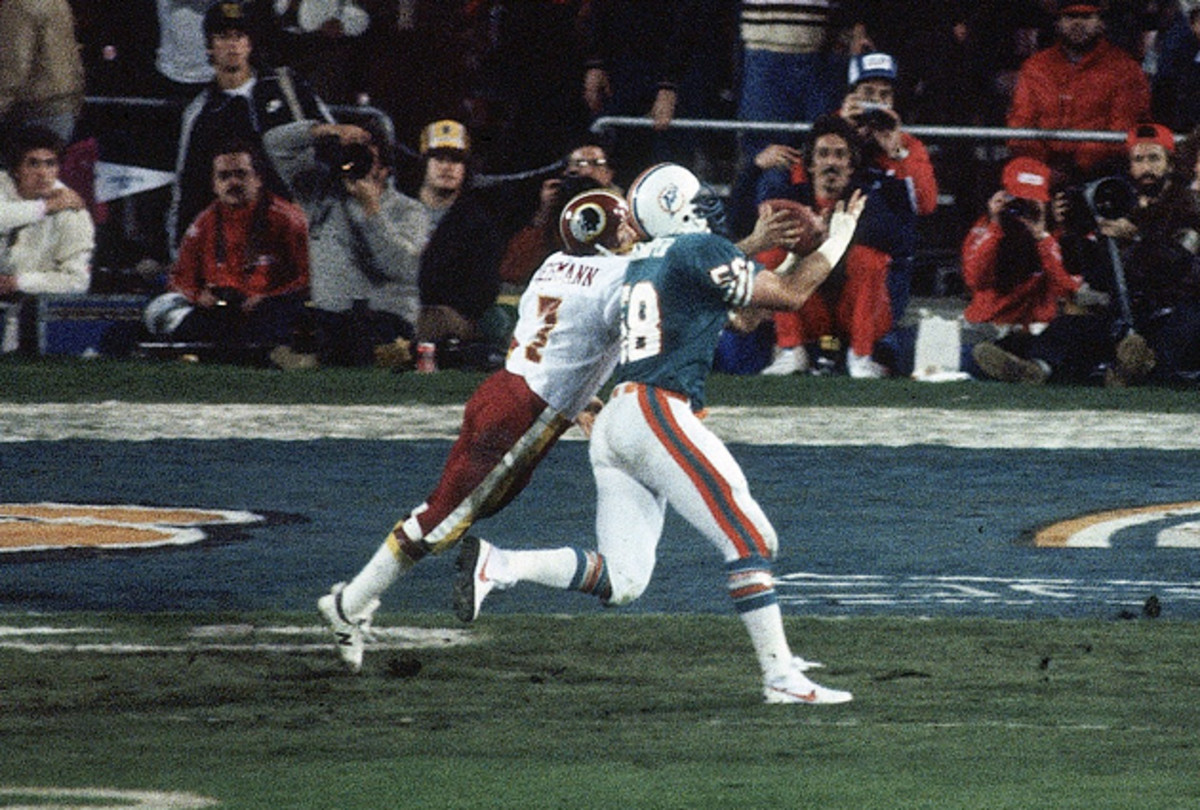
The Swat: Joe Theismann, Super Bowl XVII, Washington 27, Miami 17
There are always moments in a football game where the what-might-have-been factor looms large. Often they get glossed over in the final outcome of what actually transpired, but still, they play their part in a game that could have turned out far differently if events had unfolded another way. A game-changing play late in the third quarter of Washington’s first-ever Super Bowl victory illustrates how the football fates can so clearly turn in an instant.
Though thoroughly outplayed by Washington, the Dolphins led 17-13 with less than two minutes remaining in the third quarter, largely on the strength of two huge plays: a 76-yard Jimmy Cefalo touchdown reception in the first quarter and a then-Super Bowl-record 98-yard Fulton Walker kickoff return touchdown late in the first half. With Washington backed up deep in its own territory starting a drive at its own 5, the game hung in the balance.
On a first-and-10 play from the Washington 18, quarterback Joe Theismann looked to throw short to his right but found onrushing Miami linebacker A.J. Duhe -- who had already intercepted him earlier in the quarter -- in his way. Instead, Theismann wheeled to his left and fired, and very nearly threw the game away. Dolphins linebacker Kim Bokamper batted the pass high into the air and was in position to make an easy catch near the Washington end zone for a potential game-sealing touchdown when Theismann intervened.
"I didn’t really see Kim at all," Theismann, 65, recalled this week. "As I released the pass, he batted it up in the air. Truthfully, I’m sure everyone has had a moment where things go into slow motion for you. And as I looked at the ball I could read the 'Wilson' on it, and you could see the laces on it, it was that dramatic a moment. As the ball is spinning in the air, I see Kim start to run for it, and I know I can’t get there running, because I feel like my legs are in lead.
"So I just felt like if I could dive where his hands were going to be, and get my hand in between them and the ball, I’d be able to hopefully knock the ball away. And it just so happened that the timing worked out in such a fashion that I was able to lunge and get it done. But, boy, as I sat there in that end zone, I just took a deep breath and said, 'Well, that was a close one.'"
Theismann’s split-second savvy decision to play the defender on Bokamper’s near pick-six saved the day for Washington. Instead of the Dolphins leading 24-13, with Washington down two scores and facing a stout Miami defense that had registered a 14-0 shutout of the Jets in the AFC Championship Game the week before, Theismann and an offense built around the power running game of eventual game MVP John Riggins were still just a touchdown away from taking the lead.
They got that touchdown on their next possession, when quite famously, Riggins ran into Super Bowl history on his go-ahead 43-yard scoring burst on fourth-and-1 with 10:10 remaining. That trademark Riggins run -- I-Right 70 Chip -- gave Washington its first lead of the game, the only one it would need, and became the centerpiece of his Super Bowl record 166-yard rushing day on a whopping 38 carries. It looked like a comfortable 10-point win in the end for Washington, but in reality it was a narrow escape against a Don Shula-coached Dolphins team that had reached its first Super Bowl in nine years.
"That sequence on that play is one of my favorite moments in the game in my career, knocking the ball away in the Super Bowl," Theismann said. "Bokamper, he was stunned. He looked at me and gave me that 'You’ve got to be kidding' look. And I know we would not have been able to come back from that [interception]. We were a football team built on John’s ability to run the football behind our guys up front [the offensive line, dubbed 'The Hogs'] and that was our philosophy going in, we wanted to keep the game close and not get down by two scores.
"I don’t think we’re in position to utilize John’s skills and abilities if they score there. If we had to start throwing the football around, it wasn’t going to favor us having a chance to win, so that particular play at that time kept us within striking distance. It was just one of those, 'Wow, thank you,' moments."
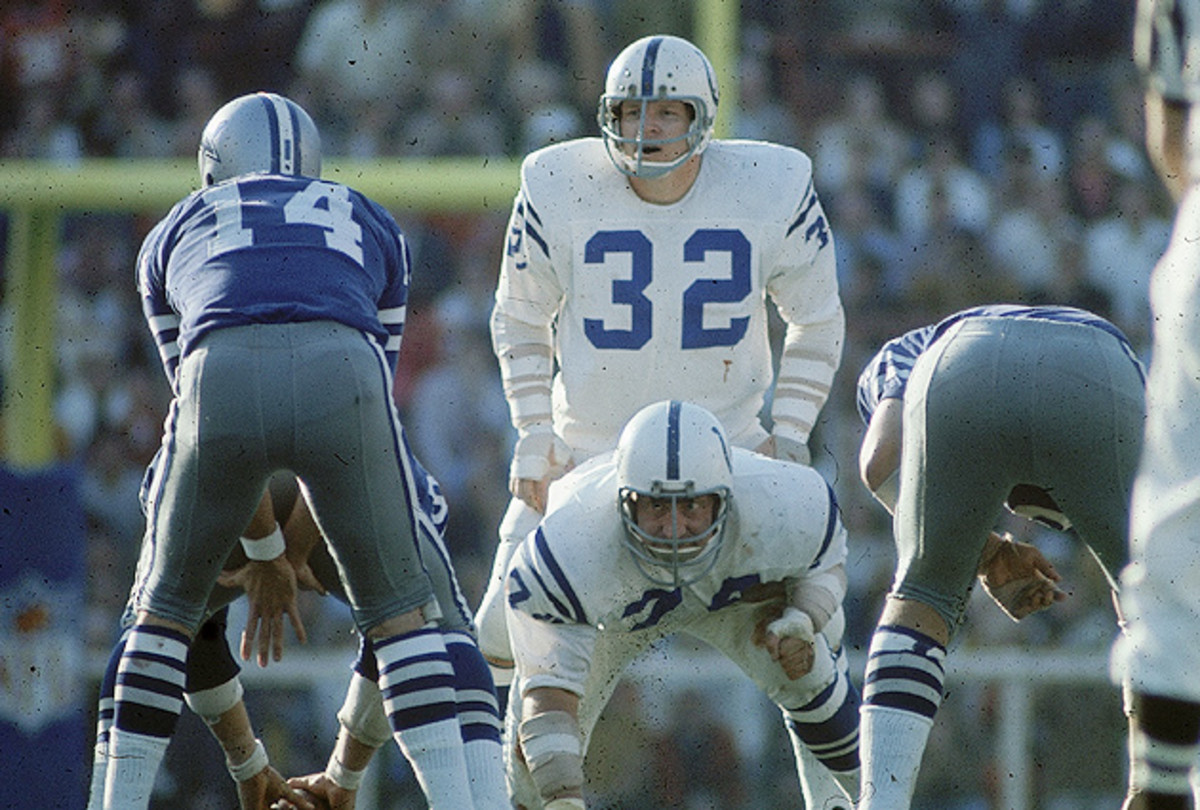
The Pick: Mike Curtis, Super Bowl V: Baltimore 16, Dallas 13
In the Super Bowl’s early era, there was no more indelible image than that of Baltimore rookie kicker Jim O’Brien jumping for joy, arms upraised, in the moments after his dramatic 32-yard field goal with five seconds remaining gave the Colts the game-winning points they needed to beat Dallas 16-13 in Super Bowl V at Miami’s Orange Bowl. It was by far the closest Super Bowl played to that point, and in terms of narrow finishes its three-point margin of victory wouldn’t be topped until the Giants edged the Bills 20-19 in Super Bowl XV, 20 years later.
But O’Brien would never have had his magical moment on the NFL’s grandest stage were it not for the perfect positioning of Baltimore middle linebacker Mike Curtis on the game’s most pivotal play. With a little more than a minute remaining in a 13-13 game strewn with turnovers (a record 11 combined) and penalties, Cowboys quarterback Craig Morton threw his second interception of the fourth quarter, sailing a second-and-35 pass high and off the hands of running back Dan Reeves -- straight into Curtis’ waiting arms.
A former collegiate fullback at Duke, Curtis was by then a Pro Bowl middle linebacker known for his nasty on-field disposition and physical style of play. Curtis gathered the ball in at the Dallas 41 and rumbled 13 yards to the Cowboys 28. With just 59 seconds left in the first post-merger Super Bowl matching an NFC and AFC champion, the Colts were in business, already in field goal range.
"It kind of bounced off Reeves' hands, and fortunately I just happened to be behind him," said Curtis, now 71 and living at least part of the year near St. Petersburg Beach, Fla. "I lucked out there. I was thinking I just wanted to make sure the pass wasn’t completed, and the next thing I know I’m running with the ball. All I had to do was intercept the ball and run it back as far as I could without fumbling it. I wasn’t trying to be a running back again, I just tried to avoid any major contact to make sure I protected the ball."
The Colts called two running plays that picked up three yards to the 25, then called on O’Brien, the part-time receiver who wore No. 80 and also handled Baltimore’s kicking duties. He had already missed a 52-yard field goal earlier in the game and also had his first point-after attempt blocked by the Cowboys. When O’Brien knocked it through the uprights, the celebration began in what was a cathartic victory for a veteran-laden Colts team that had found redemption two years and five days after their stunning 16-7 upset loss to the New York Jets in Super Bowl III, played in the very same Orange Bowl.
"The truth is, that Super Bowl III disappointment significantly meant more than the joy I got out of winning Super Bowl V," Curtis said. "We should have never lost that game to the Jets. We were so much the better team. But I think we took it too lightly, and the Jets maximized their ability that day, while we didn’t play up to our potential. To some degree, beating Dallas helped erase that memory. But I remember, after we lost to the Jets, I went and hid out that night after that game."
Curtis and the Colts didn’t need to hide after besting the Cowboys, somehow winning despite committing seven turnovers in a game Sports Illustrated dubbed the "Blunder Bowl." Baltimore was the champion of pro football for the first time since 1959, and Curtis made the game-breaking play that doomed Dallas to yet another agonizing near-miss.
[pagebreak]
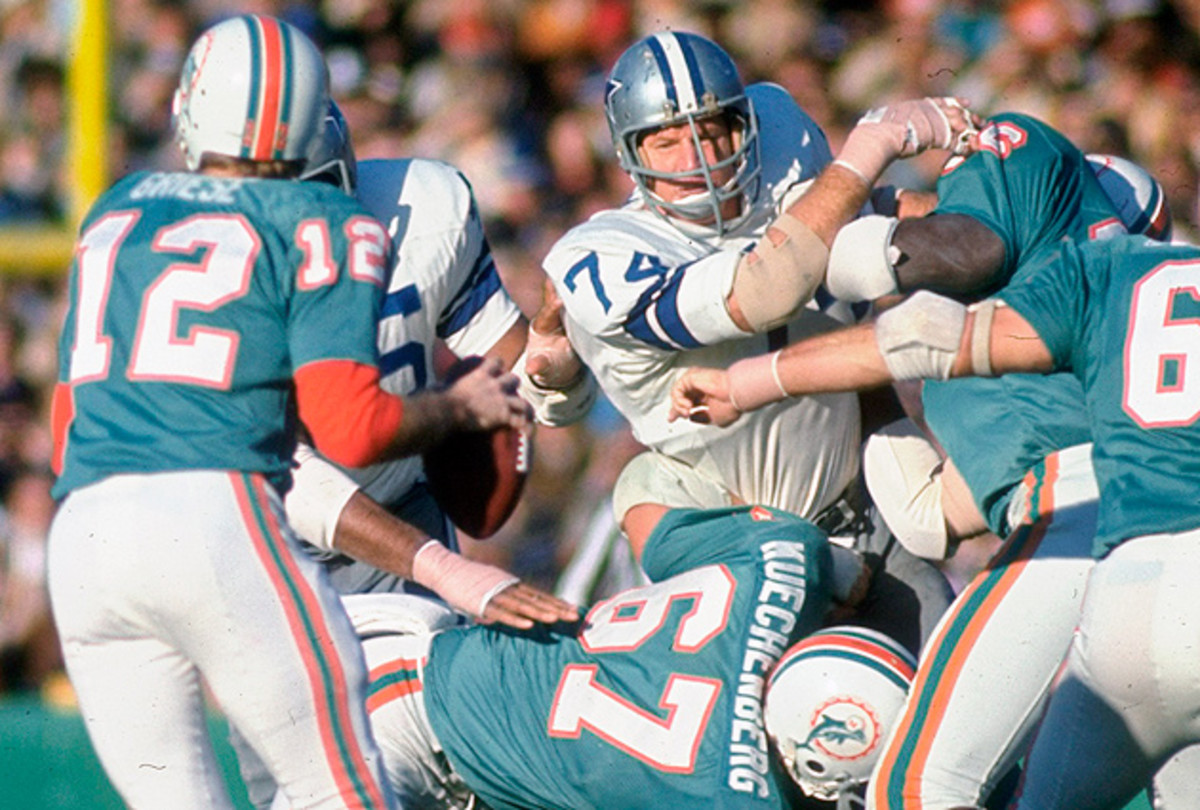
The Sack: Bob Lilly, Super Bowl VI, Dallas 24, Miami 3
The previous year's Super Bowl, Bob Lilly had gotten some impressive distance attached to his name when he threw his helmet into orbit in a fit of postgame frustration after watching his Cowboys throw three fourth-quarter interceptions and lose 16-13 to the Colts on a last-second field goal in Super Bowl V. "It went 43 yards, approximately," Lilly deadpanned.
But the following year, the number to know was 29 yards -- that was the actual length of Lilly’s game-changing sack of Miami quarterback Bob Griese in Super Bowl VI in New Orleans. It’s a mind-boggling distance, and it remains the longest negative play in Super Bowl history, with some believing it has to be the longest sack in any NFL game.
An oral history of the 1974 Steelers, the team that launched a dynasty
"It’s hard to believe you could even have a 29-yard sack, because it just doesn’t happen that way very often," said Lilly, the Hall of Fame Cowboys defensive tackle, from his home in Georgetown, Texas. "It was a play that felt like it took a very long time to unfold."
So did a Cowboys Super Bowl championship, but it finally arrived in January 1972, ending the string of near-misses that resulted in Dallas being derisively labeled "Next Year’s Champions" in the late 1960s. The signature play of that landmark Cowboys victory, a 24-3 beatdown of the Dolphins, was Lilly’s sack of Griese, which came on the final play of the first quarter, with Dallas leading 3-0.
Miami faced a third-and-9 from its own 38 on the play, and as Lilly recalls, the Cowboys coaches called for a double stunt by the four-man Dallas defense line. What resulted was either a colossal breakdown in blocking by Miami, or the supreme element of surprise by the Dallas defensive front, because both right defensive tackle Lilly and left end Larry Cole wound up streaking into the Dolphins backfield and disrupting Griese before he could even set up for a pass attempt.
"We were in there quickly, very quickly," said Lilly, 75. "Griese started backpedaling, looking downfield, trying to find the receiver, and there was really nowhere he could turn because Larry was to my left and I was on the right side and we had him kind of corralled. He kept turning and backpedaling and probably the only reason I caught him was because I was faster than Larry.
"We just took our time. I had been playing a long time and I knew there was nowhere to go for him, except down on the ground or throw the ball away, and really we didn’t want to let him throw the ball away. I wanted to keep him going backward, which we did, and we finally got him down."
Replays of the sack show Griese turning around three different times as he tried to escape, getting deeper and deeper into his own territory each time he changed direction. Finally surrendering to the sack, he wound up on his own 9-yard line, with the Dolphins punting on fourth-and-38 on the following play. The sack was emblematic of Miami’s offensive frustration that day, with the Cowboys limiting the Dolphins to just 185 yards and a field goal. Dallas is still the only team to hold an opponent without a touchdown in Super Bowl history.
Lilly played his entire career with Dallas, from 1961-74, and was one of the league’s most dominant defensive talents throughout his career, being named first-team All-Pro seven times and earning 11 Pro Bowl berths. But that star-studded 1971 team that featured nine eventual Hall of Fame players (and three more inductees from the coaching staff and front office) was his only turn to play on a league champion. Like he did Griese, Lilly chased that goal a long time, and he finally reached it.
"I was on a plane one time with Bob Griese, and he came up to me and said, 'How did you get me?' I said, 'Well, I had help, Bob.' And I said, 'Besides, I was faster than you were.' He’s a great guy, and was a great quarterback, and of course the next year they went 17-0 and never lost a game."
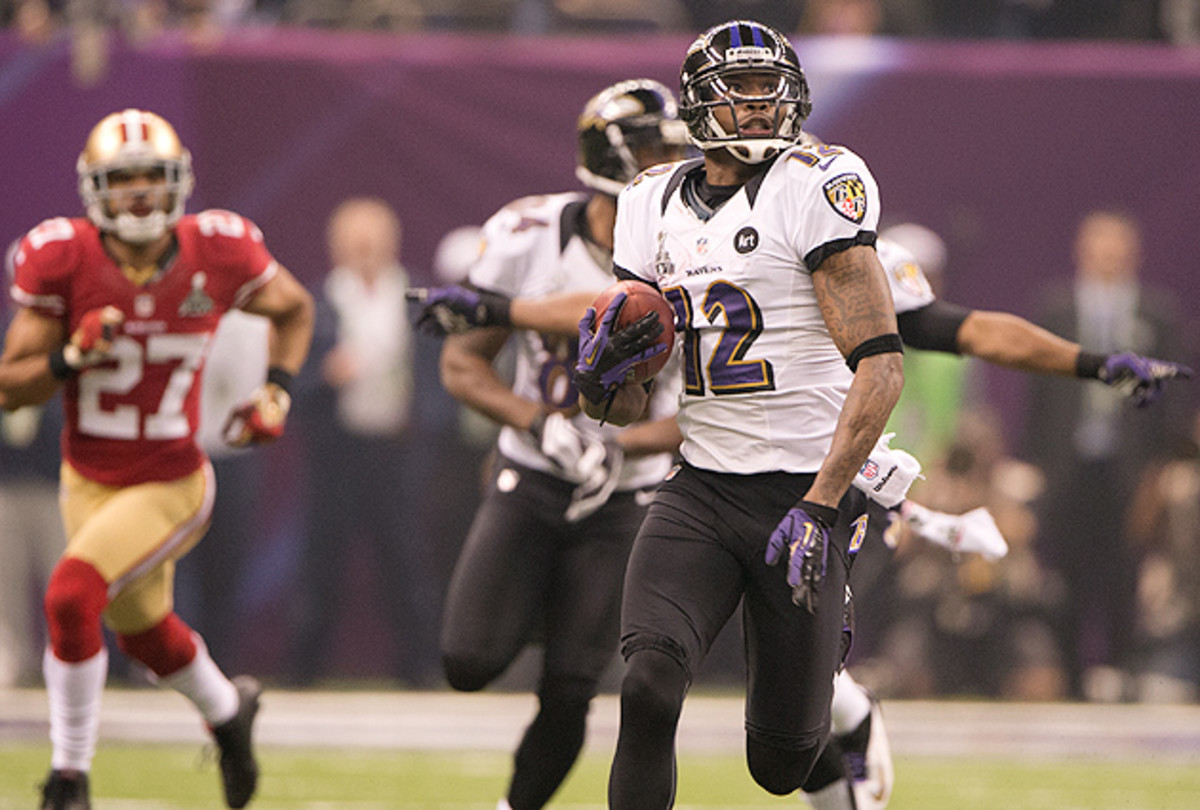
The Return: Jacoby Jones, Super Bowl XLVII, Baltimore 34, San Francisco 31
There was never a doubt, said Jacoby Jones. He was bringing it out. So when 49ers kicker David Akers drilled a line drive second-half kickoff to him, even eight yards deep in the Baltimore end zone, Jones caught it and set sail straight into Super Bowl history with his 108-yard kickoff return, easily the longest play recorded in both the Super Bowl and the NFL’s postseason.
The stunning return was initially ruled to be 109 yards -- which would have tied the longest play ever in the NFL -- but was later amended to 108 yards. No matter. Jones, playing in his first season with the Ravens as a receiver-return man, couldn’t have asked for a more thrilling game-changer than the play that electrified the Superdome crowd in New Orleans, which also happens to be his hometown.
"The week before the game, when we were practicing, and coach [John] Harbaugh put that play in, I was like, 'Hey, coach, that’s like a track meet for me. Straight ahead. It’s like a 100-meter dash.' I said, 'Can I come out?' And he said OK, so we worked on it the whole two weeks. And when something is drawn up, and then that’s just the way it happens, that’s scary. Oh my God.
"My whole mindset was I’m coming out. If I catch the ball, I’m running. In Baltimore, we have faith in the returner’s decision, and we live with it. I’d like for it to be 109 [yards], but I’ll take the 108, because I don’t think anybody can ever break it. Ever. It’ll never be broken."
Way-too-early top 100 rankings for 2015 fantasy football season
The shell-shocked 49ers never really had a chance to slow Jones down, with one would-be tackler getting just an arm on him around the 18-yard line, but by then he was flying near top speed and knew where this was headed.
"He swiped at me and missed, and then I saw daylight and it was like I was at a track meet," said Jones, who proceeded to watch his own record-breaking work on the dome’s JumboTron as he broke into the clear. "I didn’t start watching until I felt like I started digging enough, and then I looked up. I could see guys still chasing me, and I was like, 'Dang, they’re still behind me,' so then I really took off."
Jones took off all right, and his end-to-end gallop gave Baltimore what seemed to be a nearly insurmountable 28-6 lead just seconds into a second half made infamous by a Superdome power outage that delayed the game for 34 minutes in the third quarter. San Francisco staged a furious rally, but the Ravens wound up hanging on for that memorable 34-31 victory, which pitted the coaching Harbaugh brothers (John and the 49ers’ Jim) in an unprecedented family showdown.
Jones certainly did his part to give the Ravens a lead they would never relinquish, scoring on a 56-yard touchdown bomb late in the first half -- he caught the ball sliding to the turf at the 7, then got up and eluded two 49ers’ defensive backs on the way to the end zone -- and adding his dagger of a kickoff return to open the third quarter. He became the first player with a touchdown reception and kickoff return score in the same game in Super Bowl history and just the second player with two touchdowns of 50 yards or more in a Super Bowl, joining Washington’s Ricky Sanders in 1988.
And let’s not forget the end zone dances. Jones executed two different touchdown celebration dances that night, with the second being an impressive imitation of Ray Lewis’ well-known "squirrel" dance after the 108-yard kickoff return. Those moves helped Jones parlay his two touchdowns into a shot on "Dancing With The Stars" later that spring in 2013. Alas, while Jones and his Ravens rode high atop the NFL that year, he finished only third on the show.
